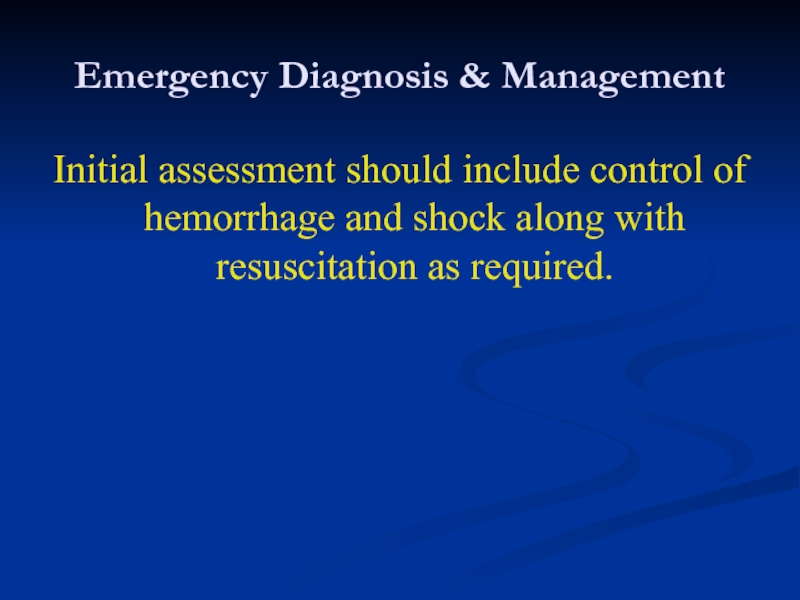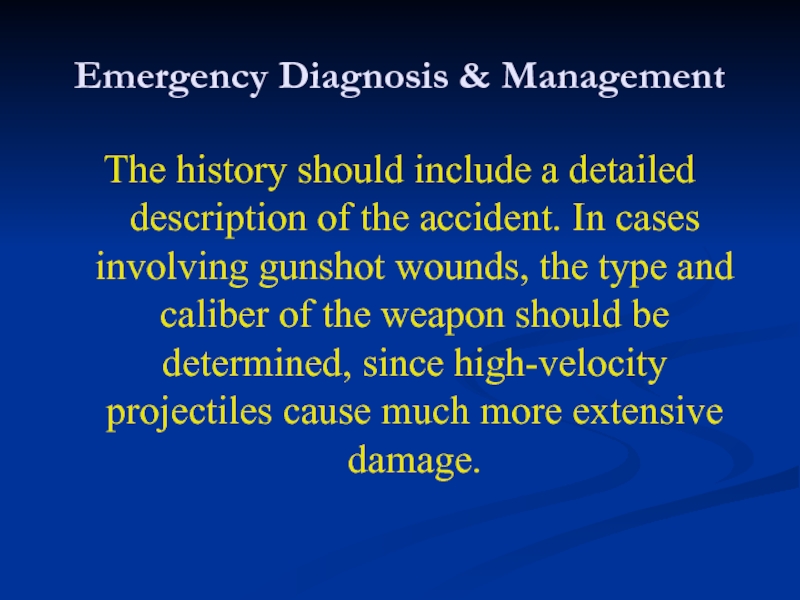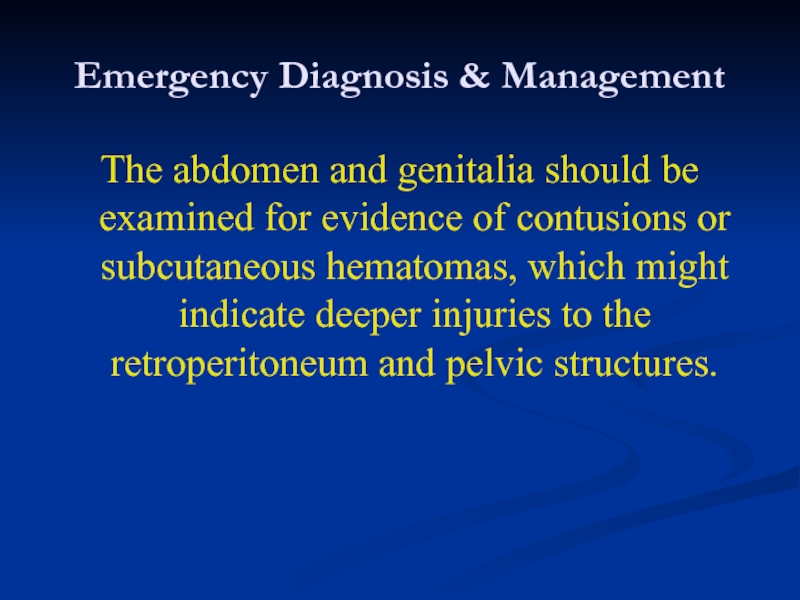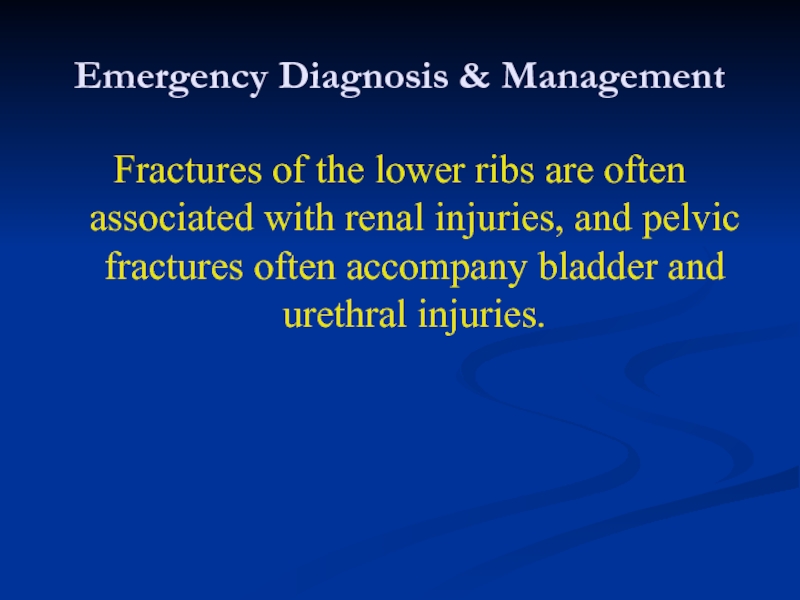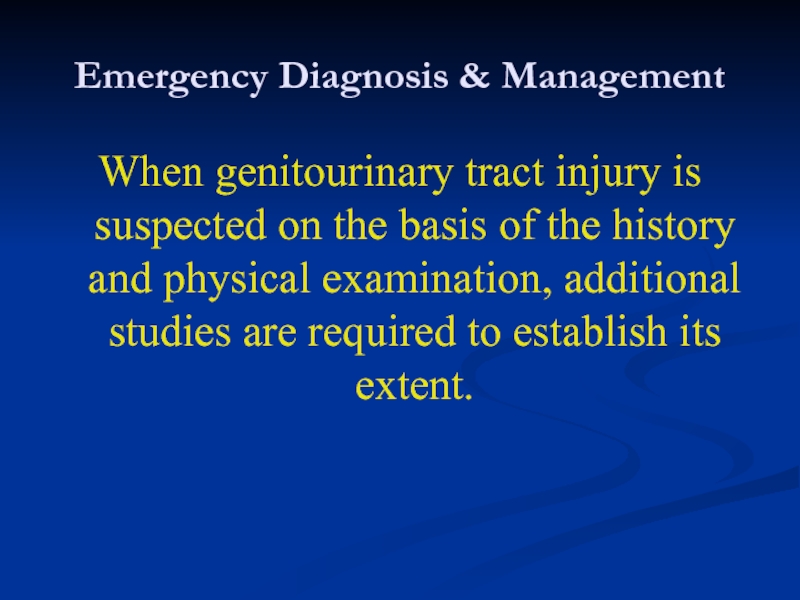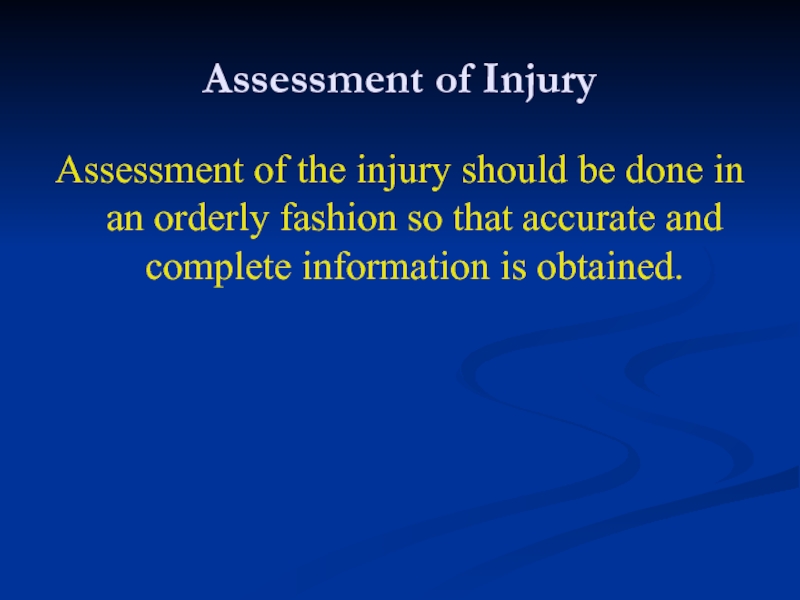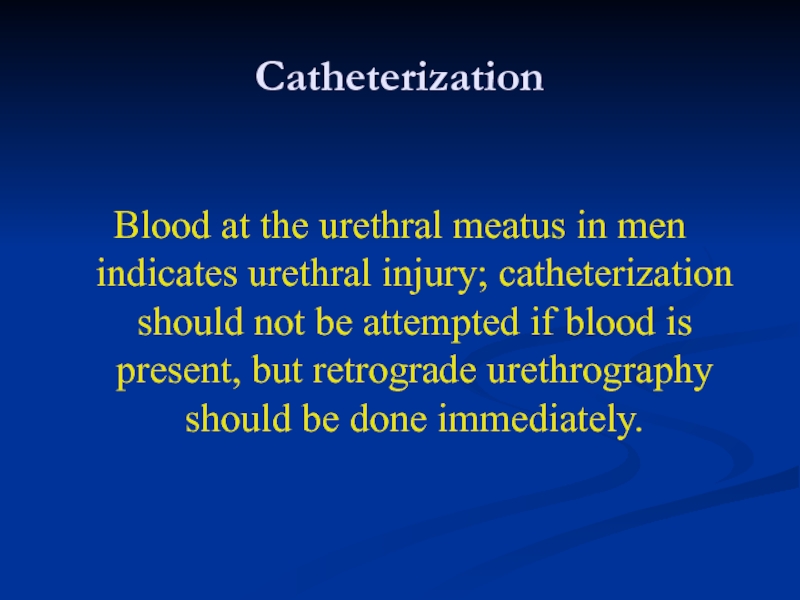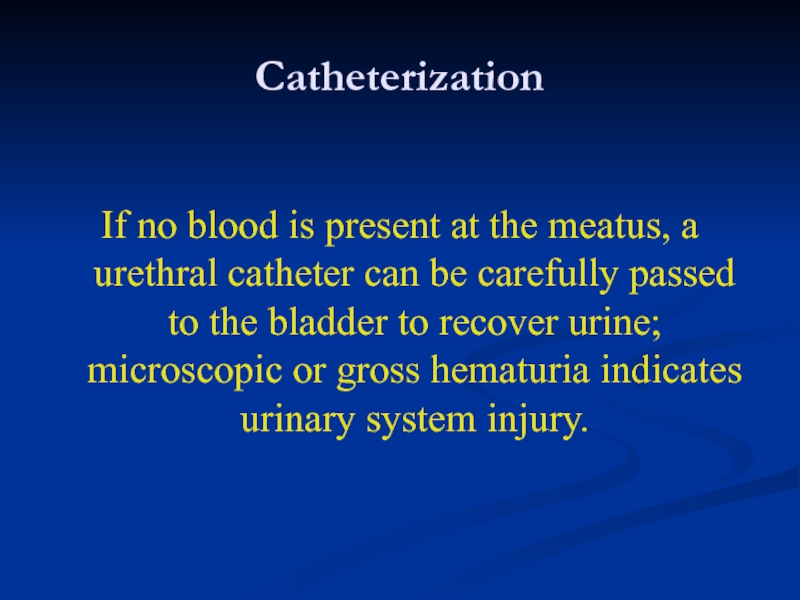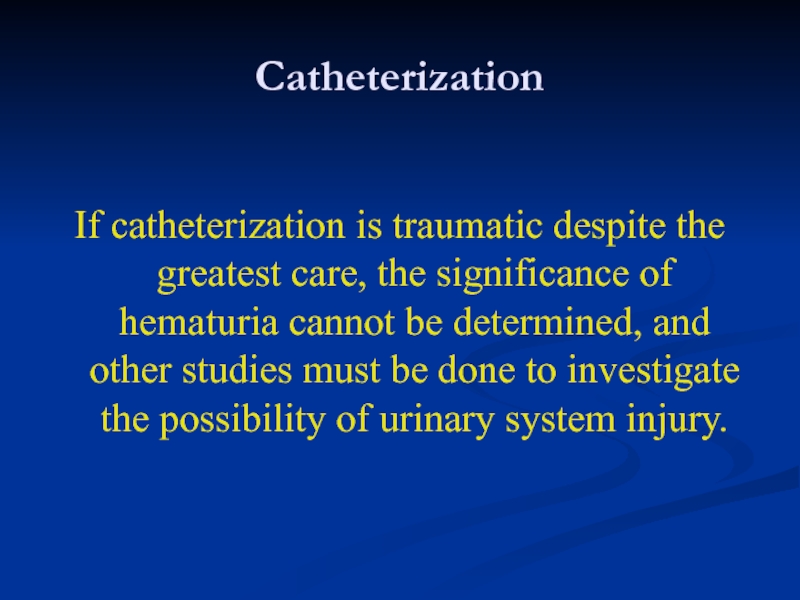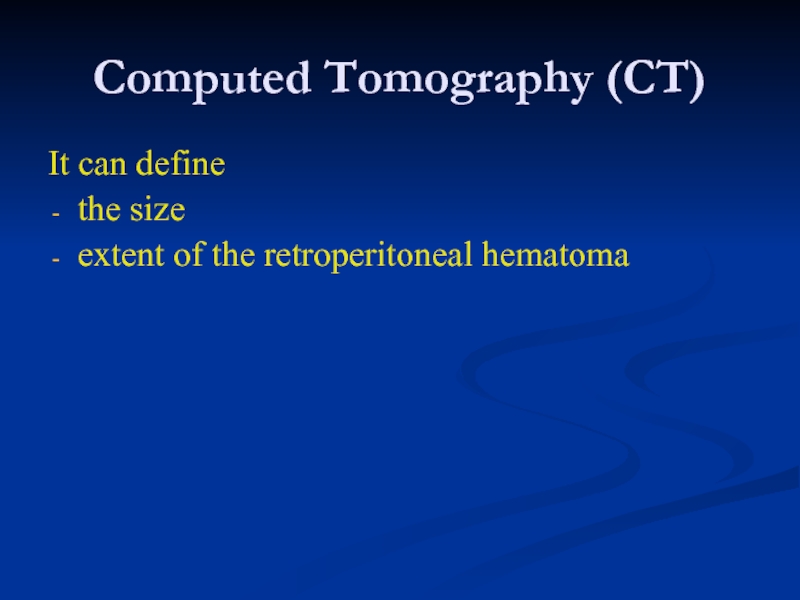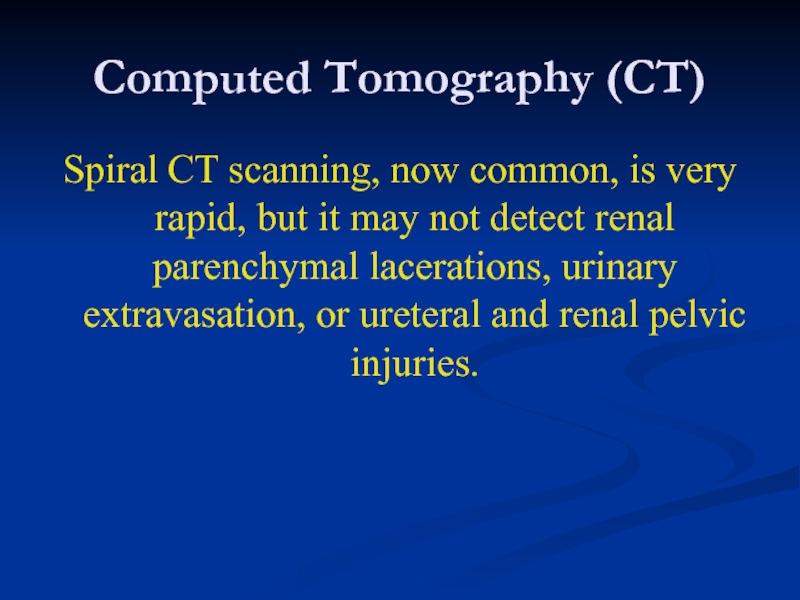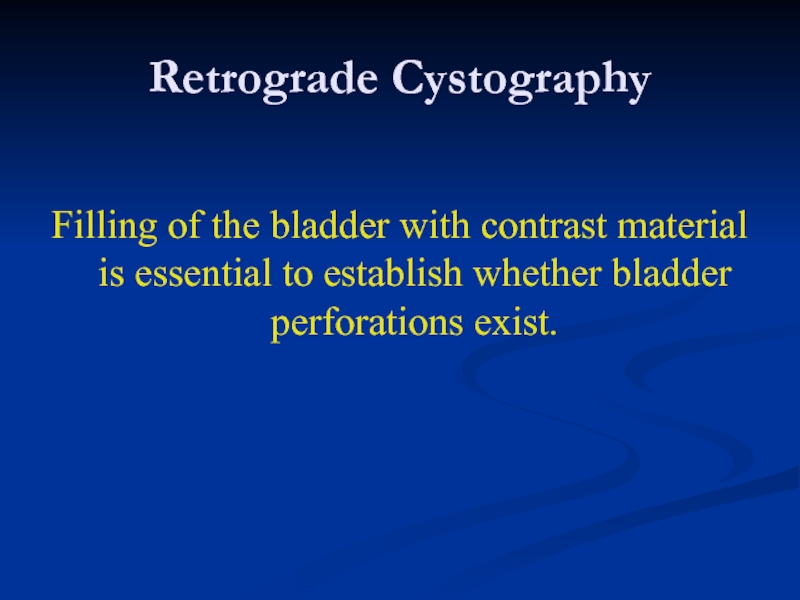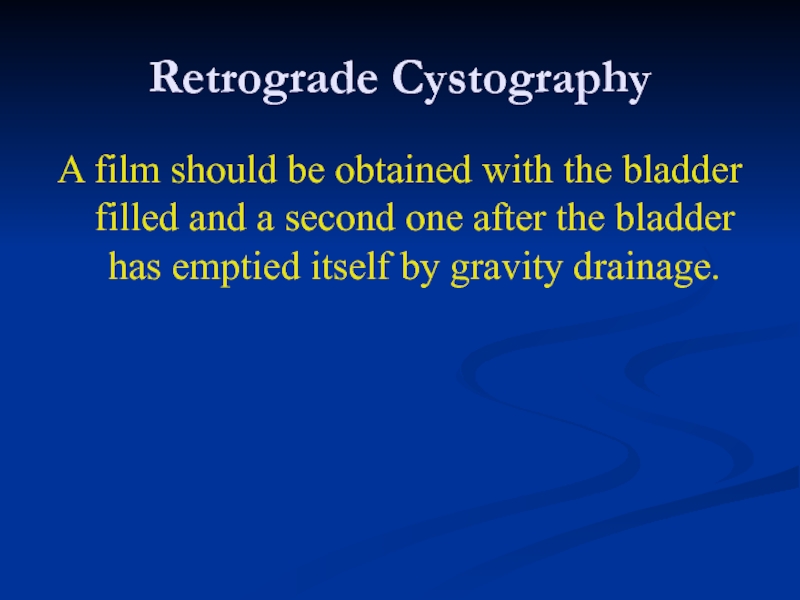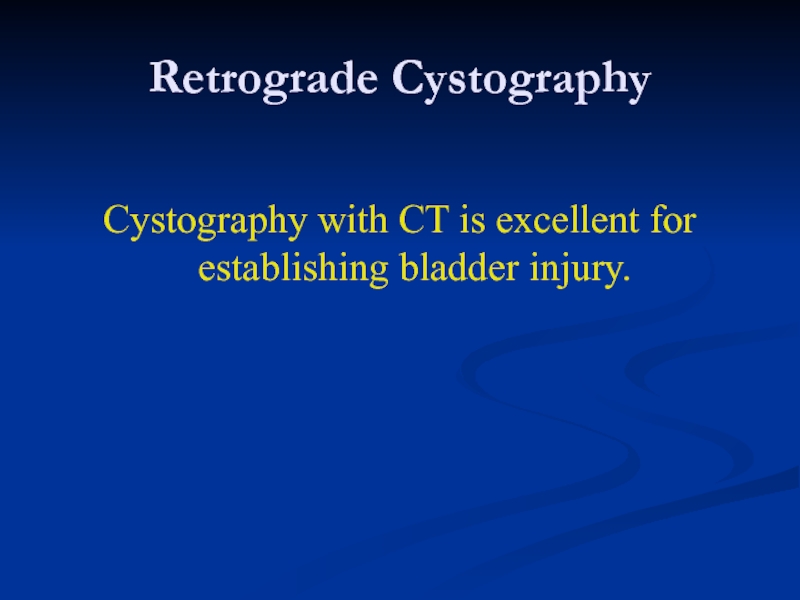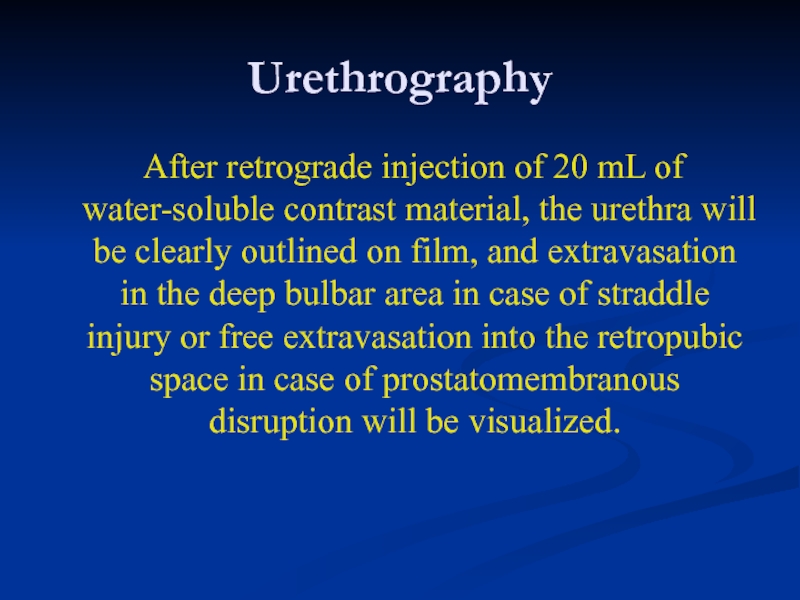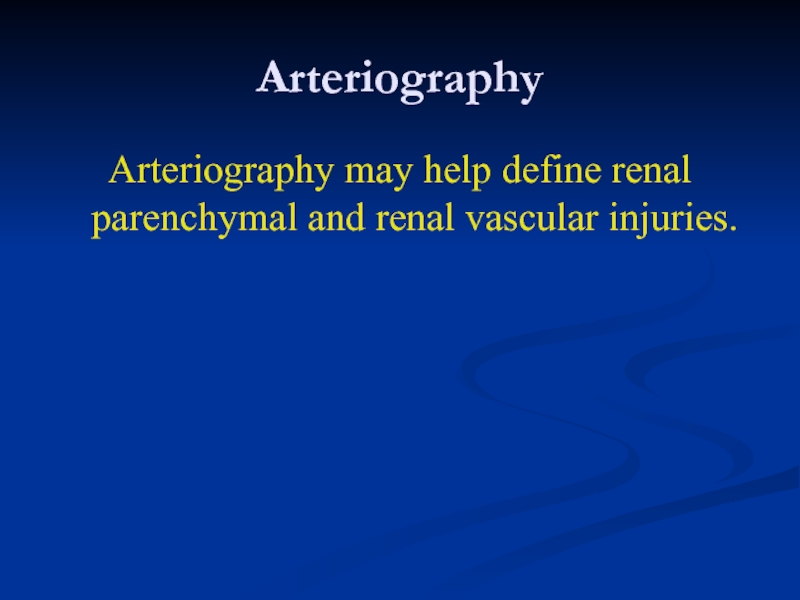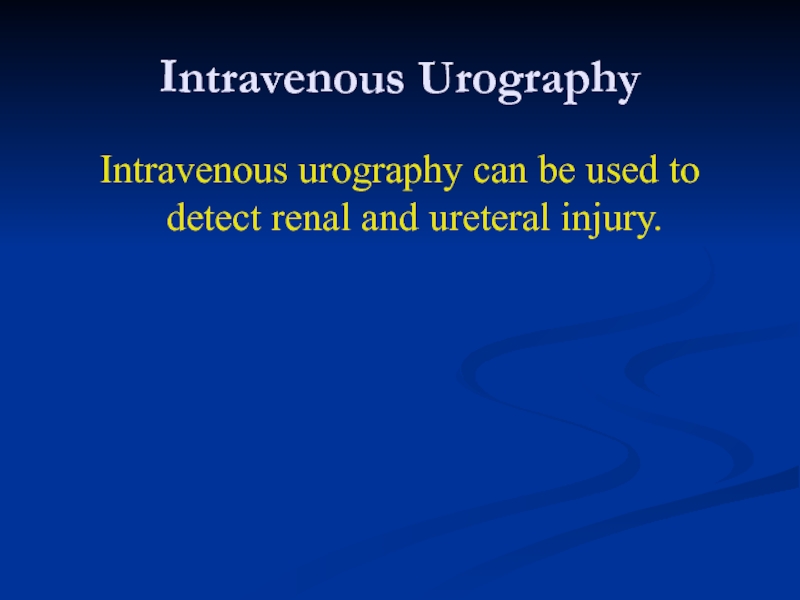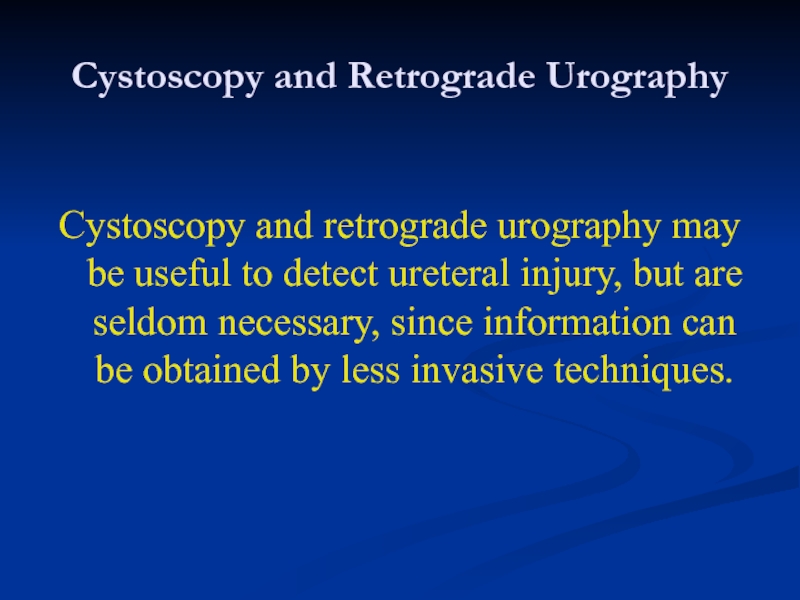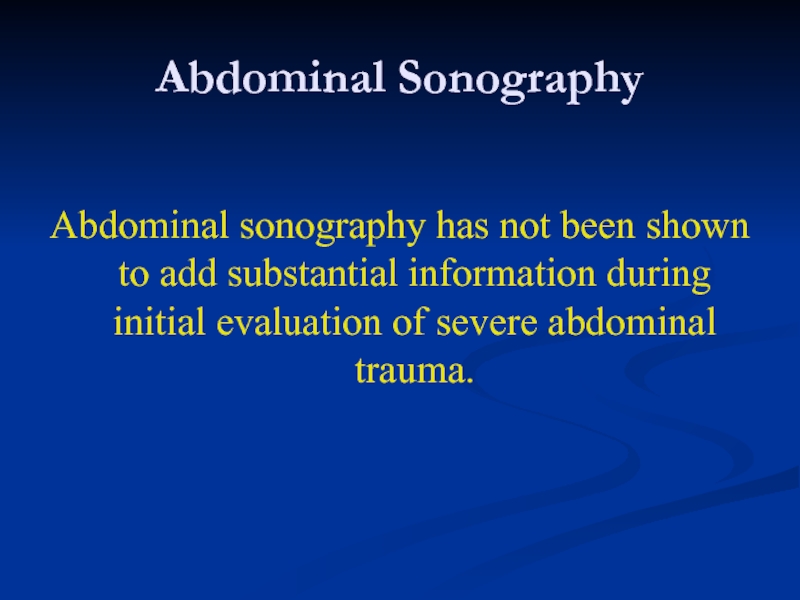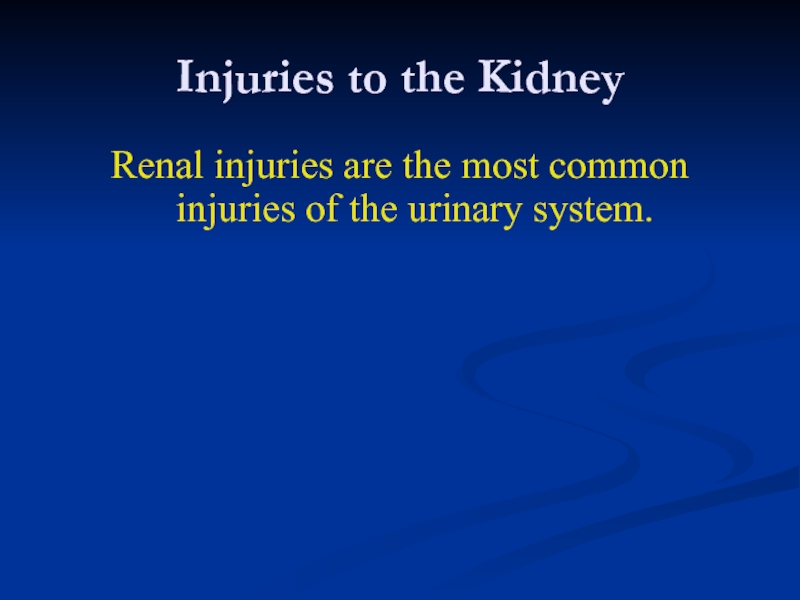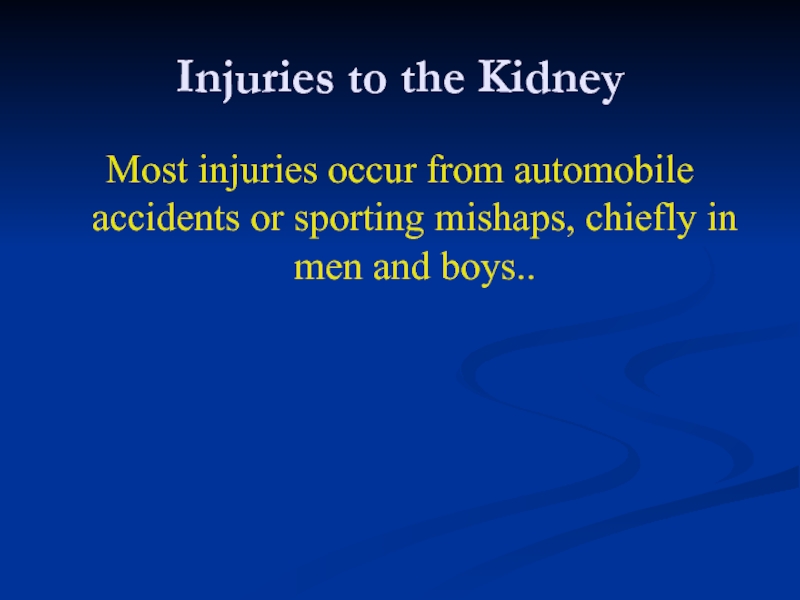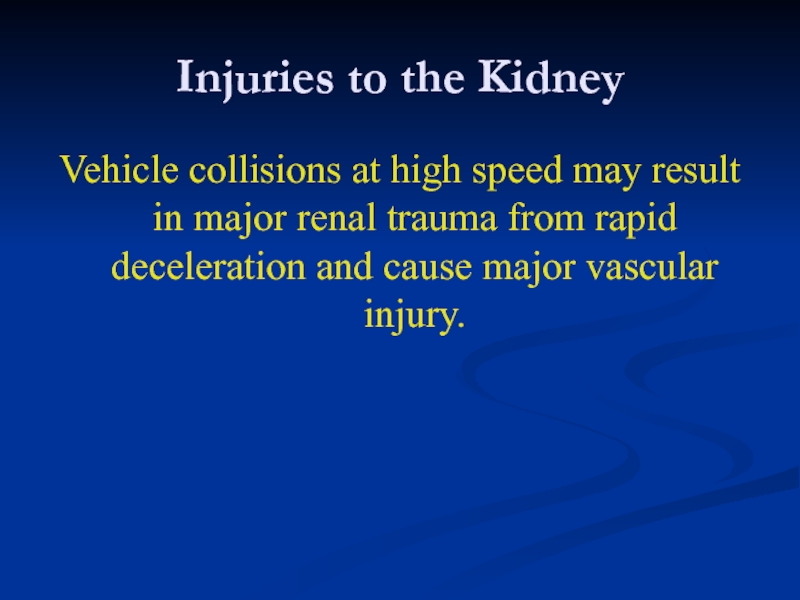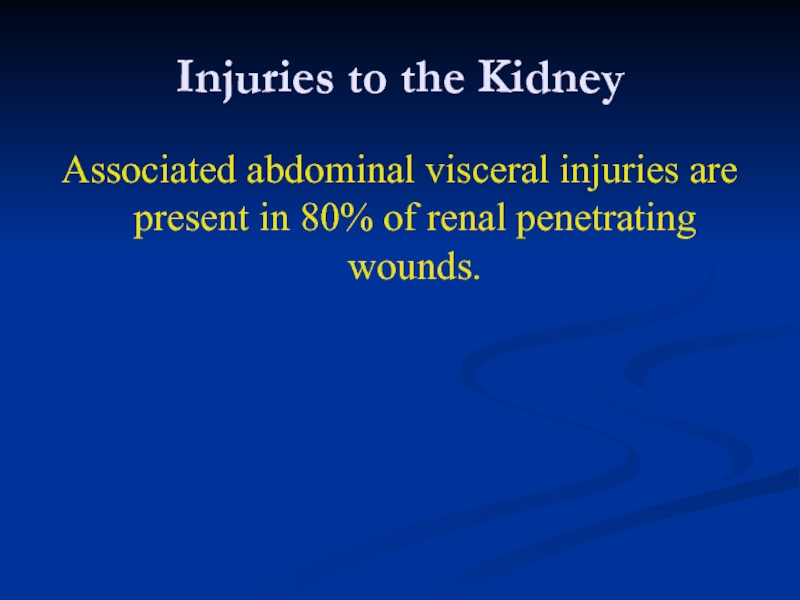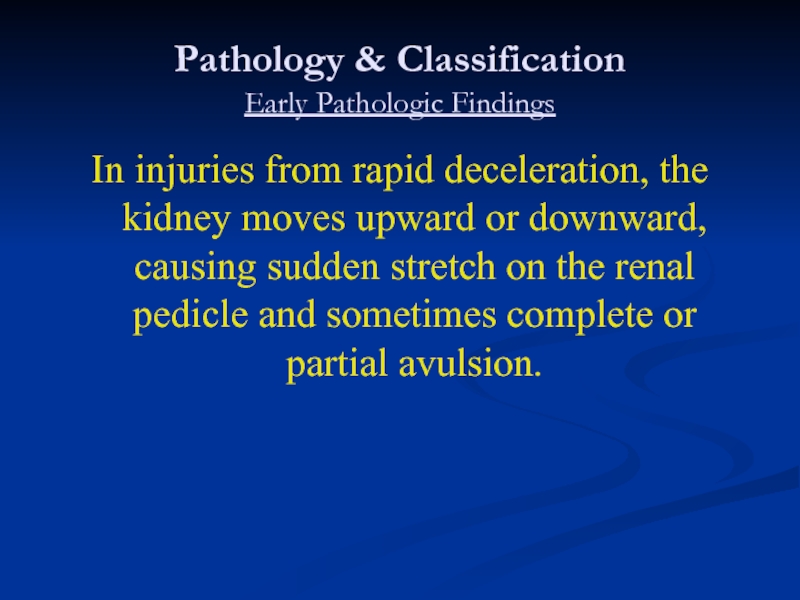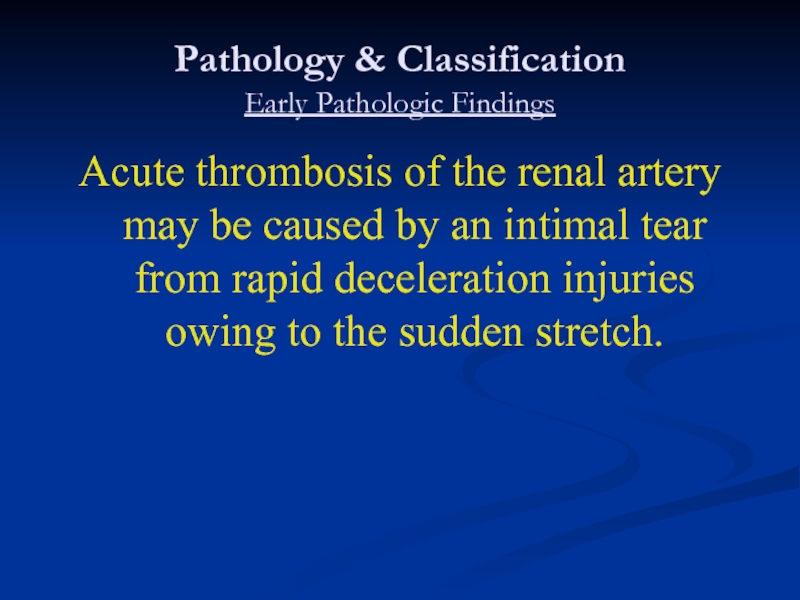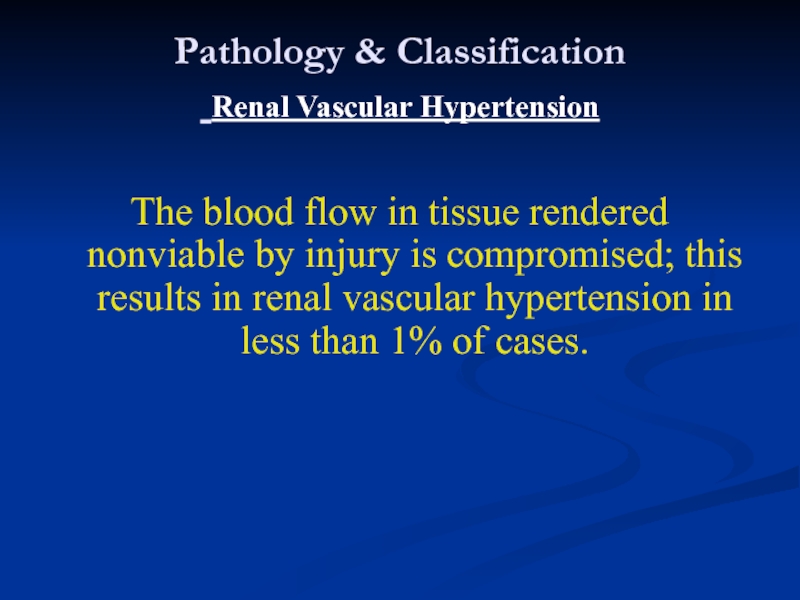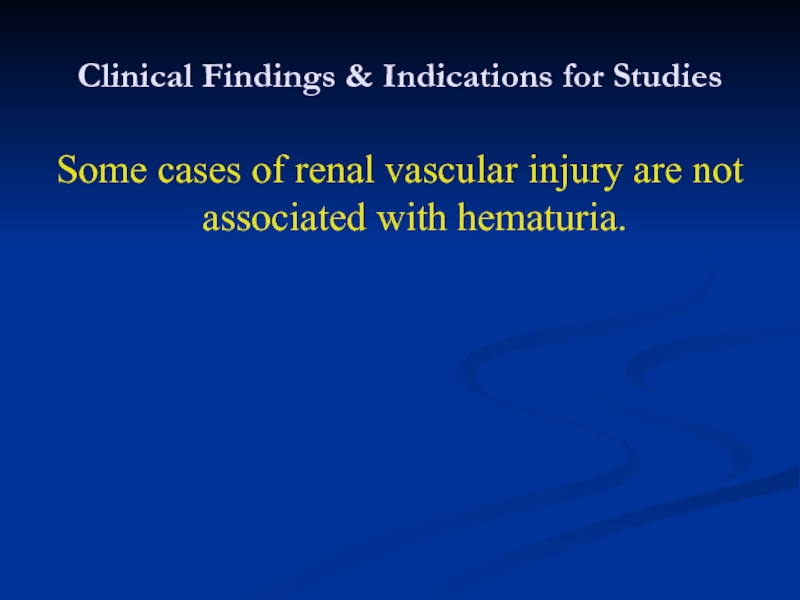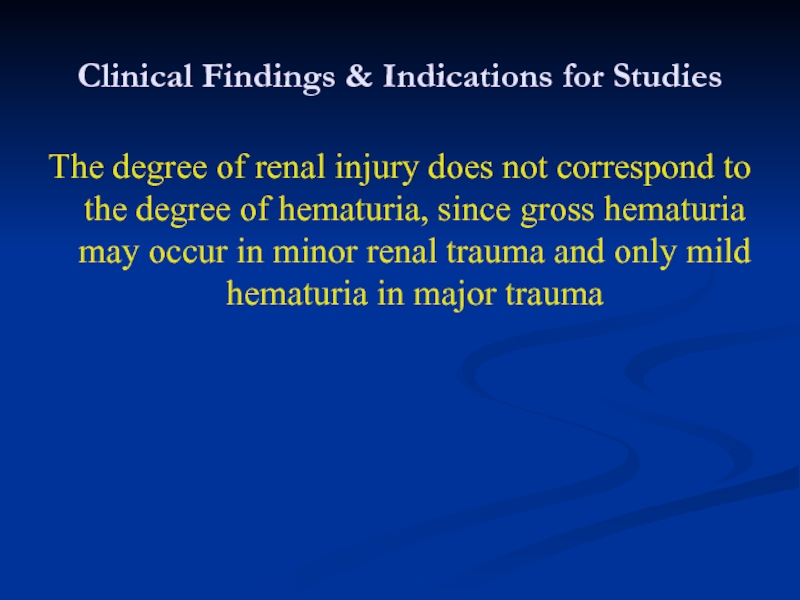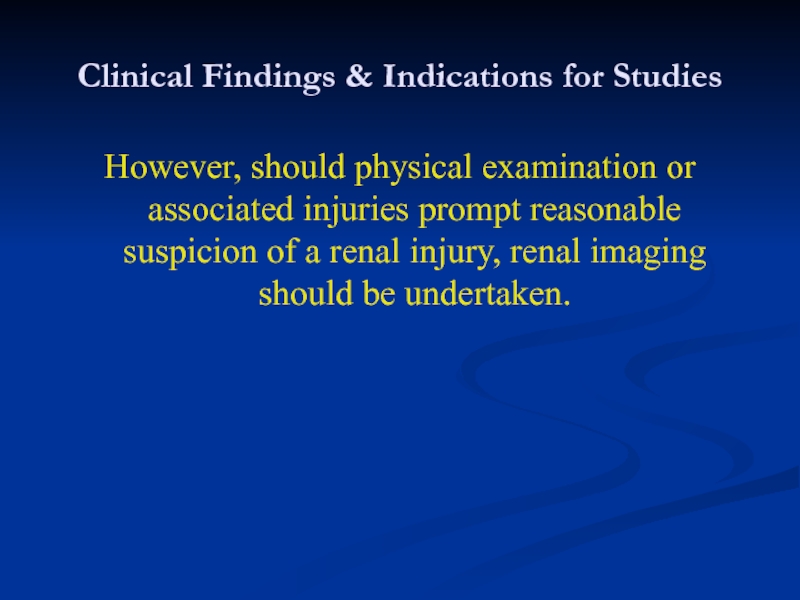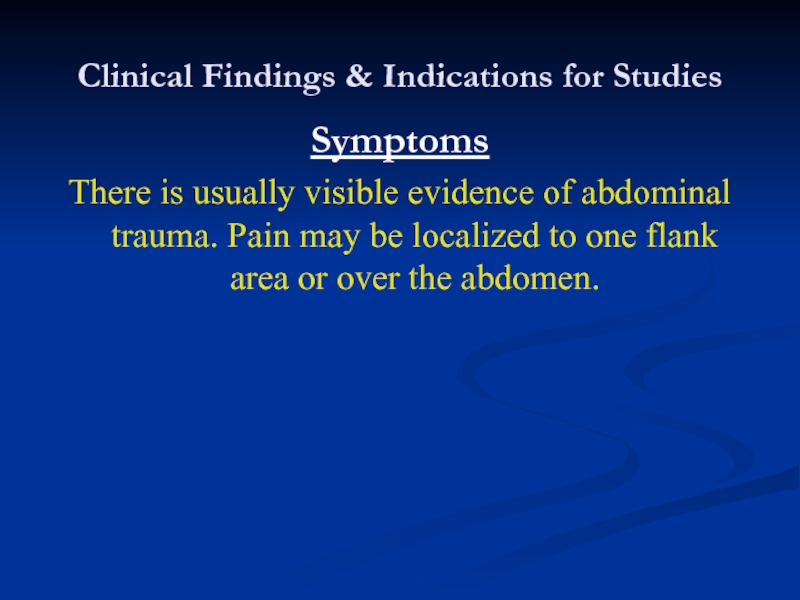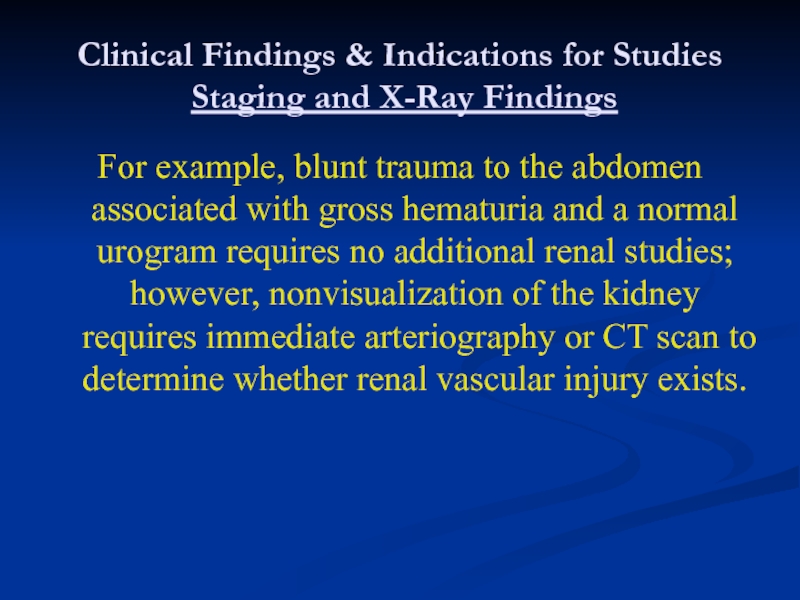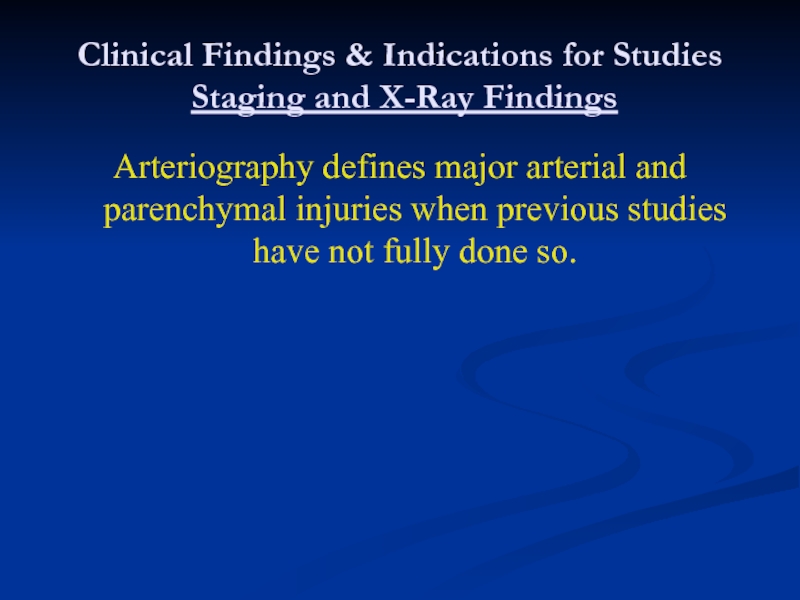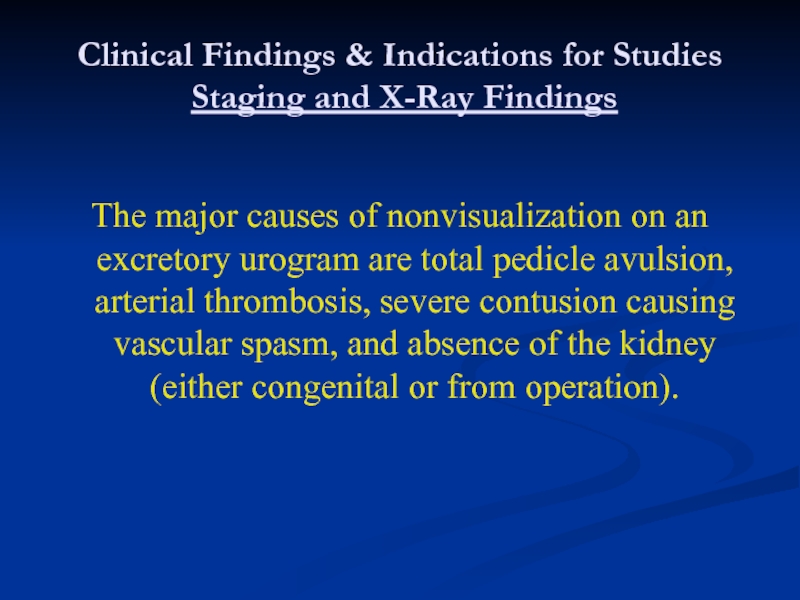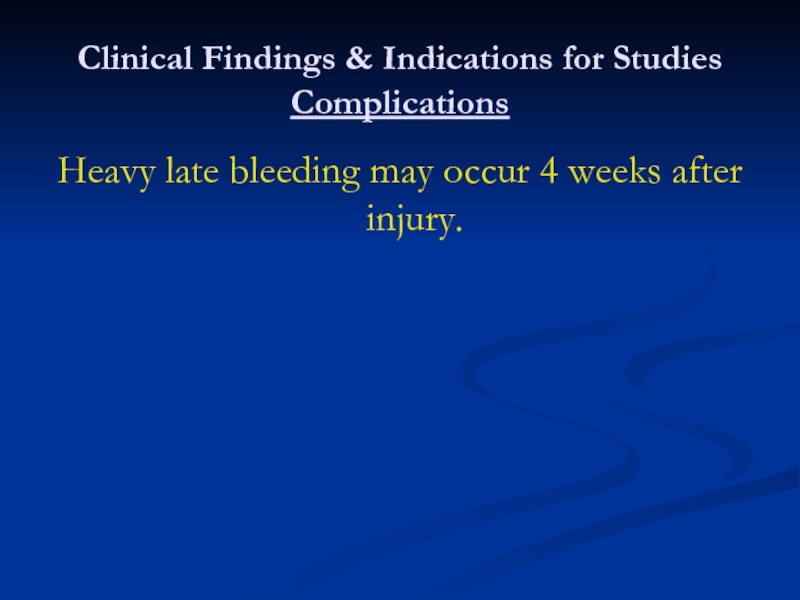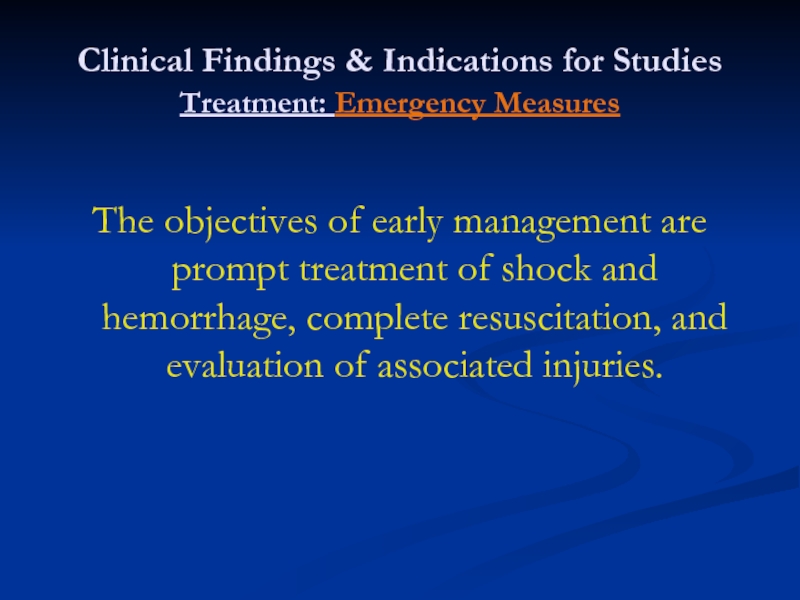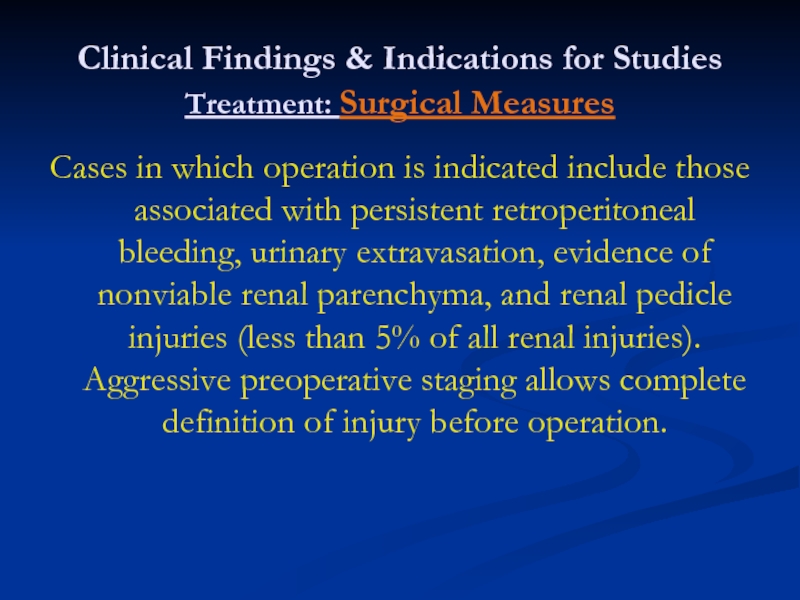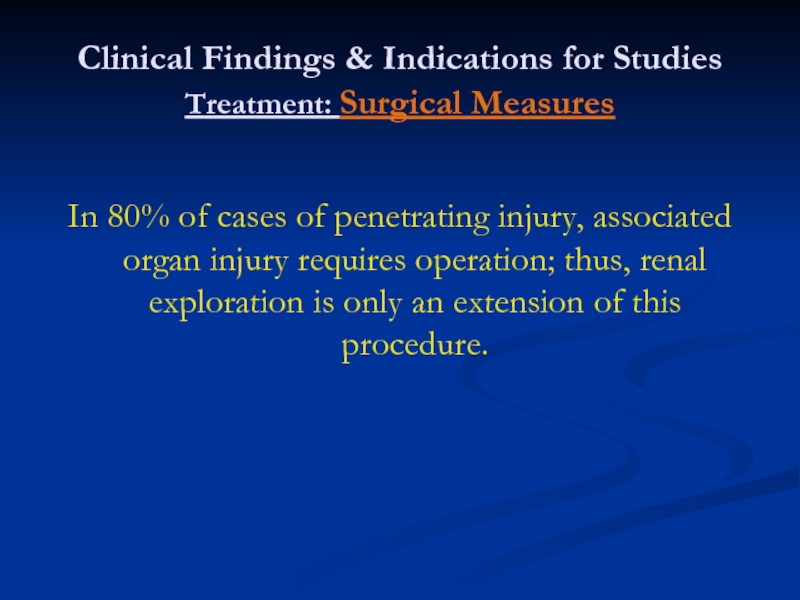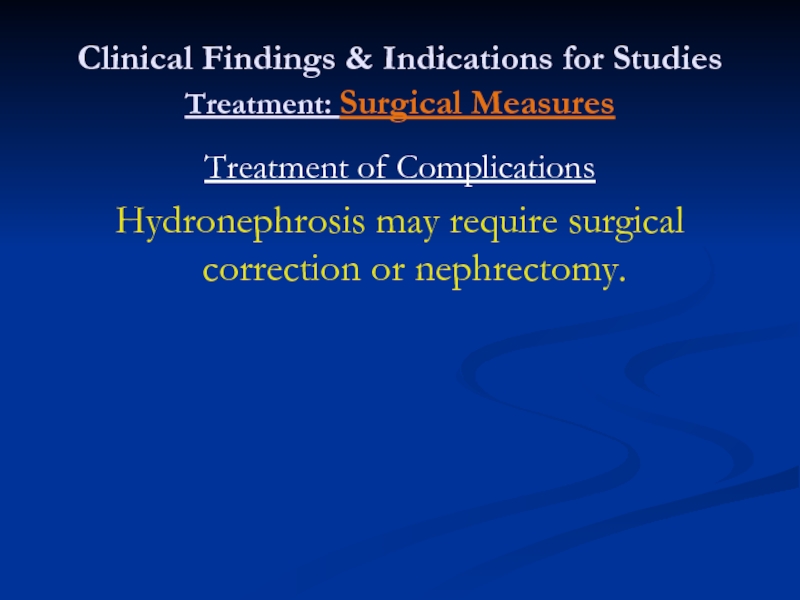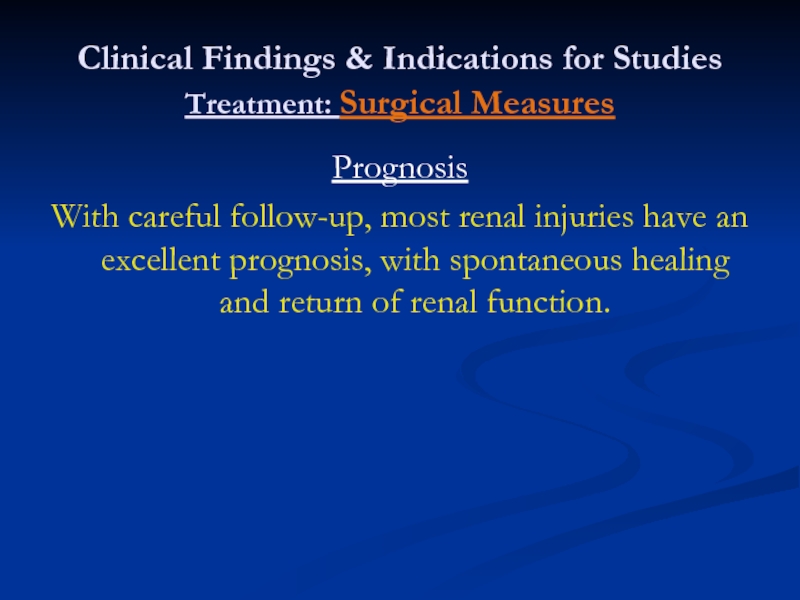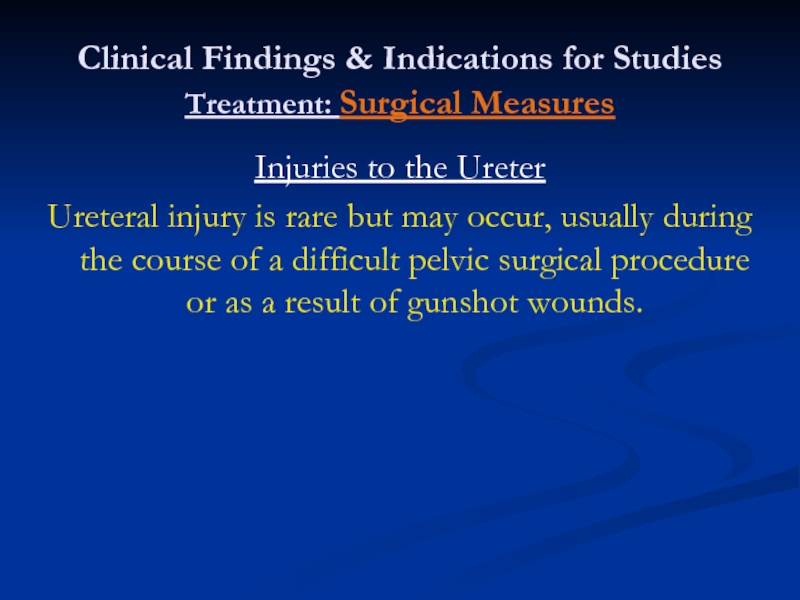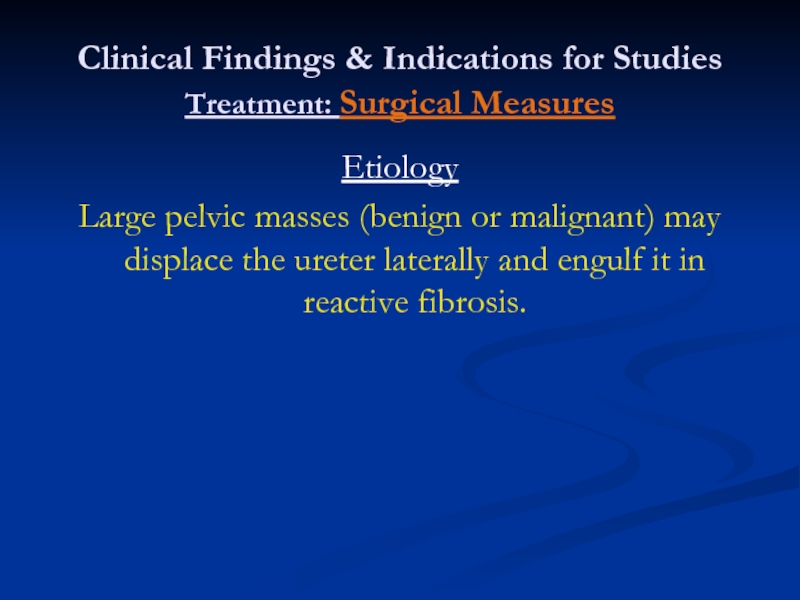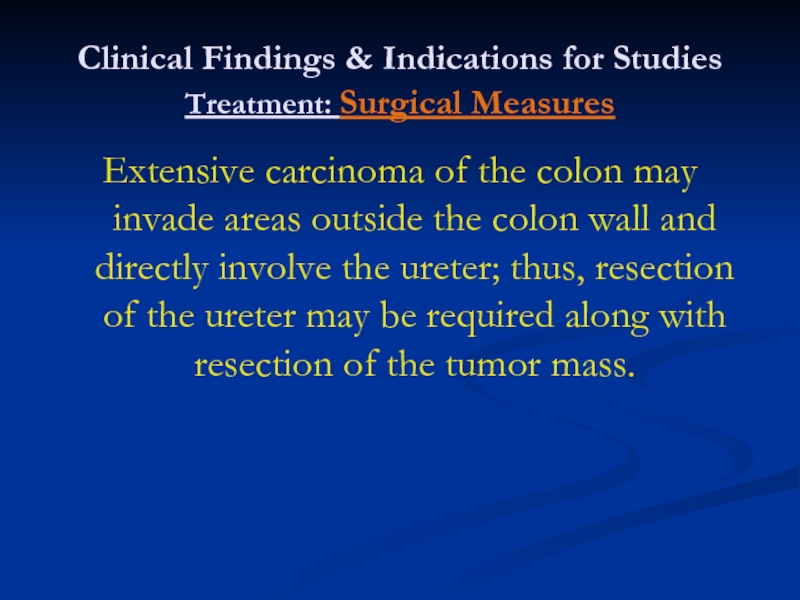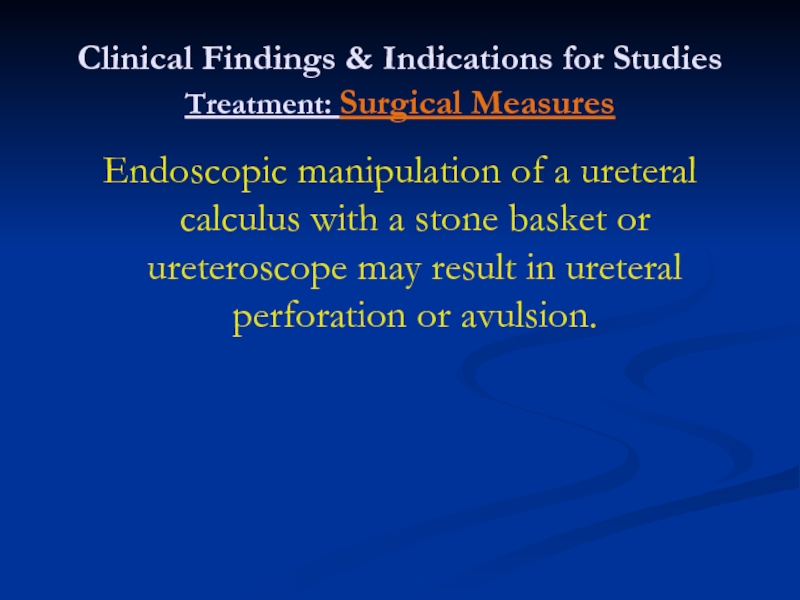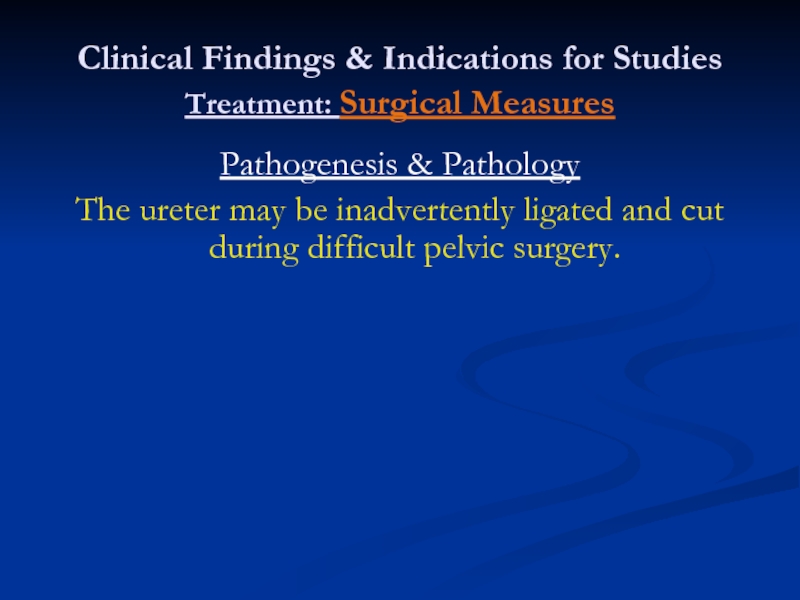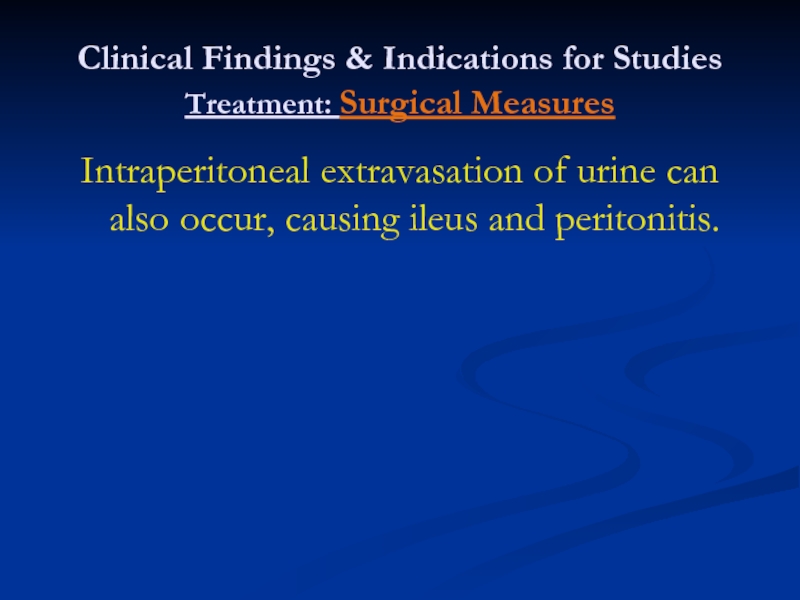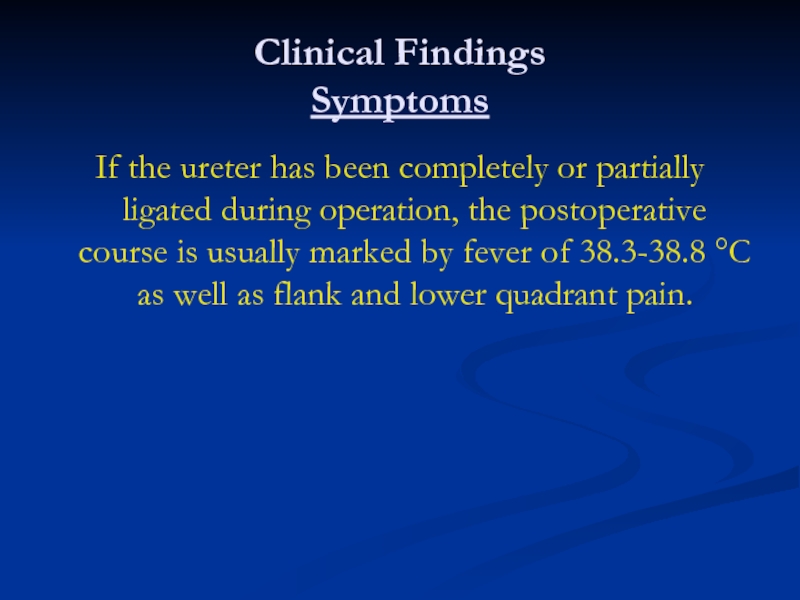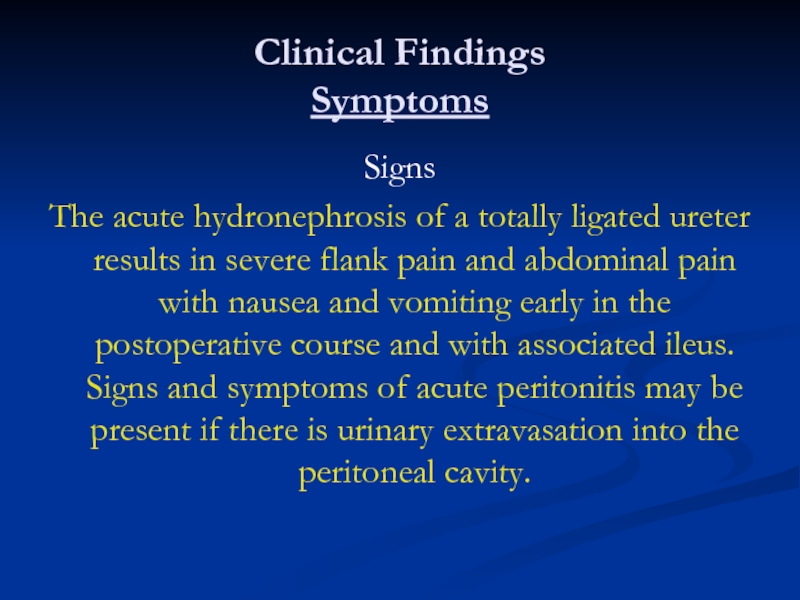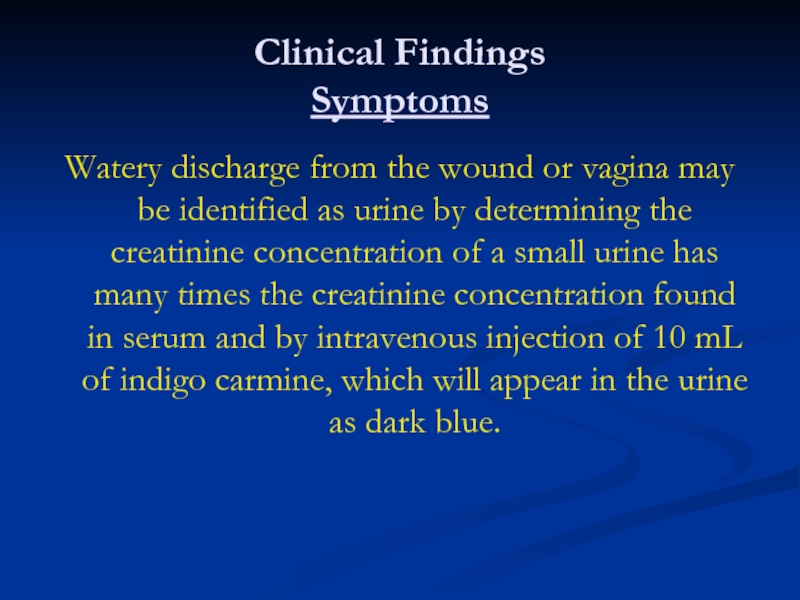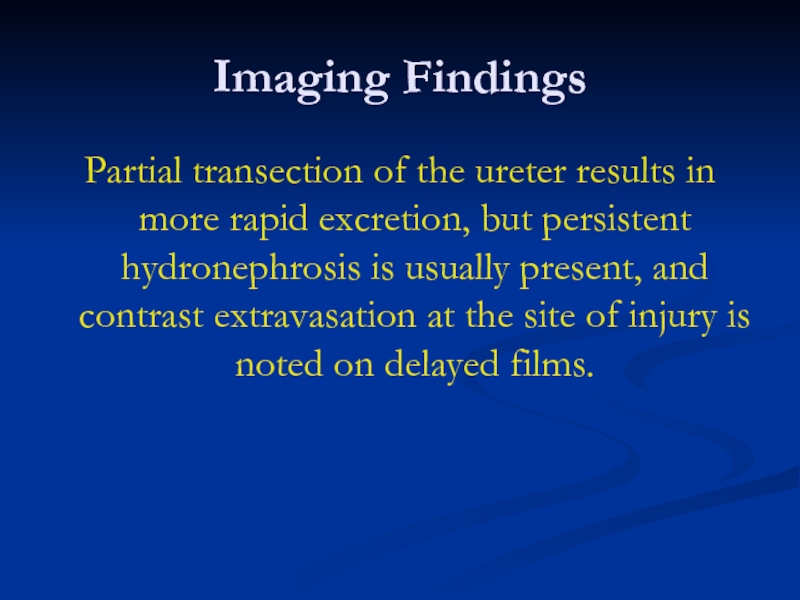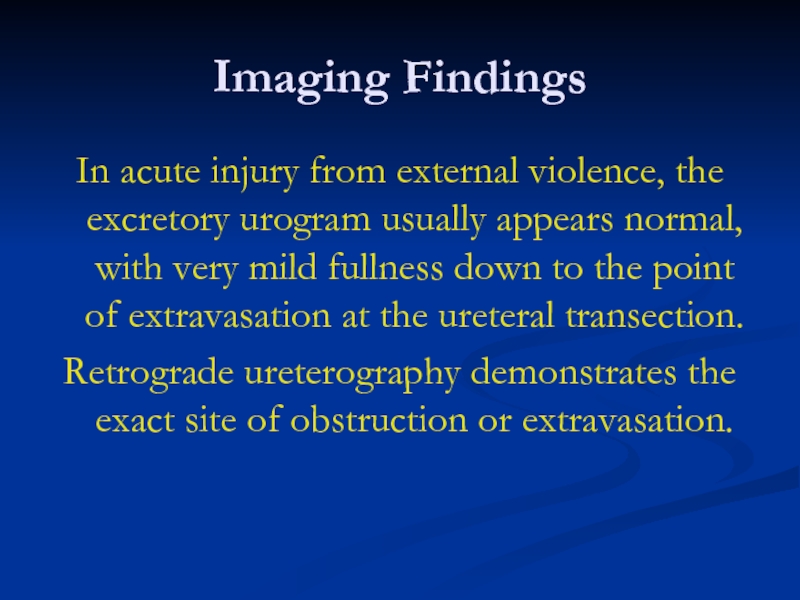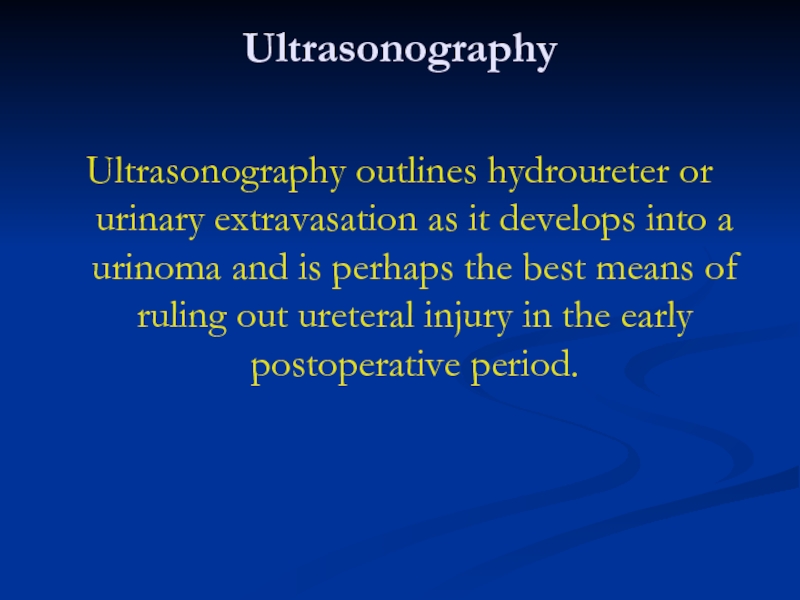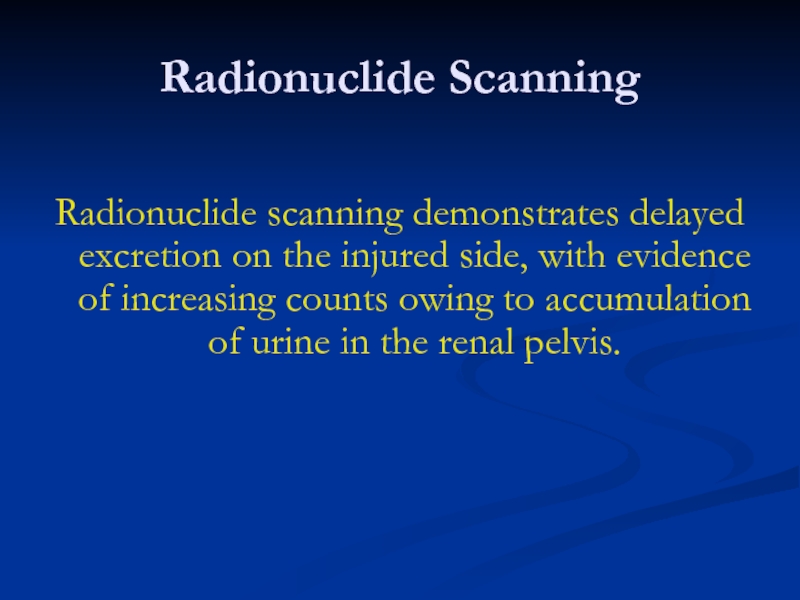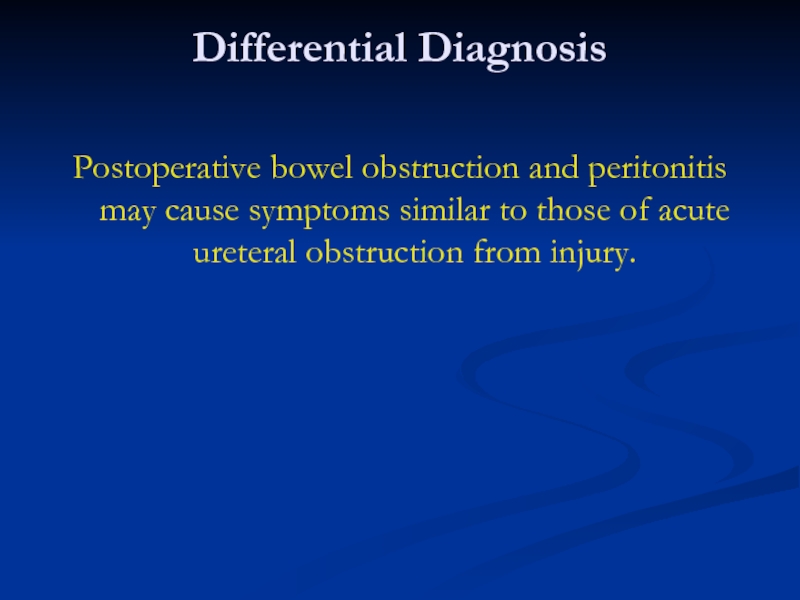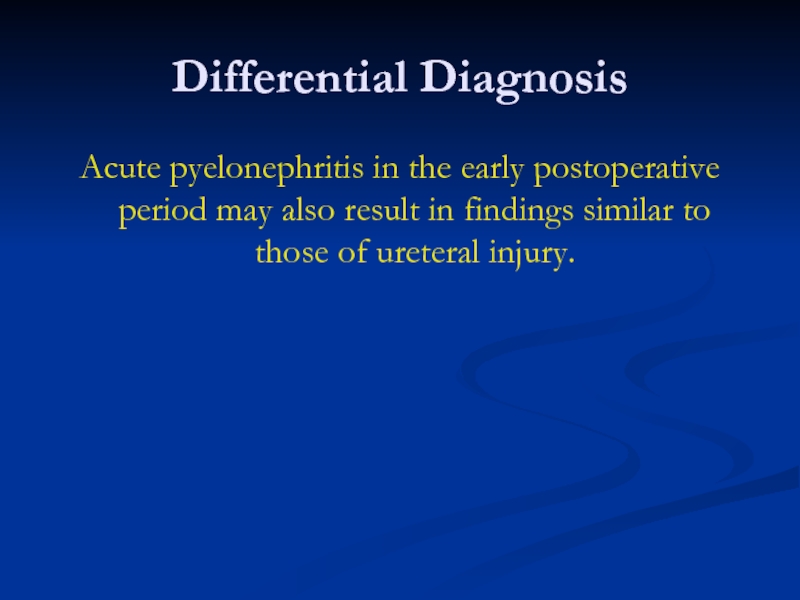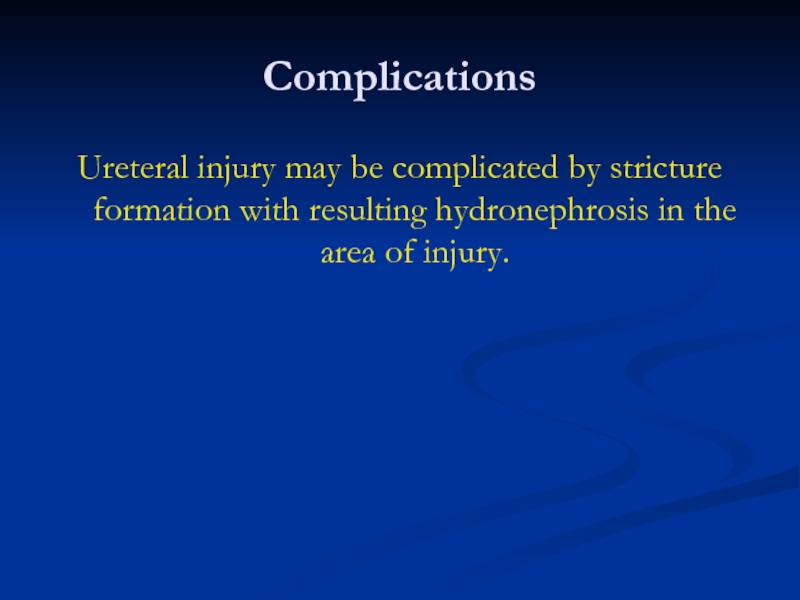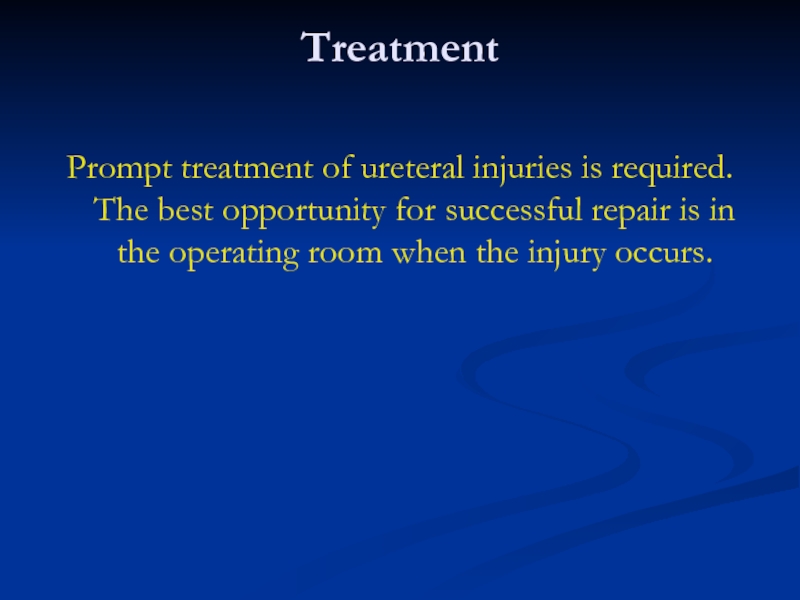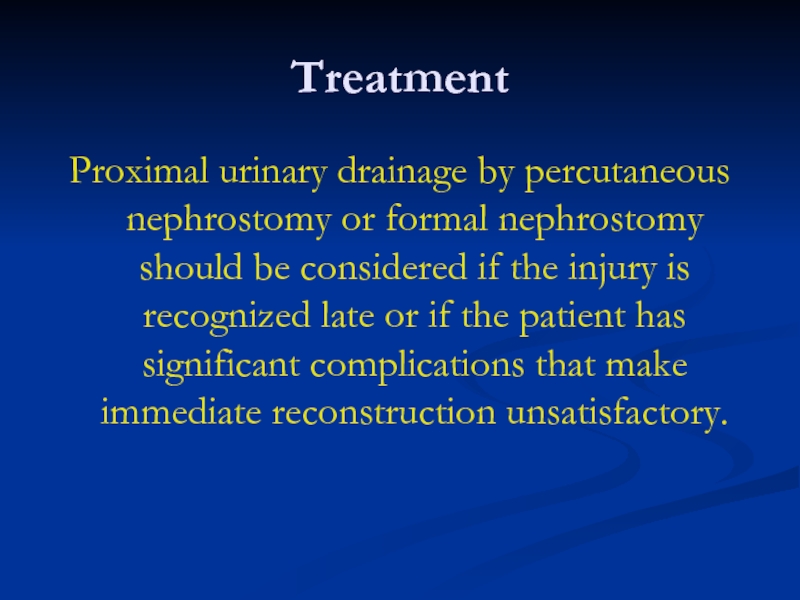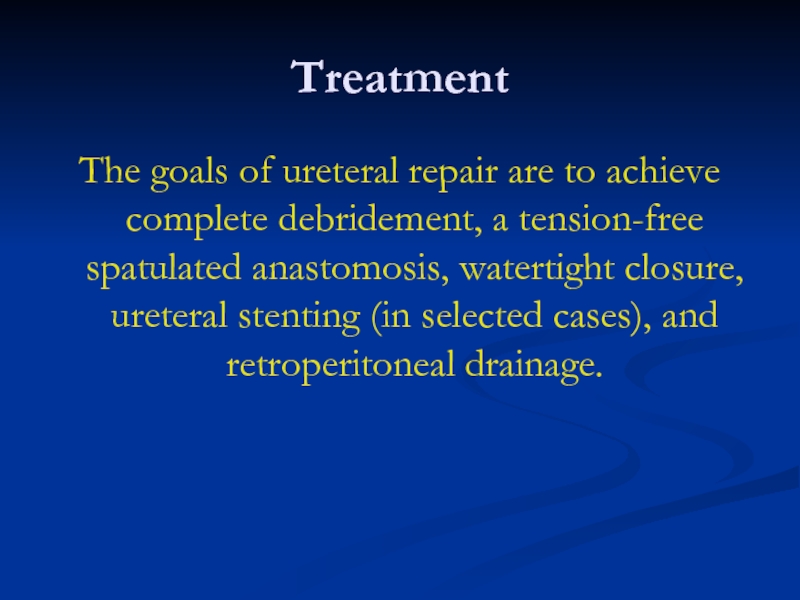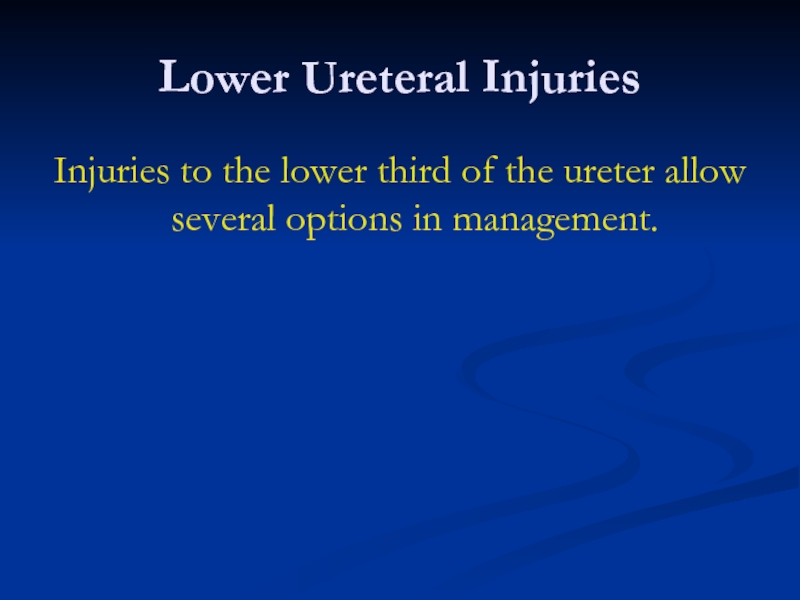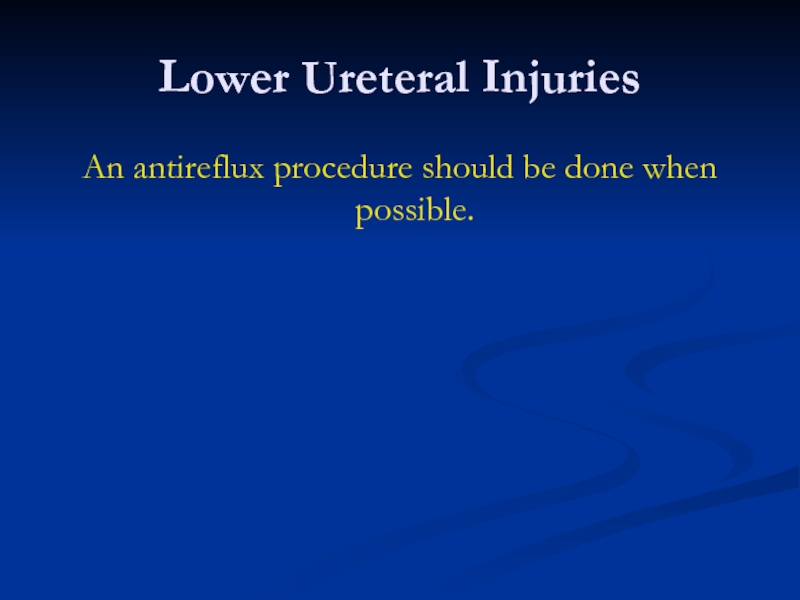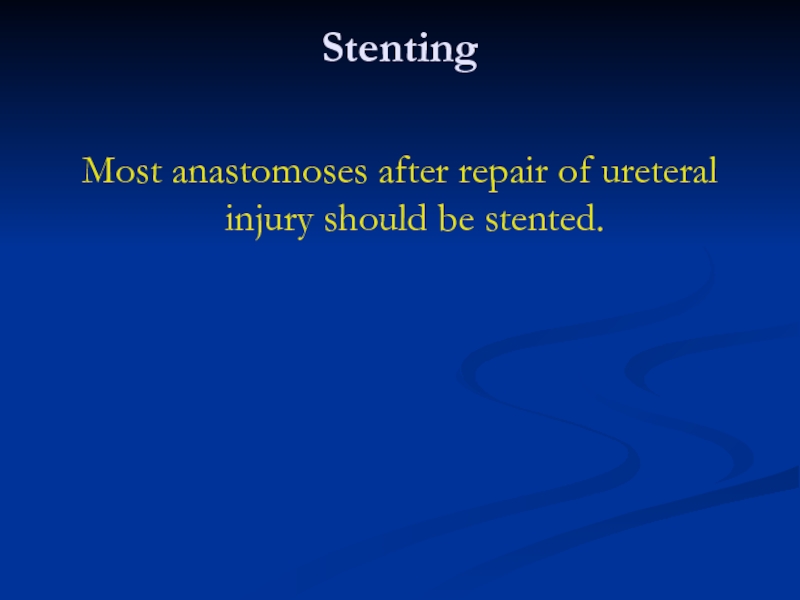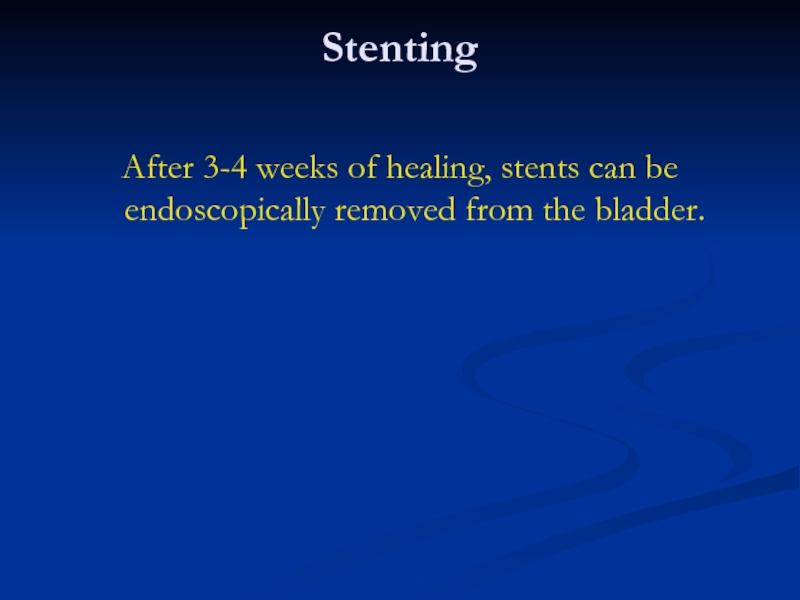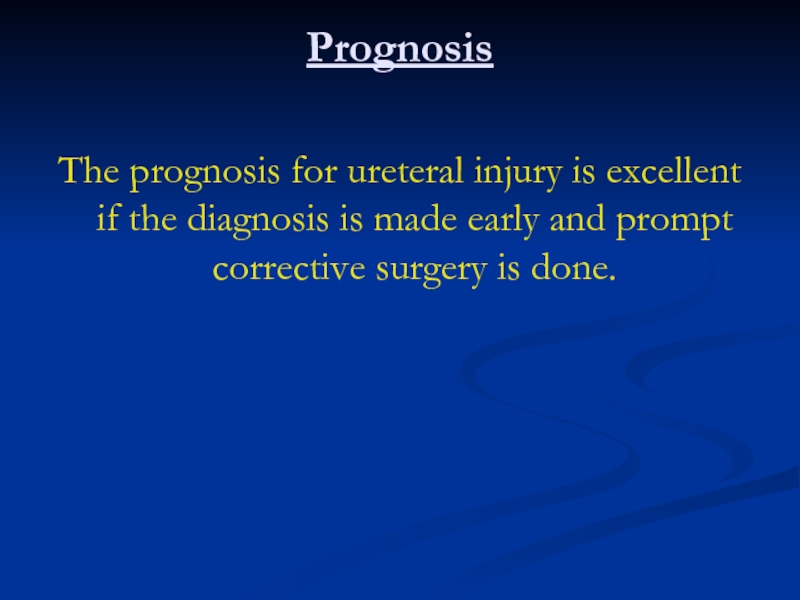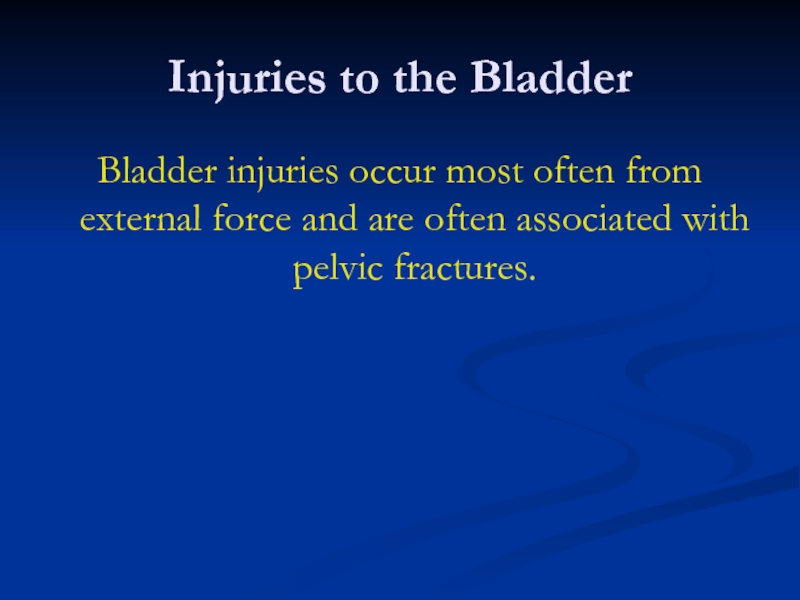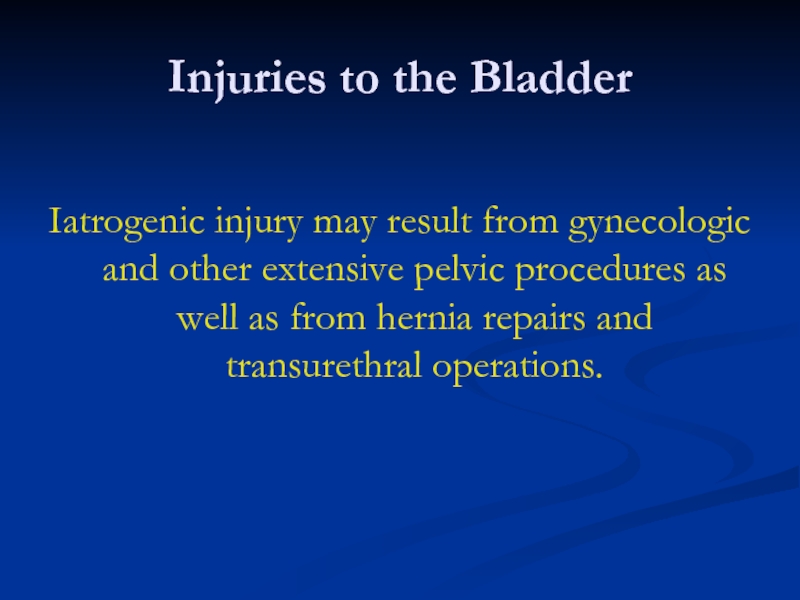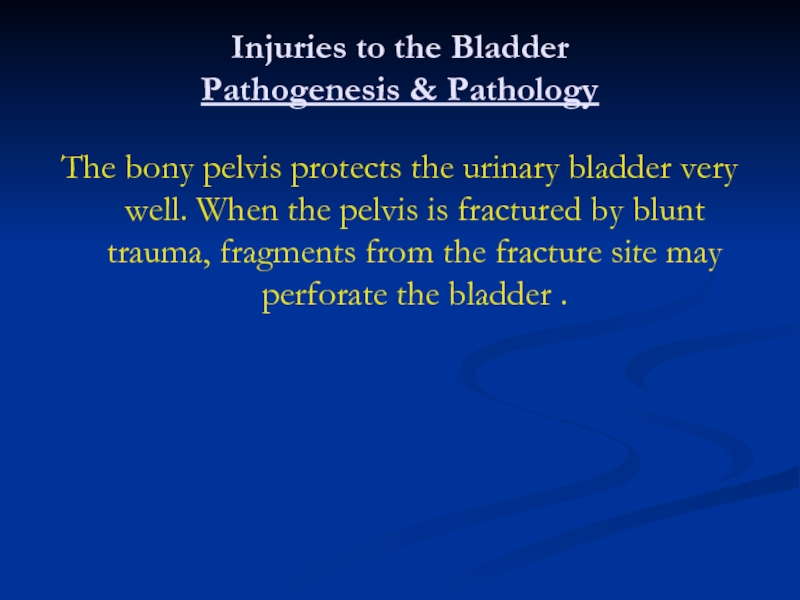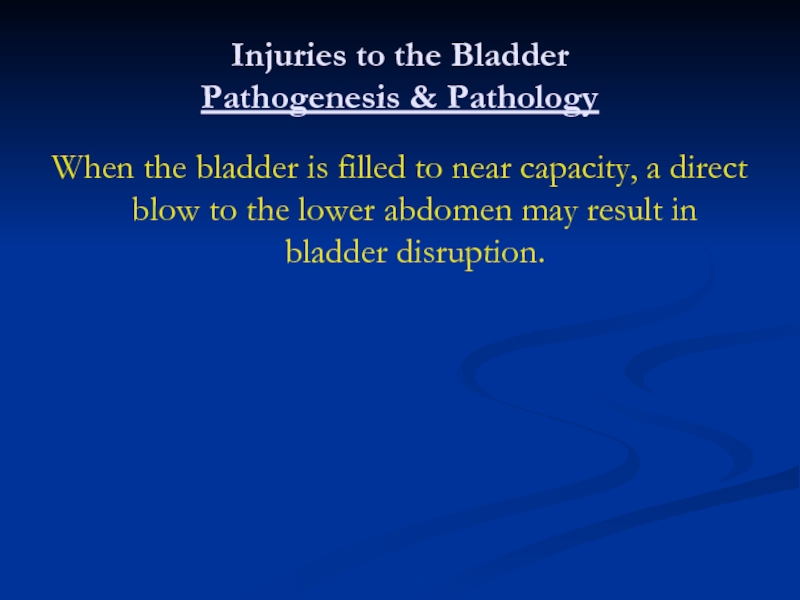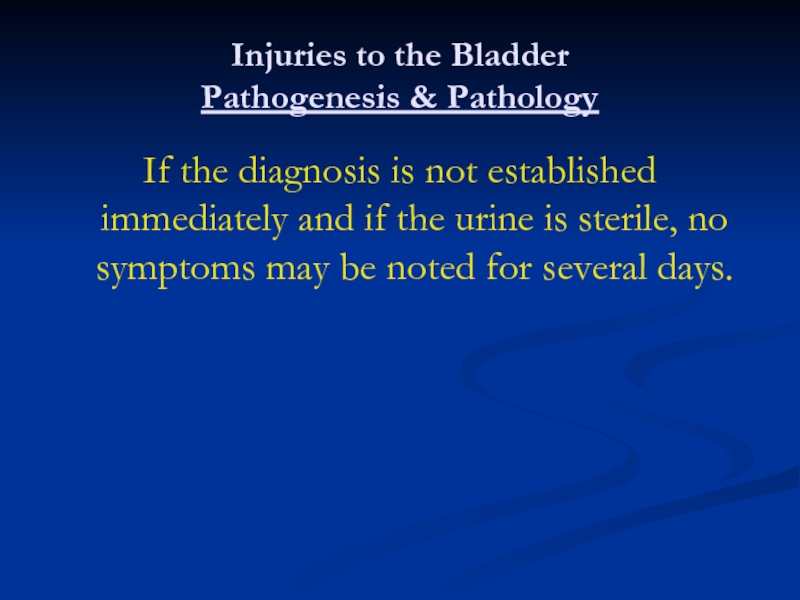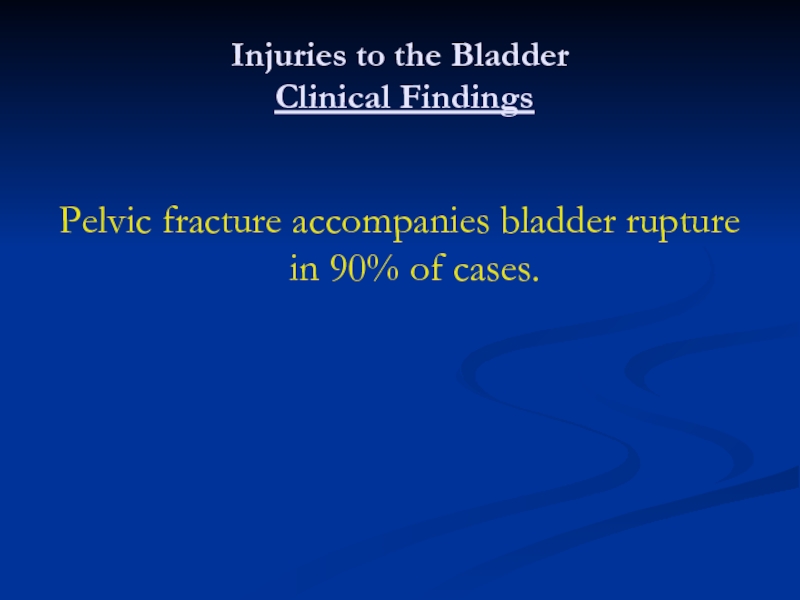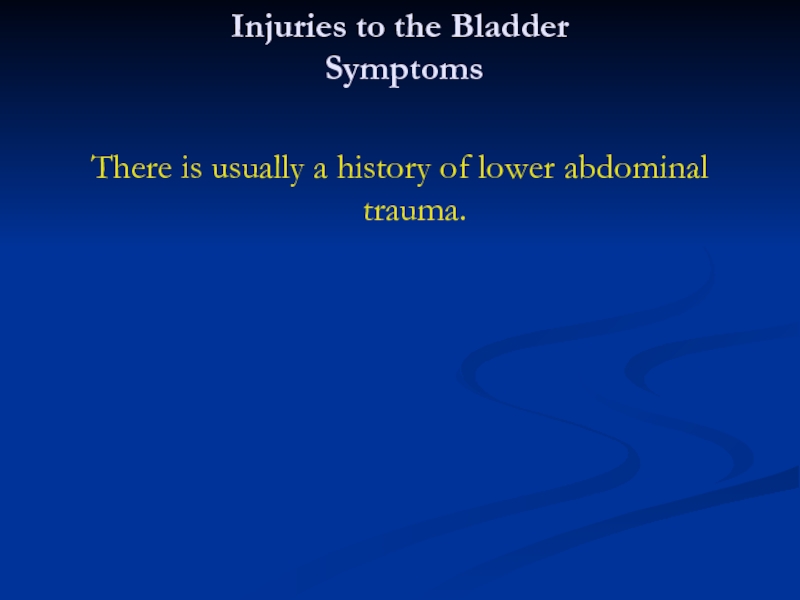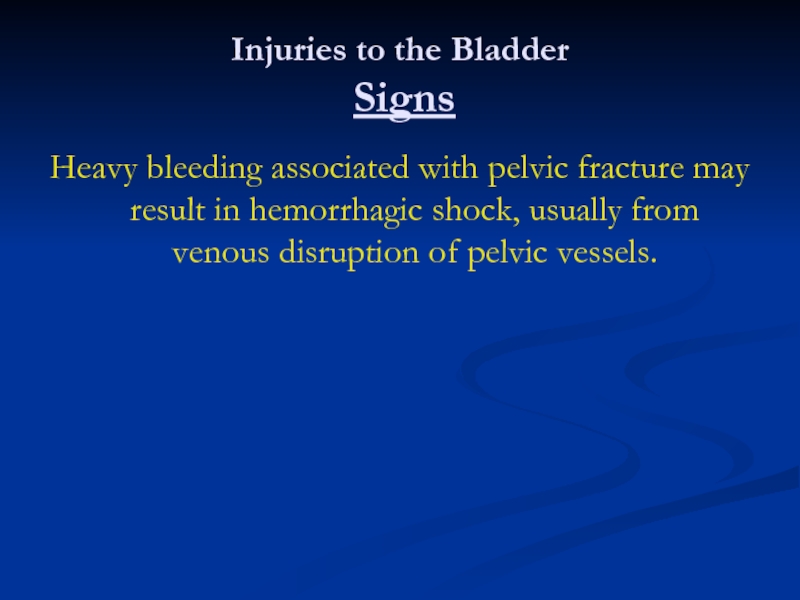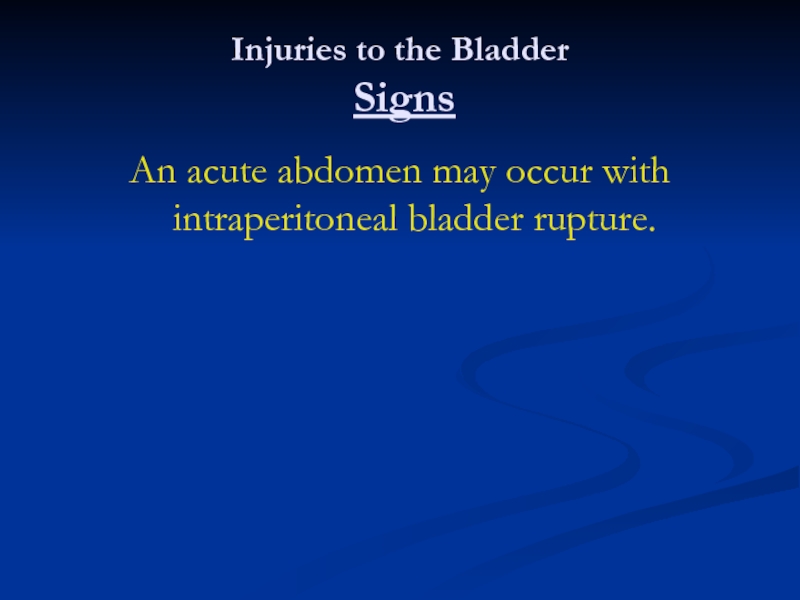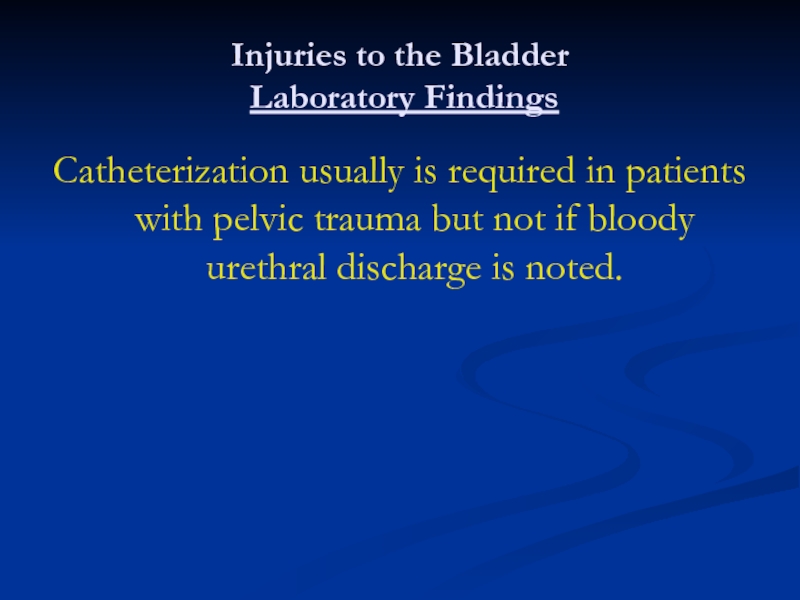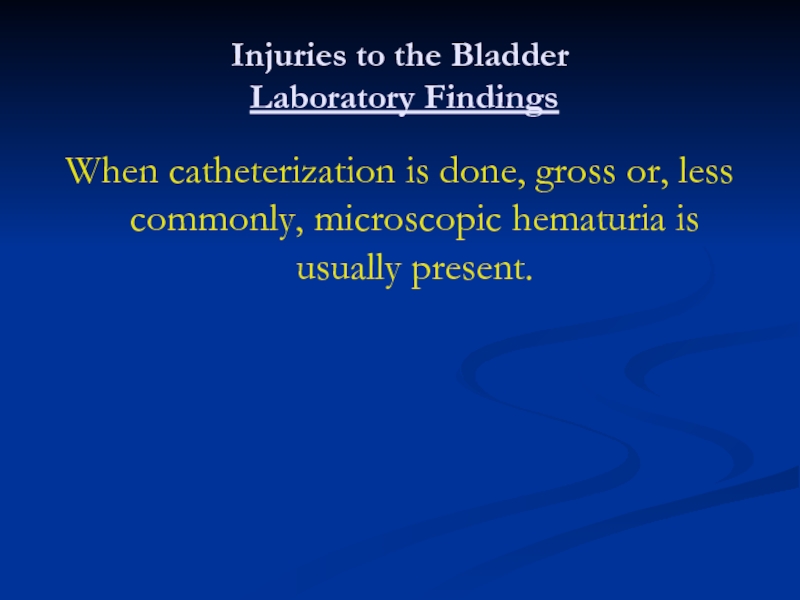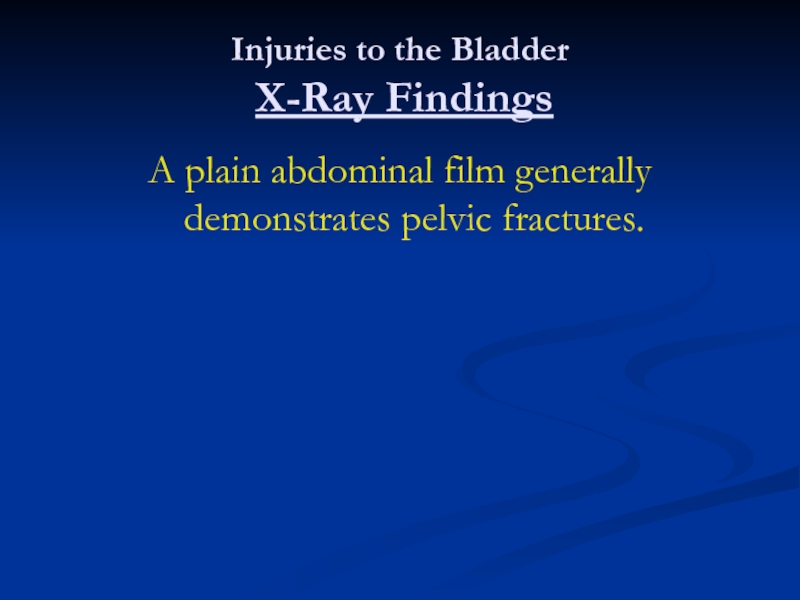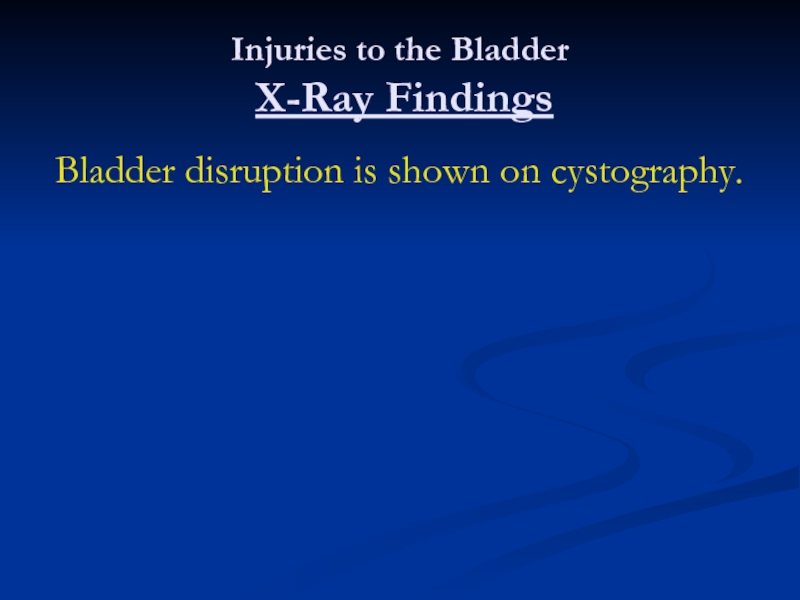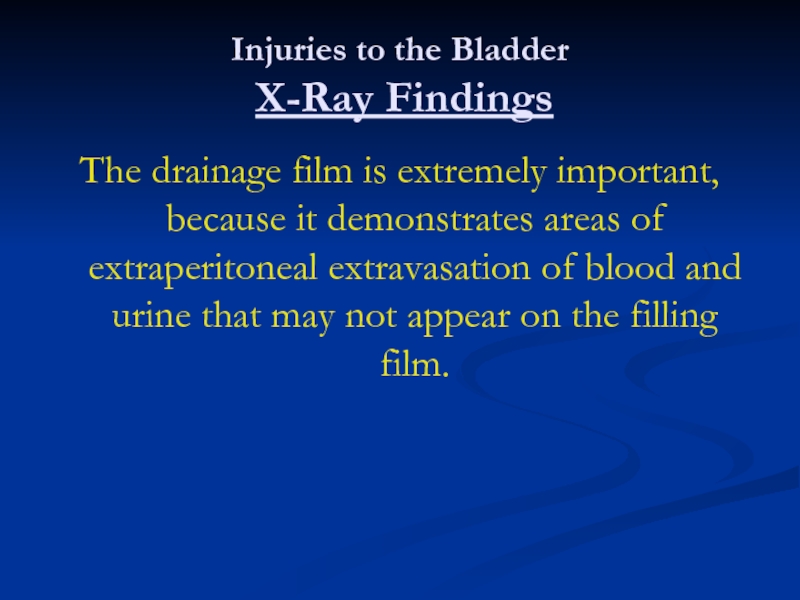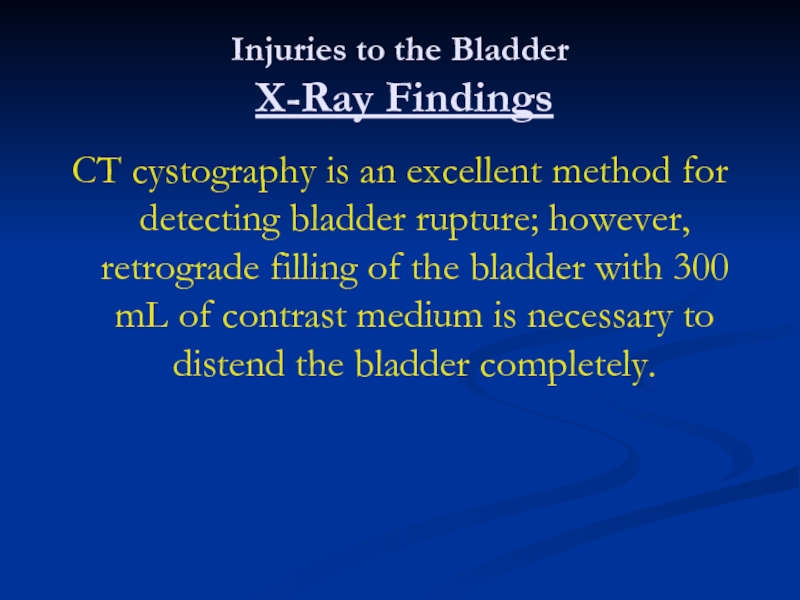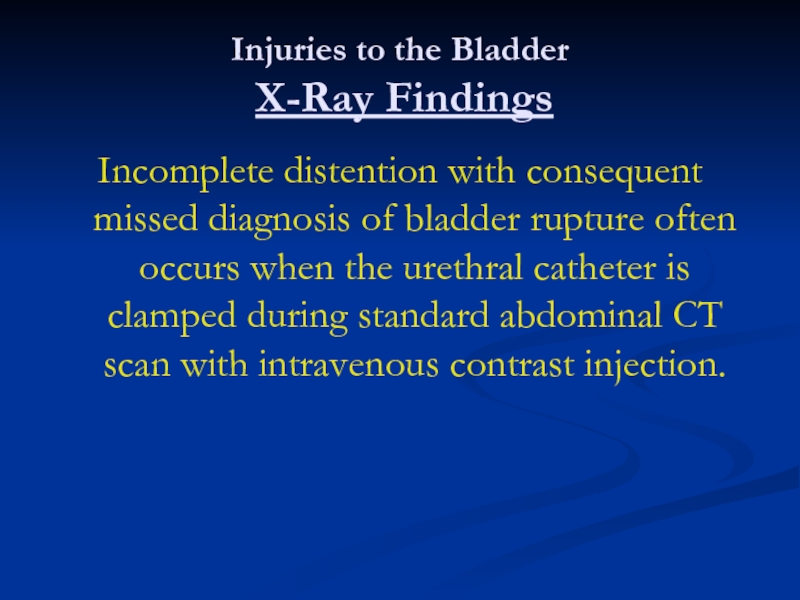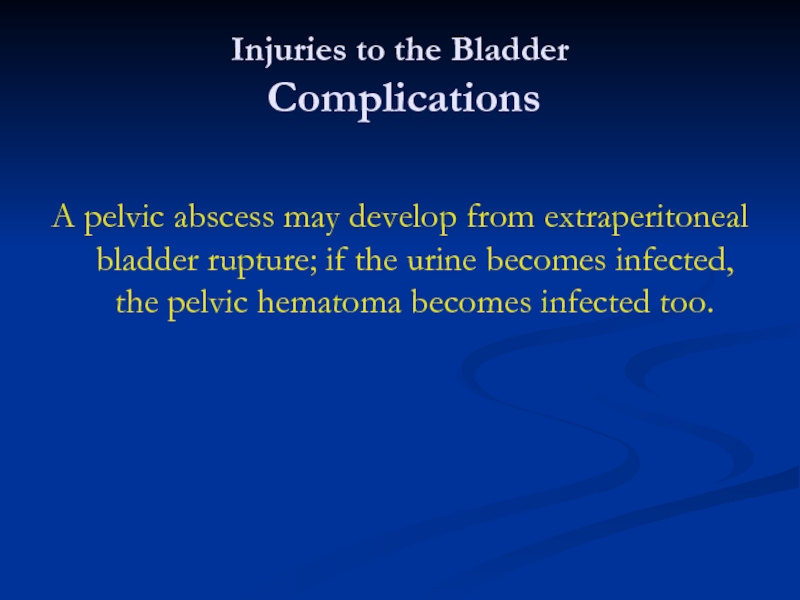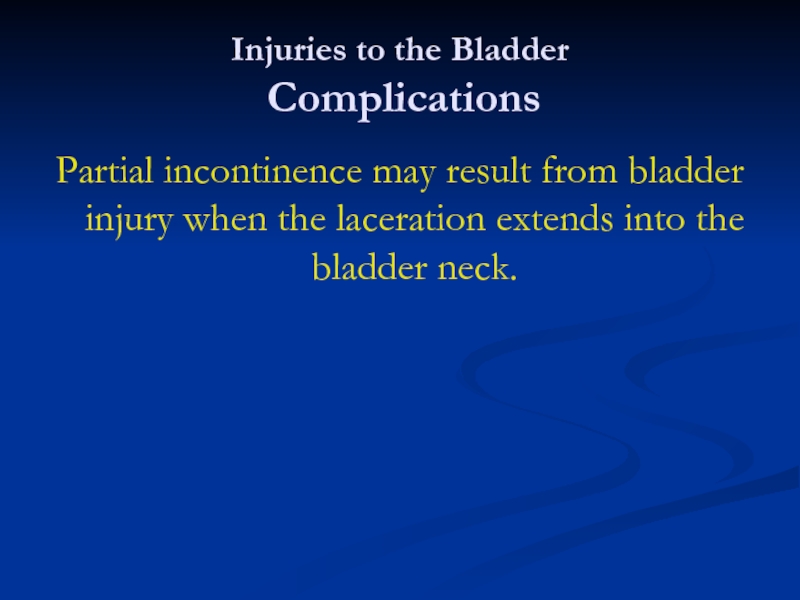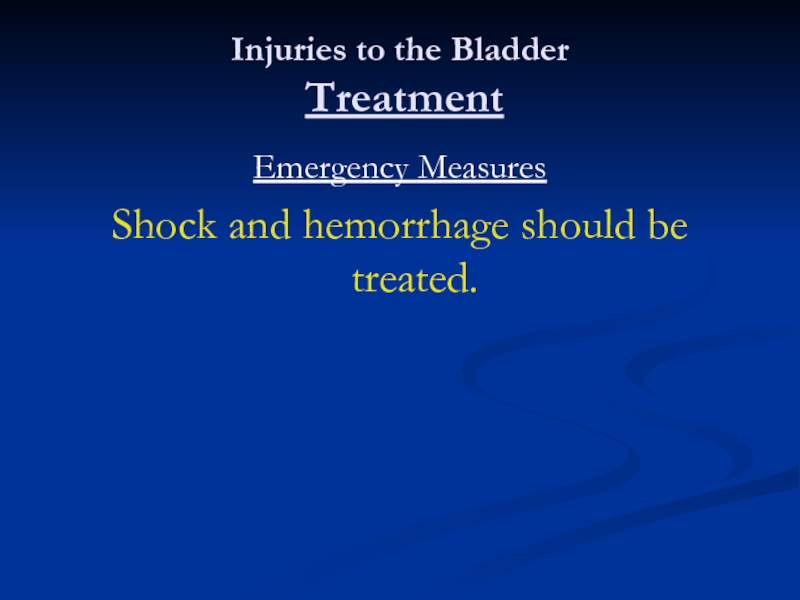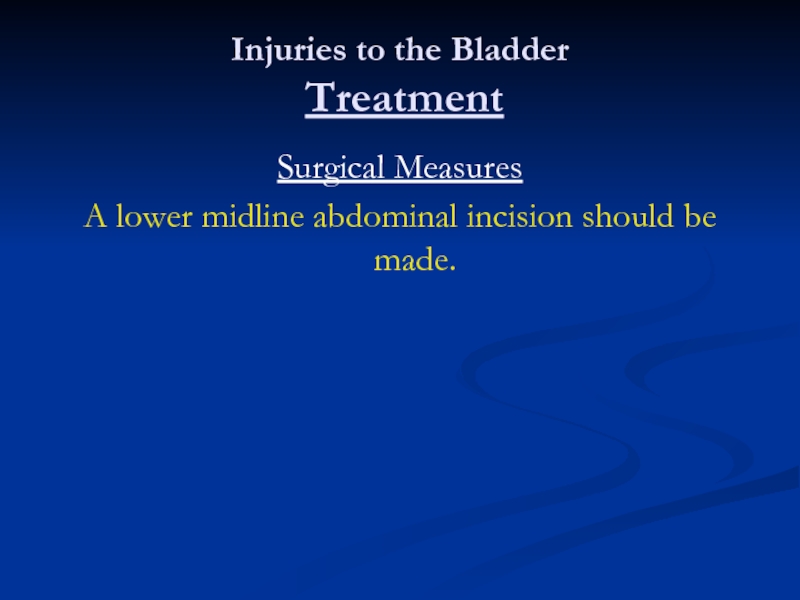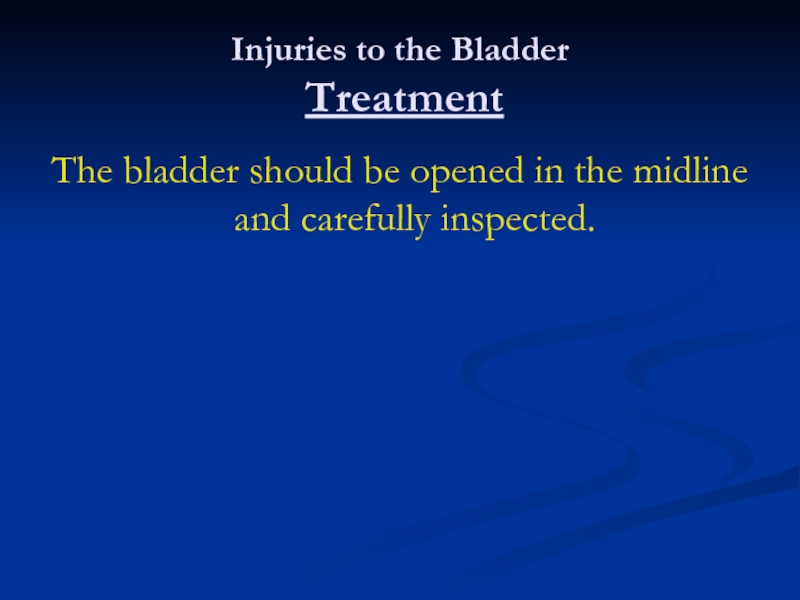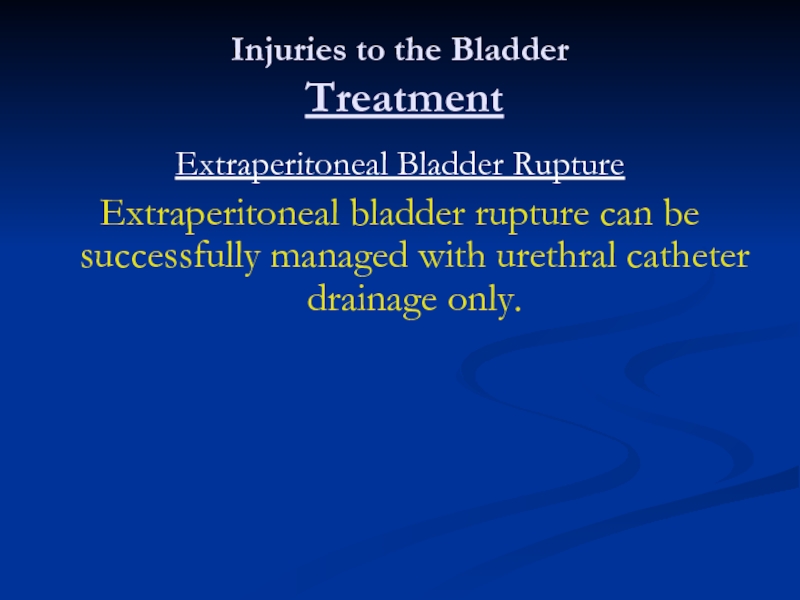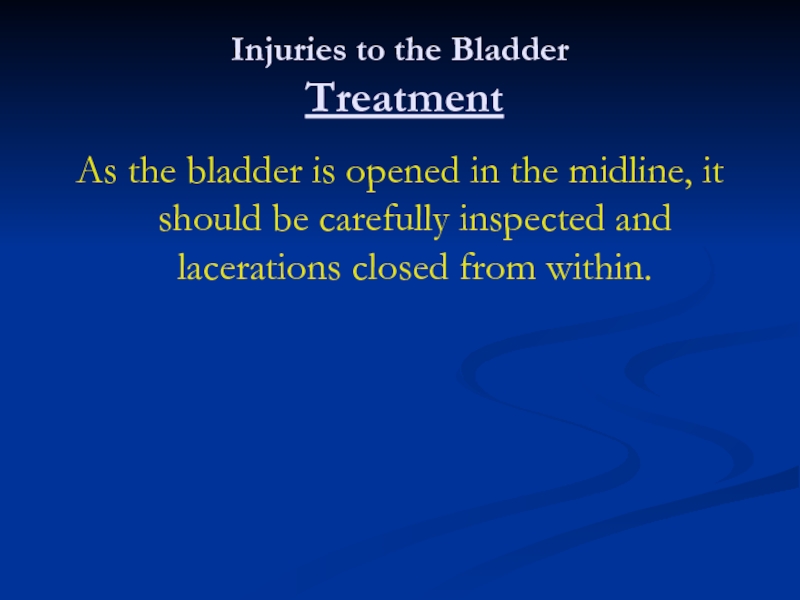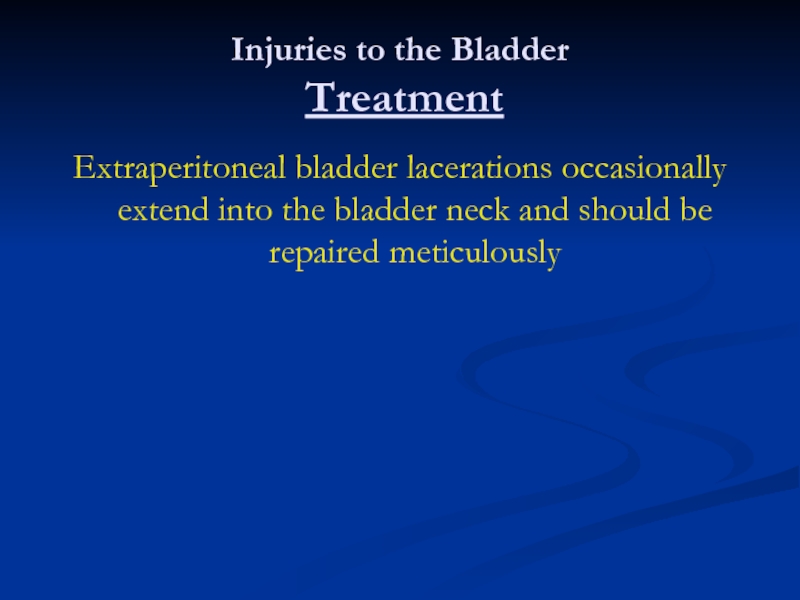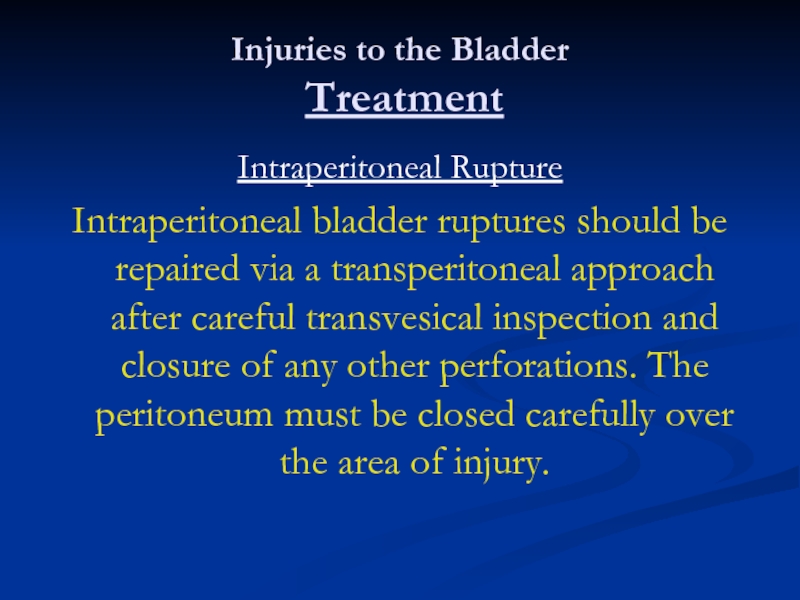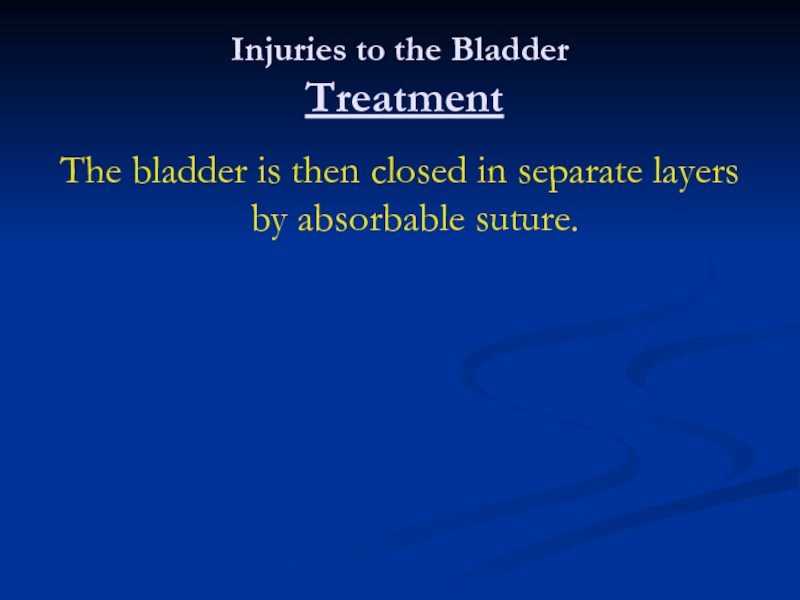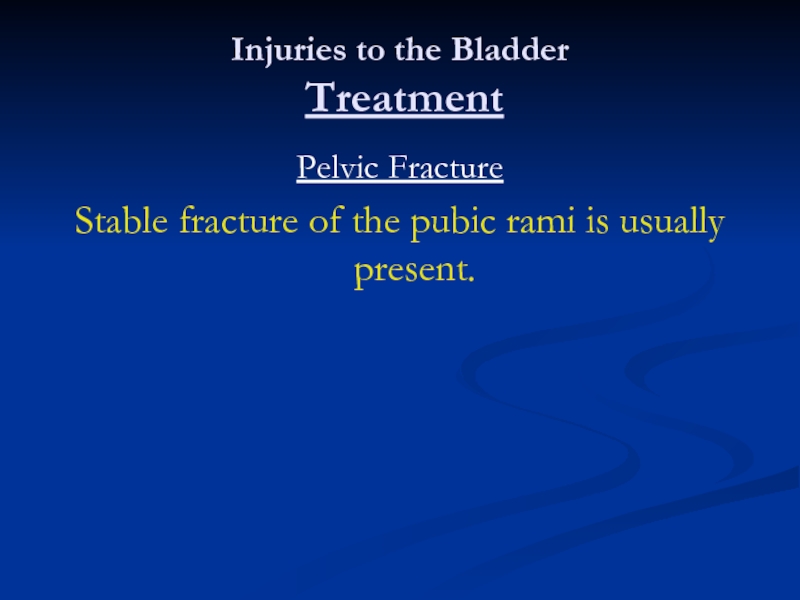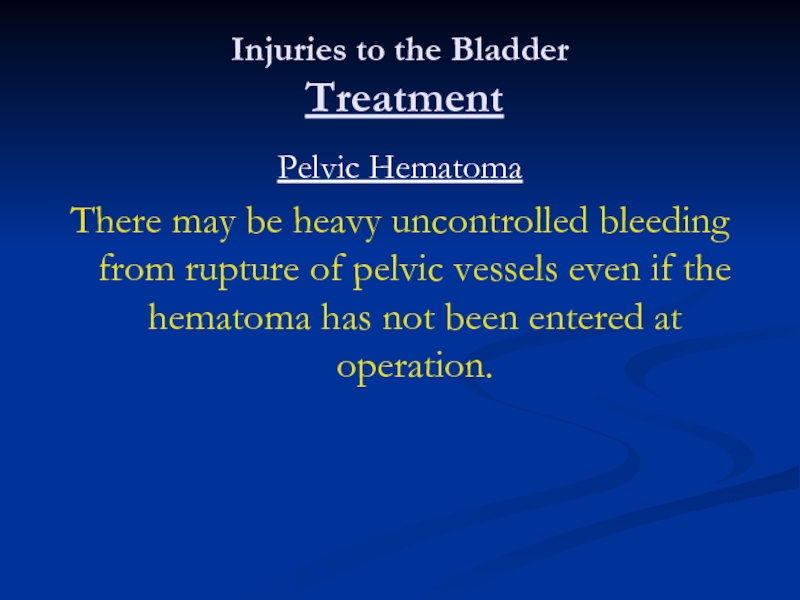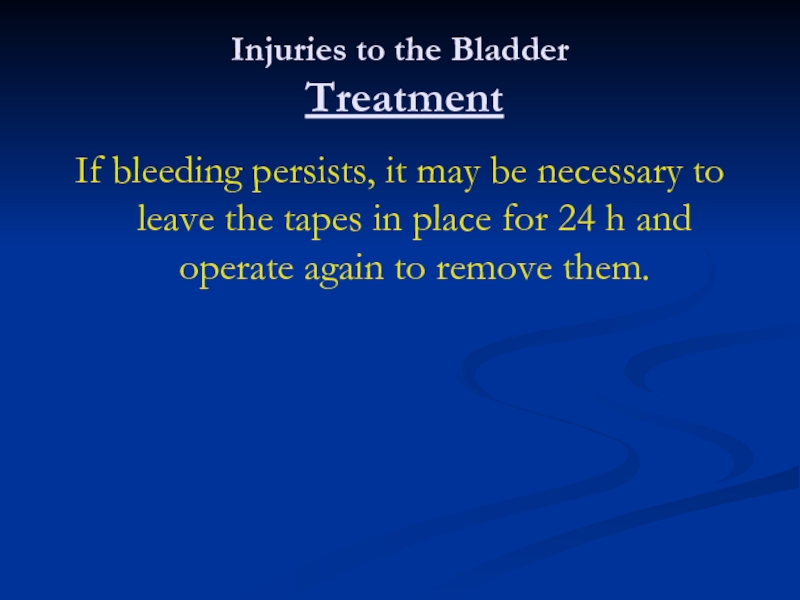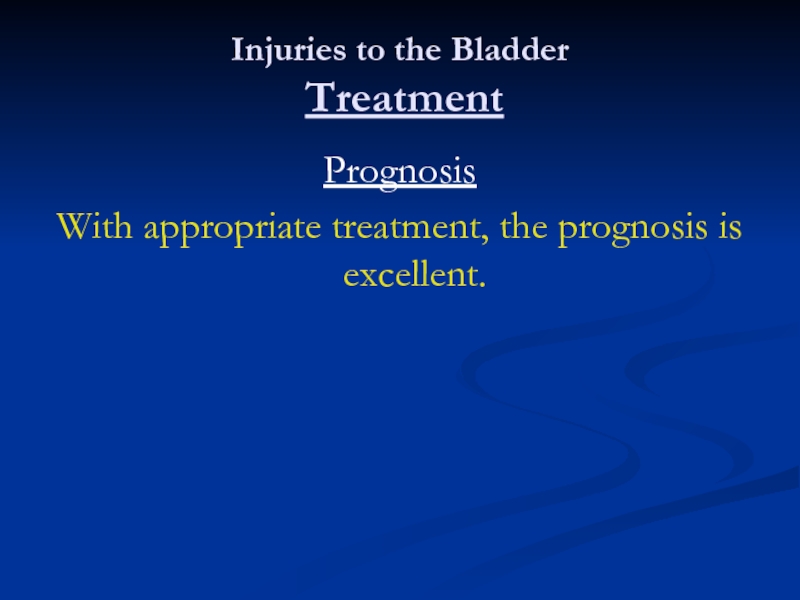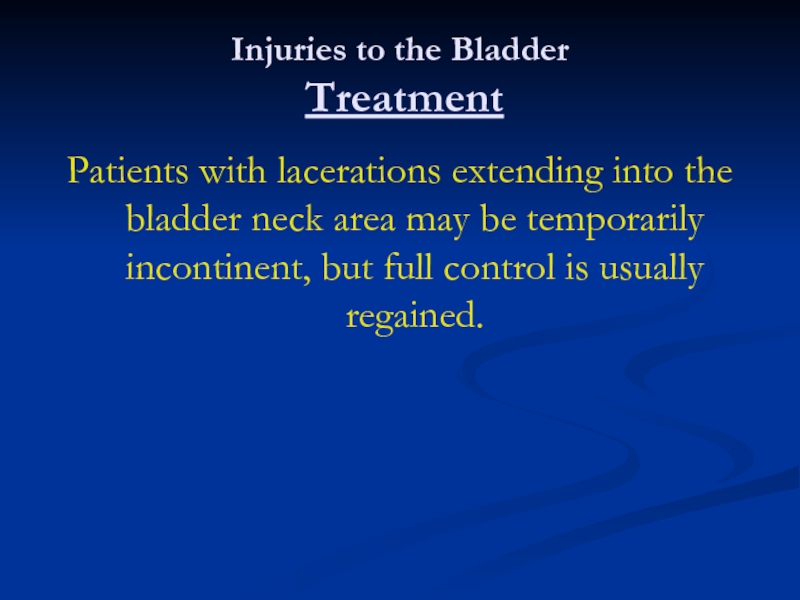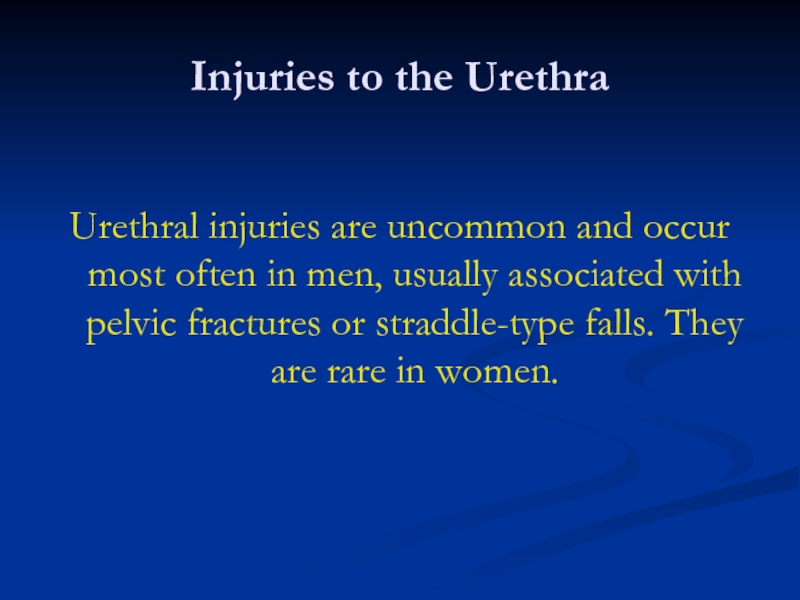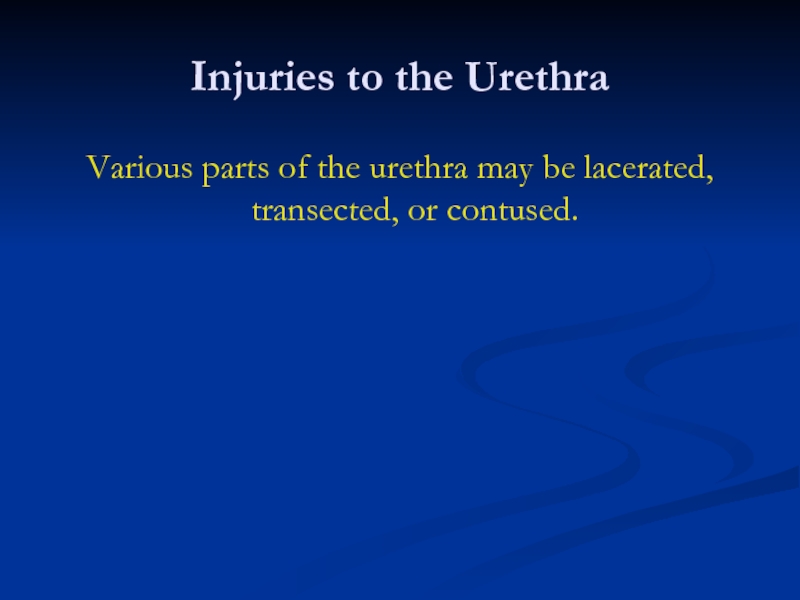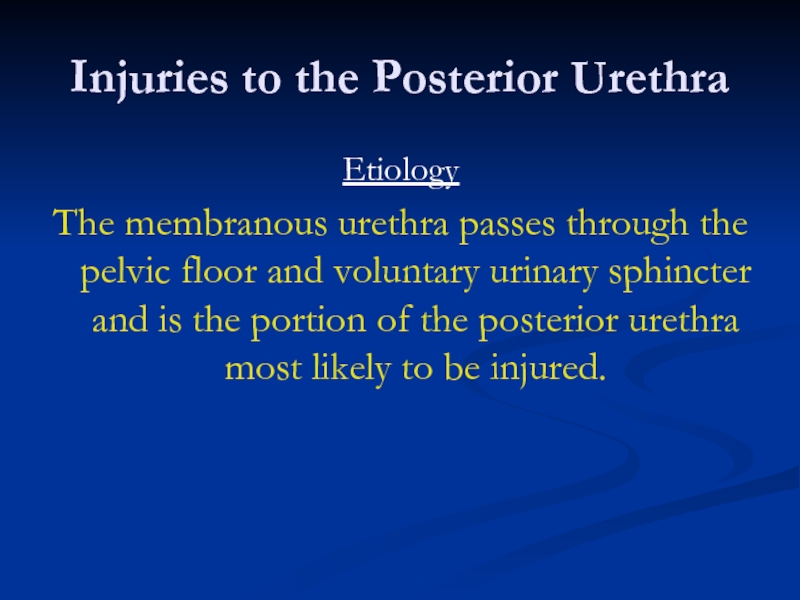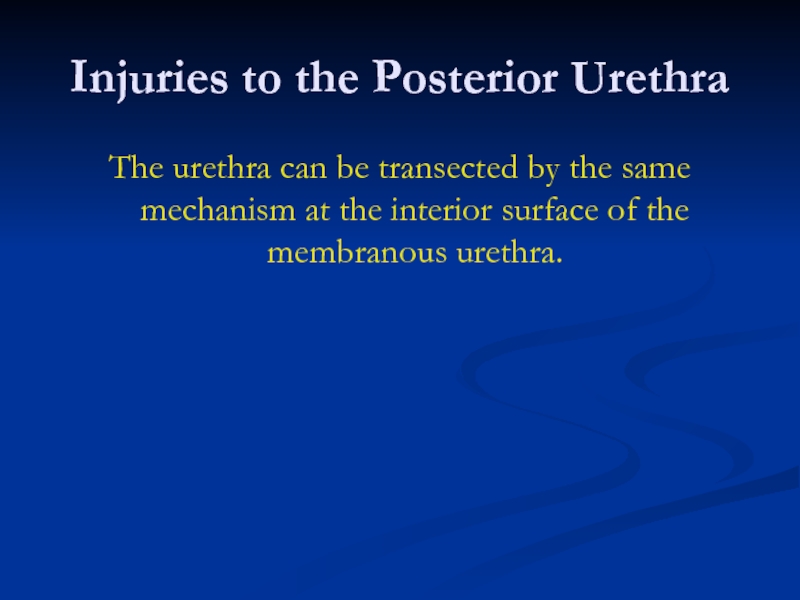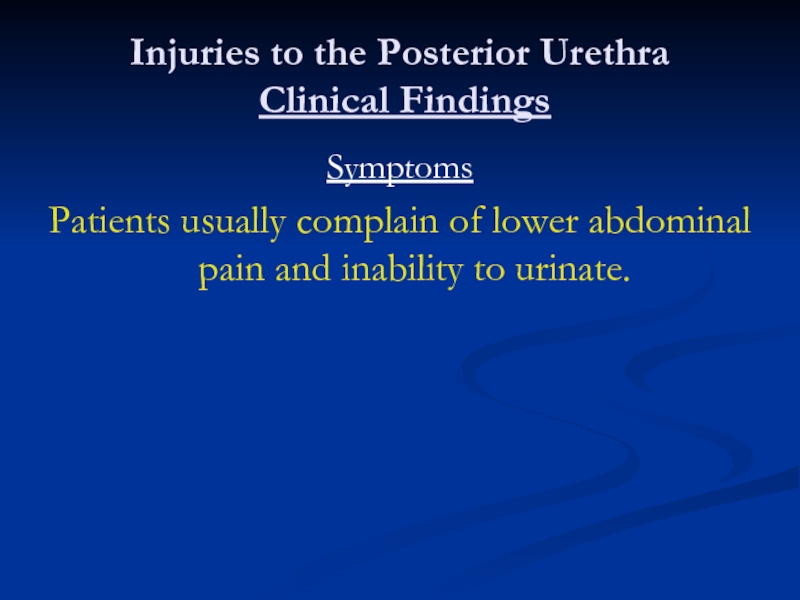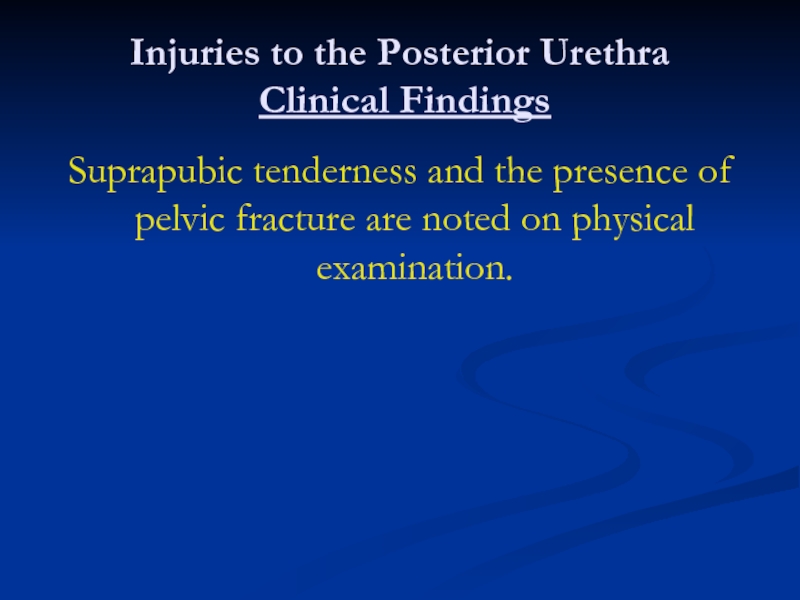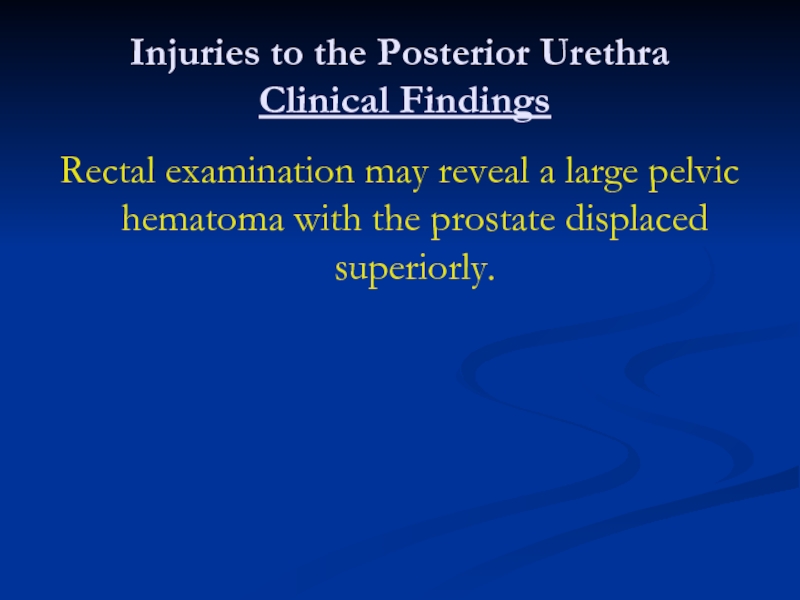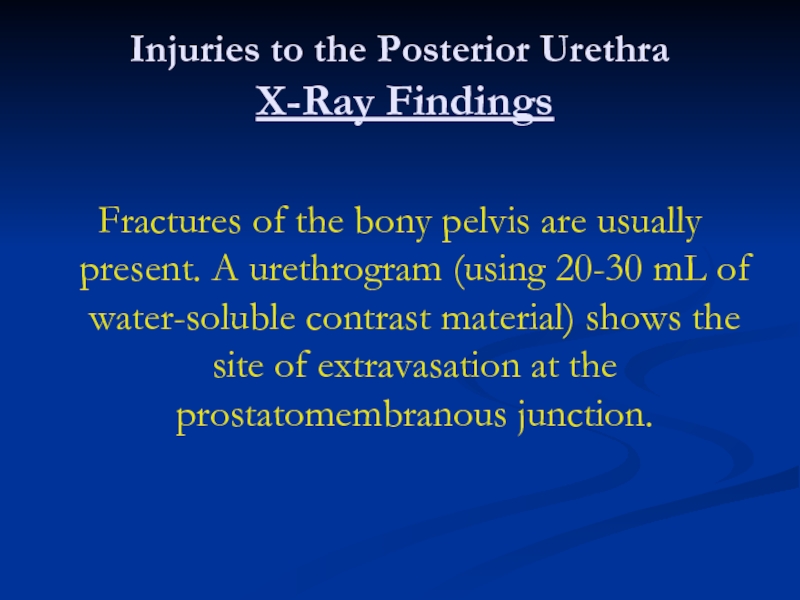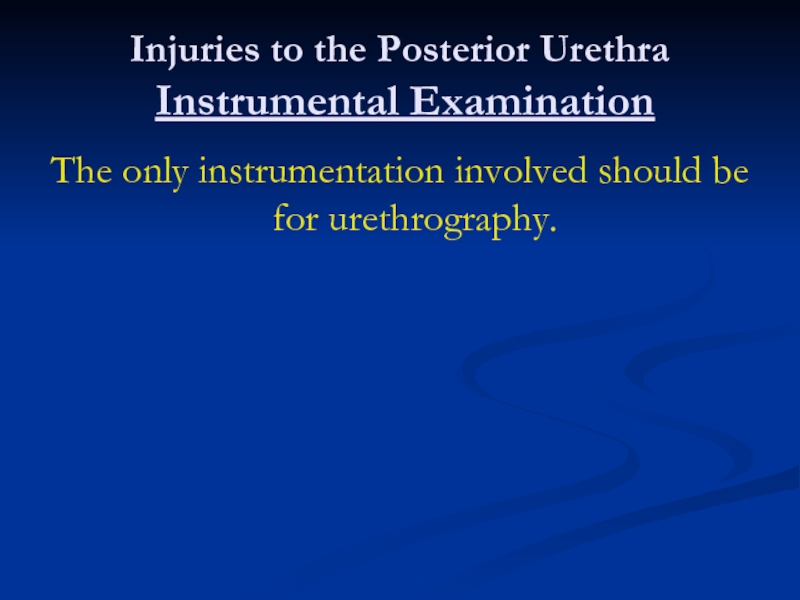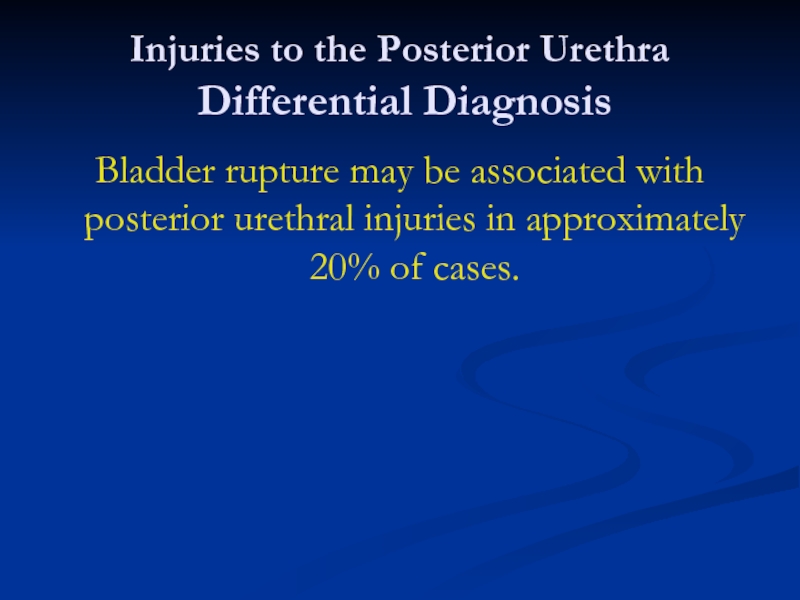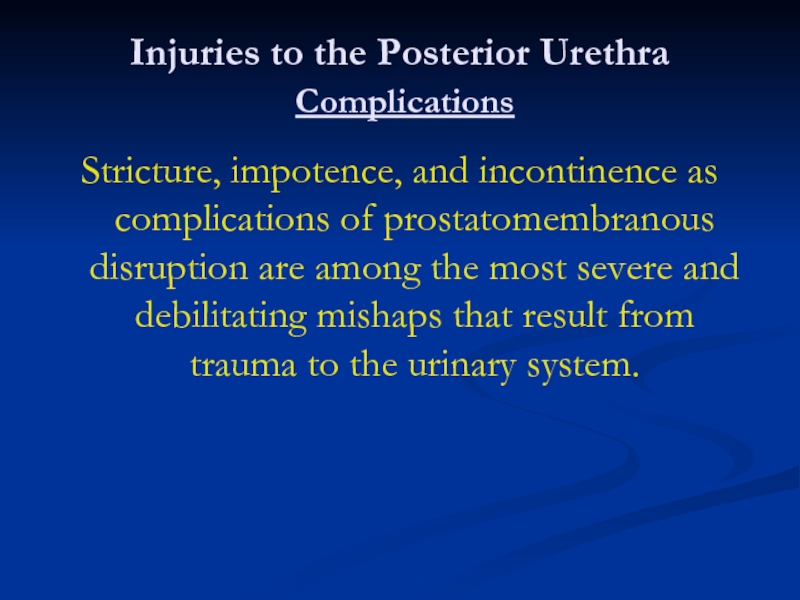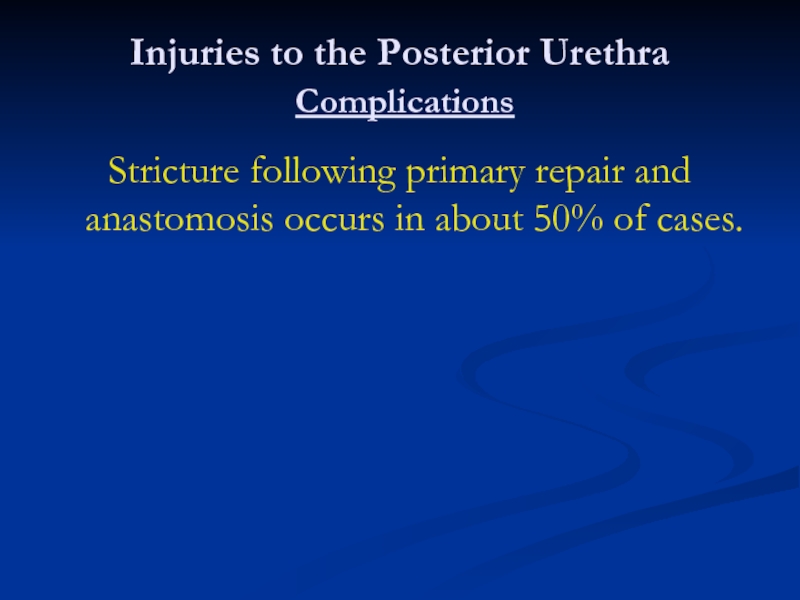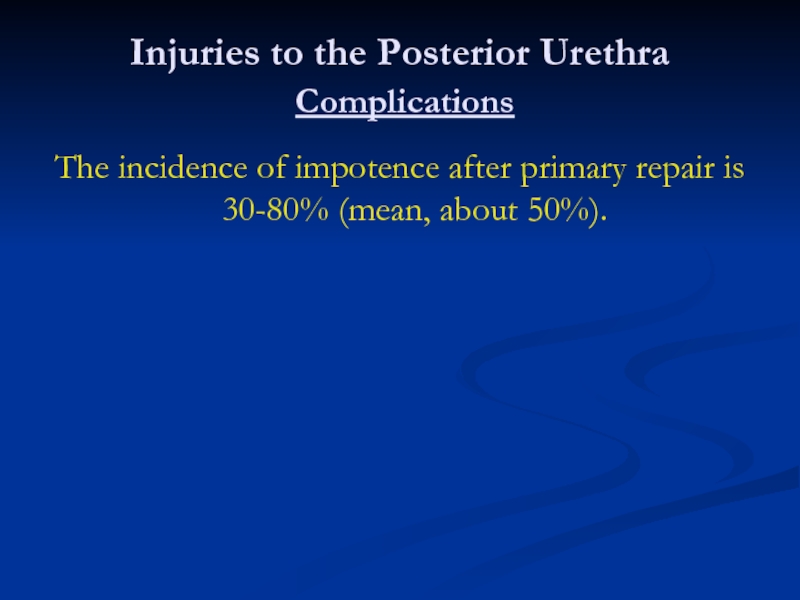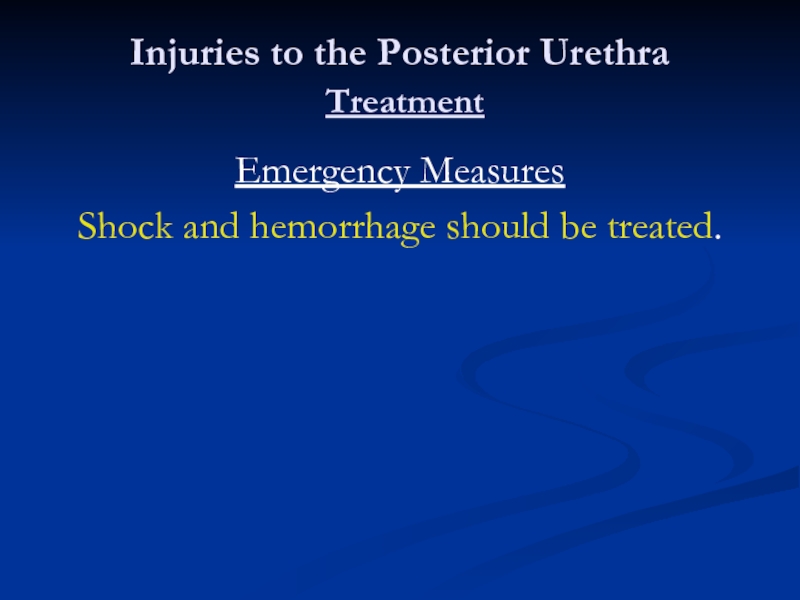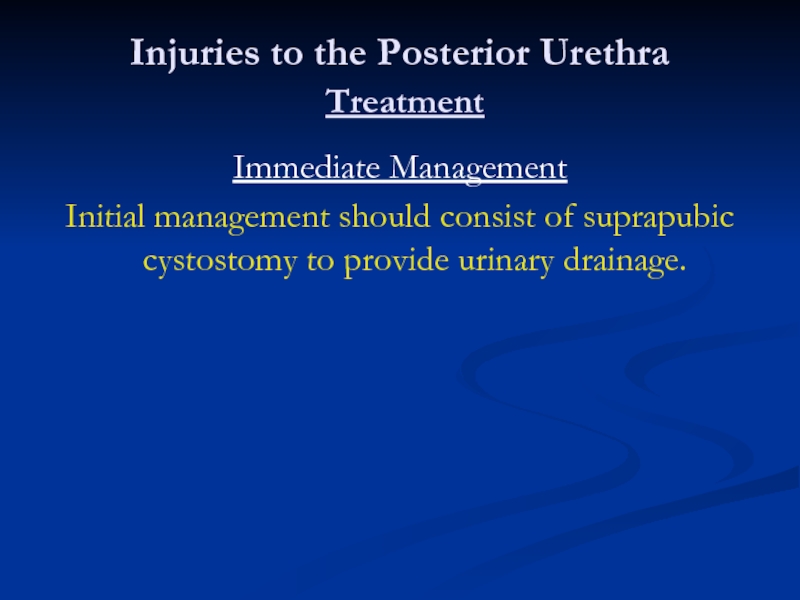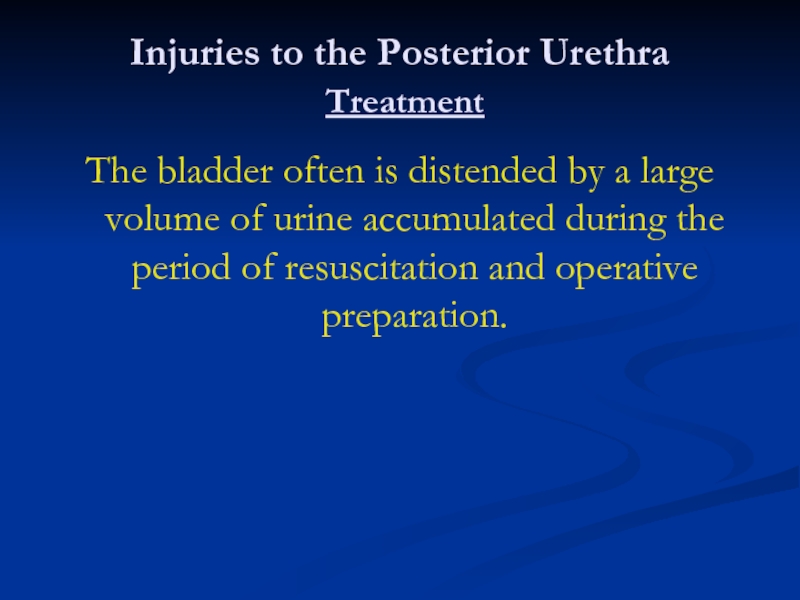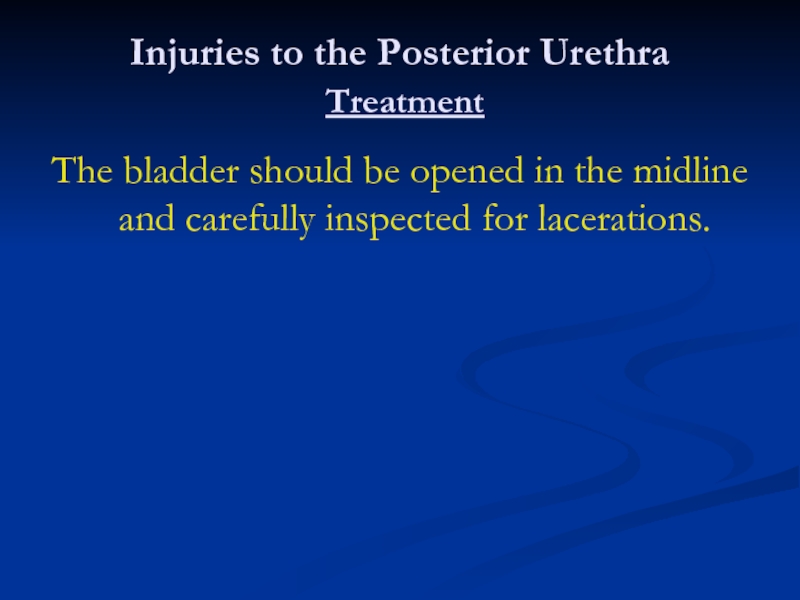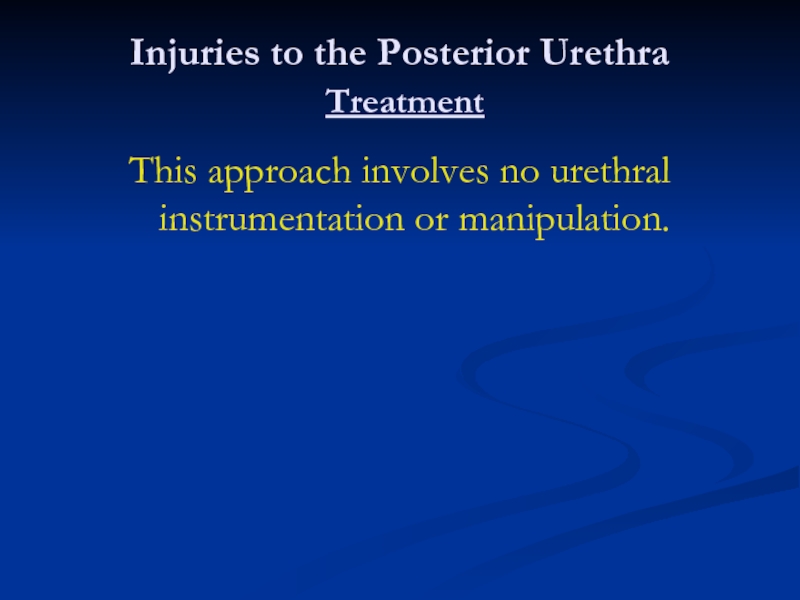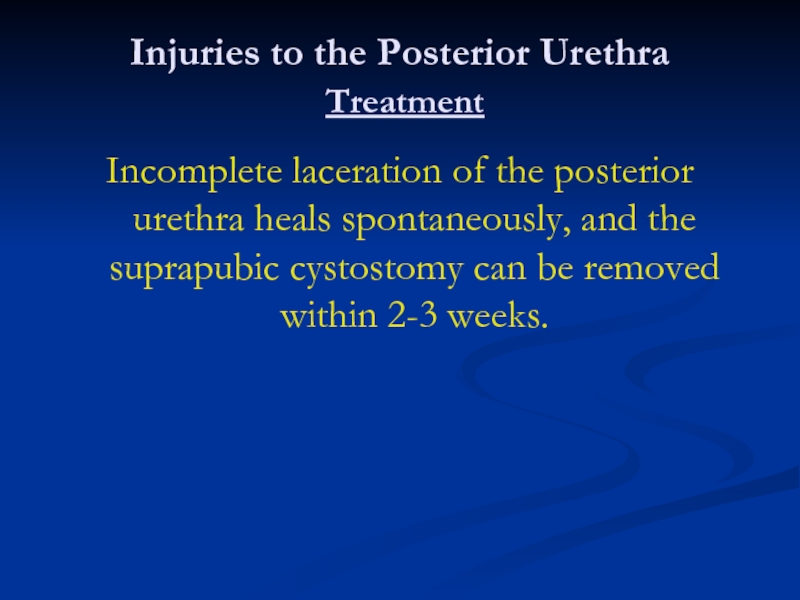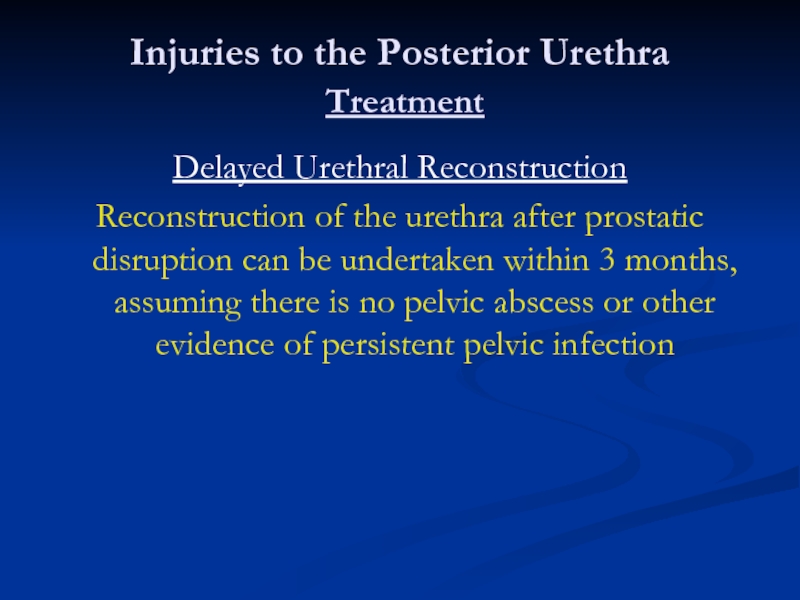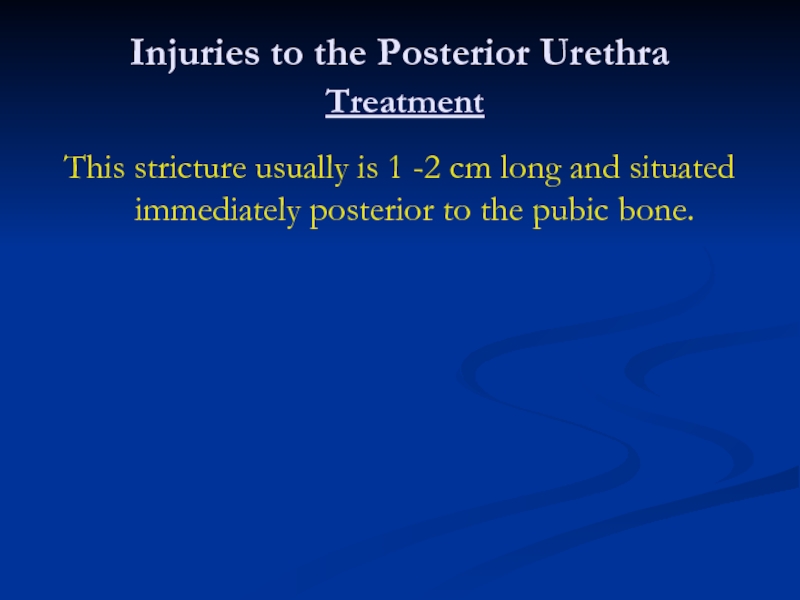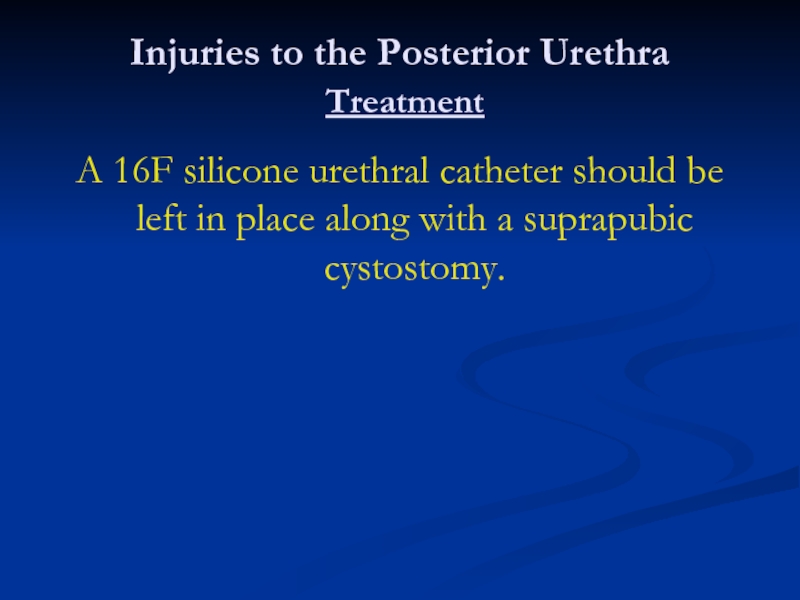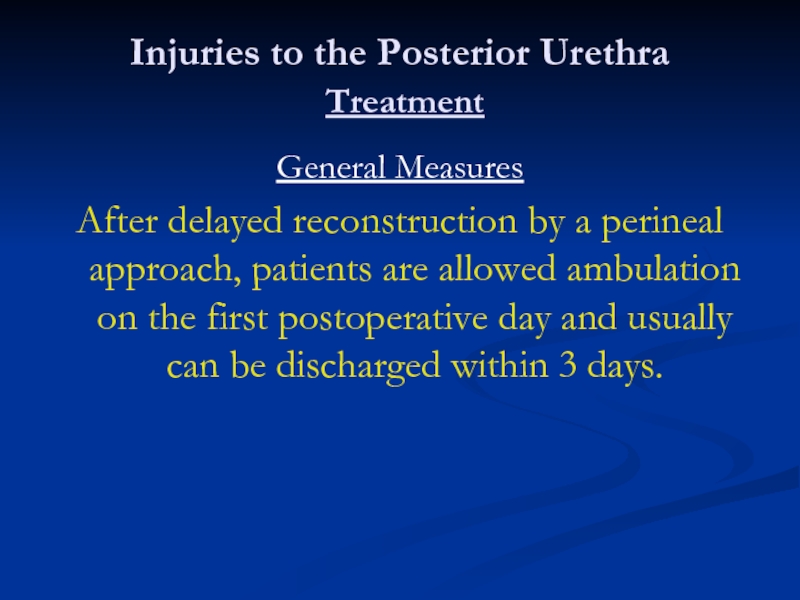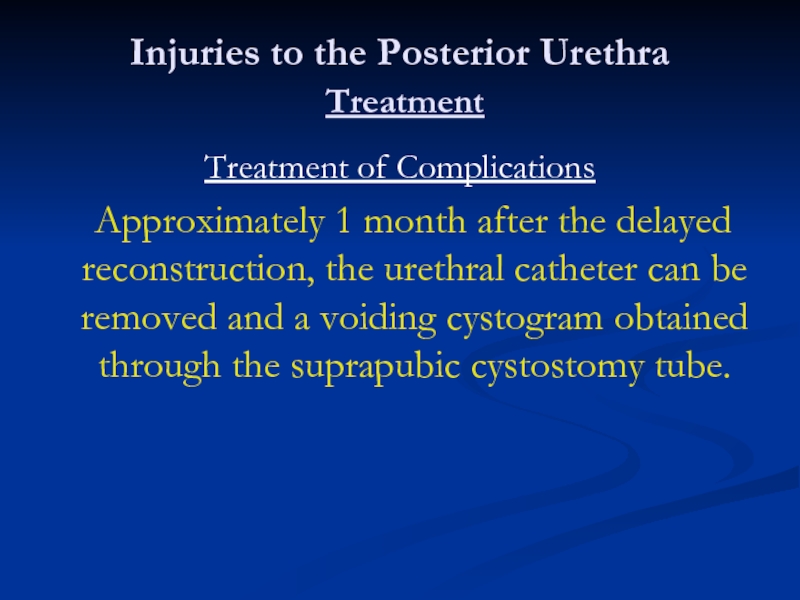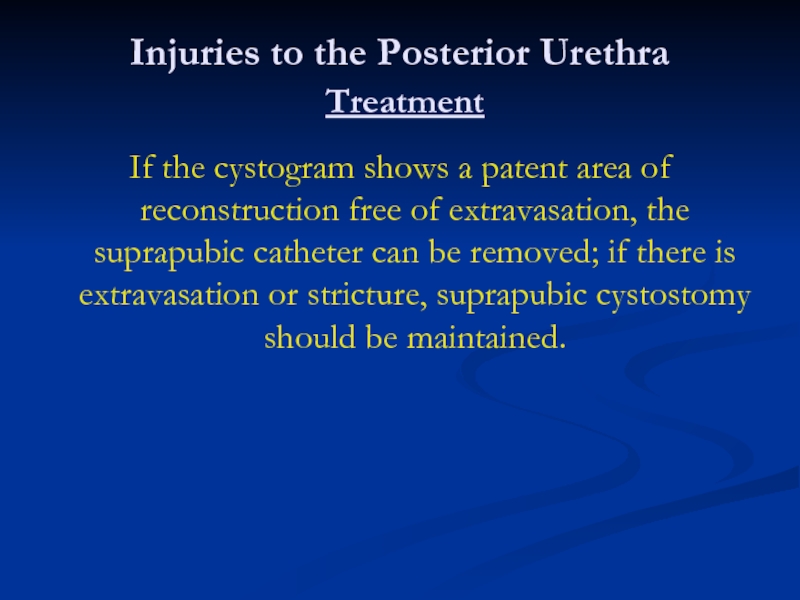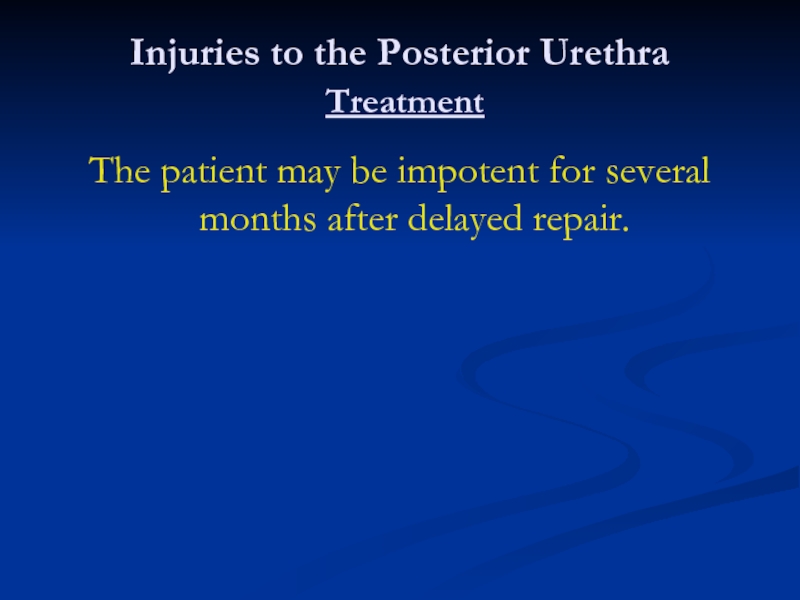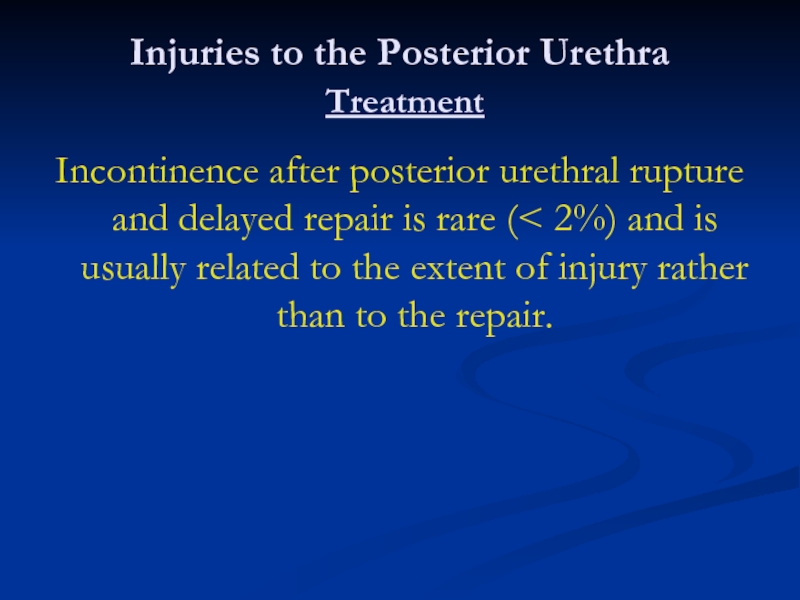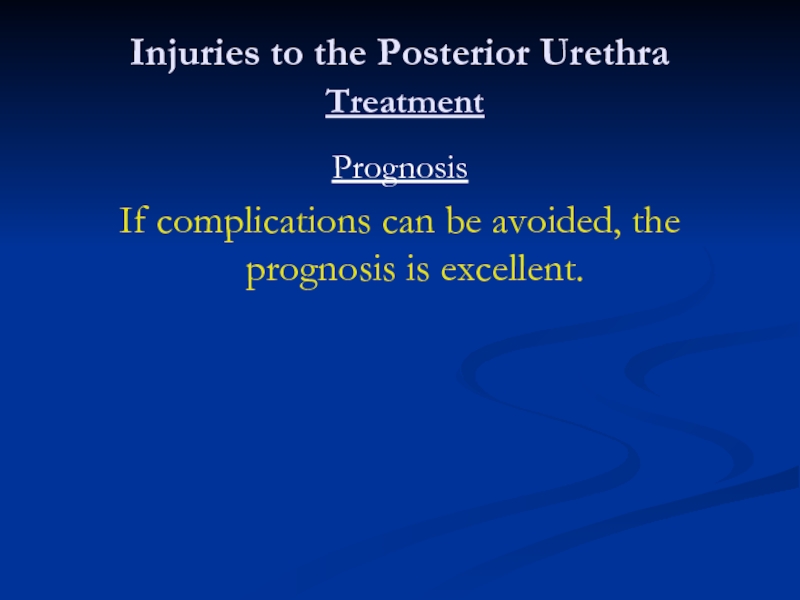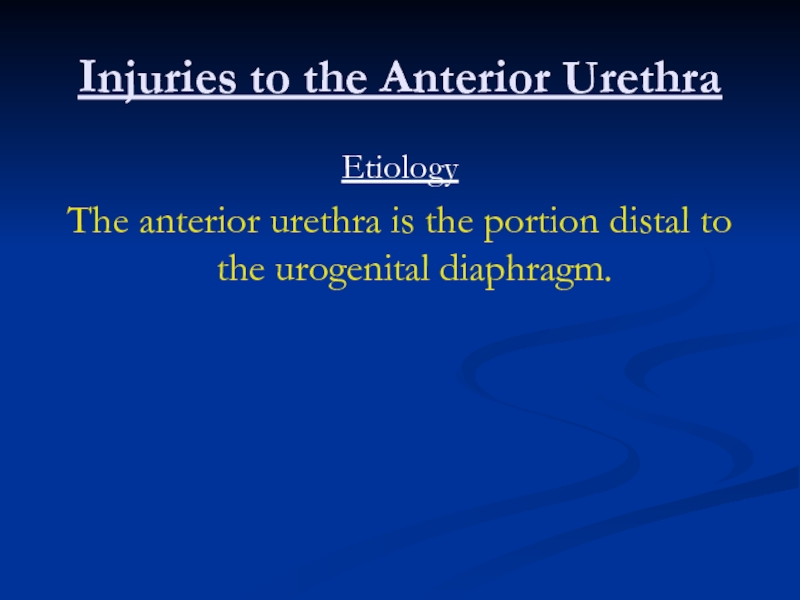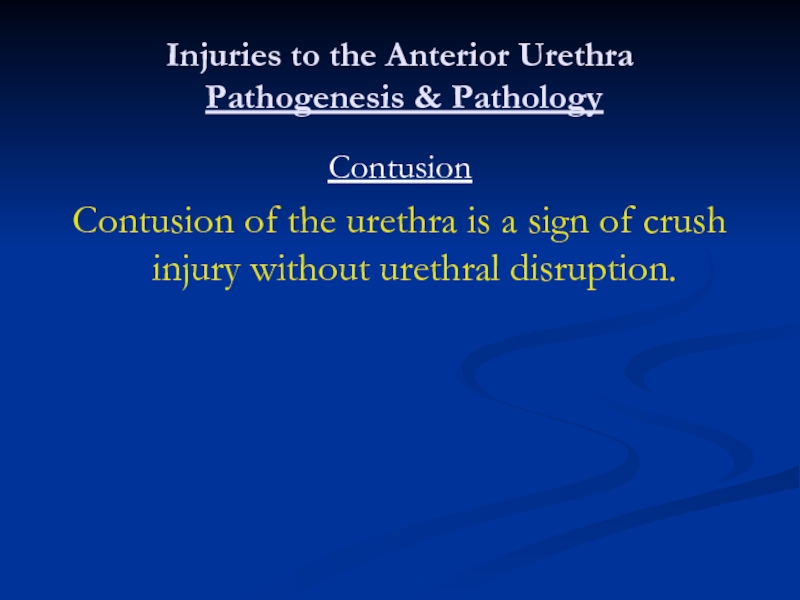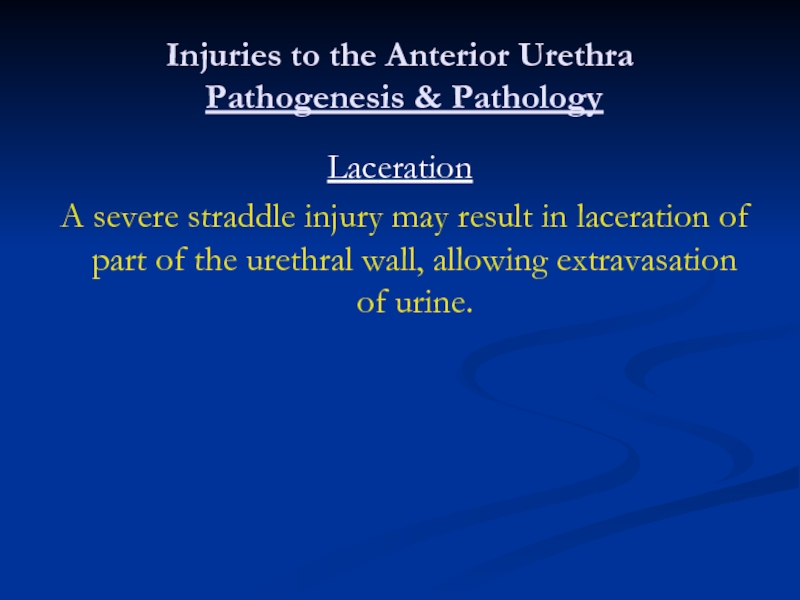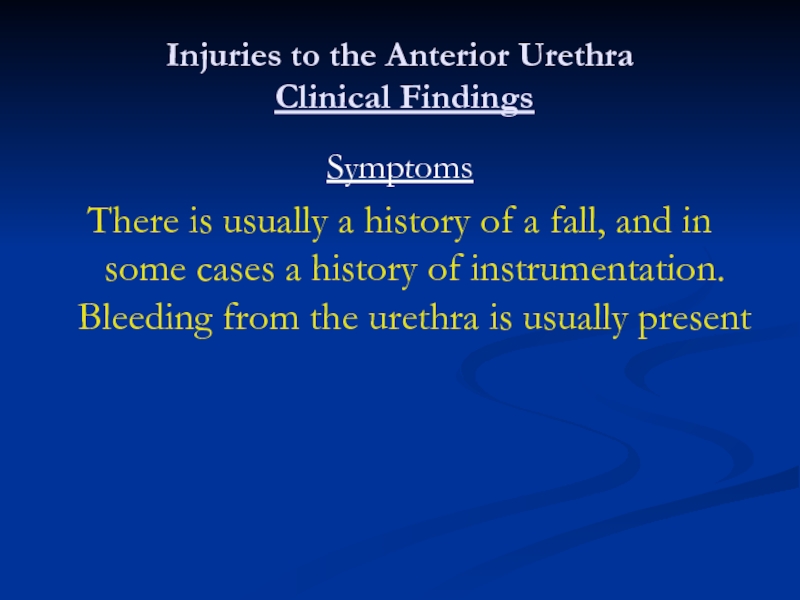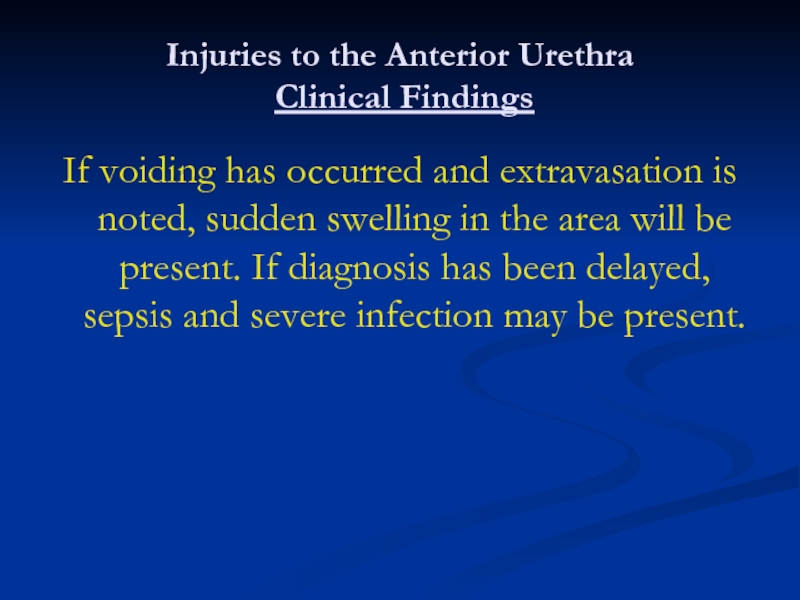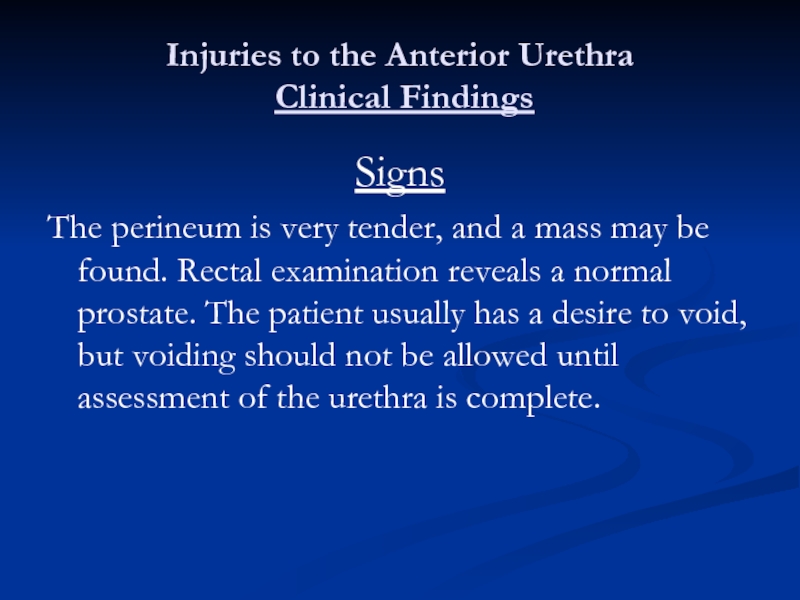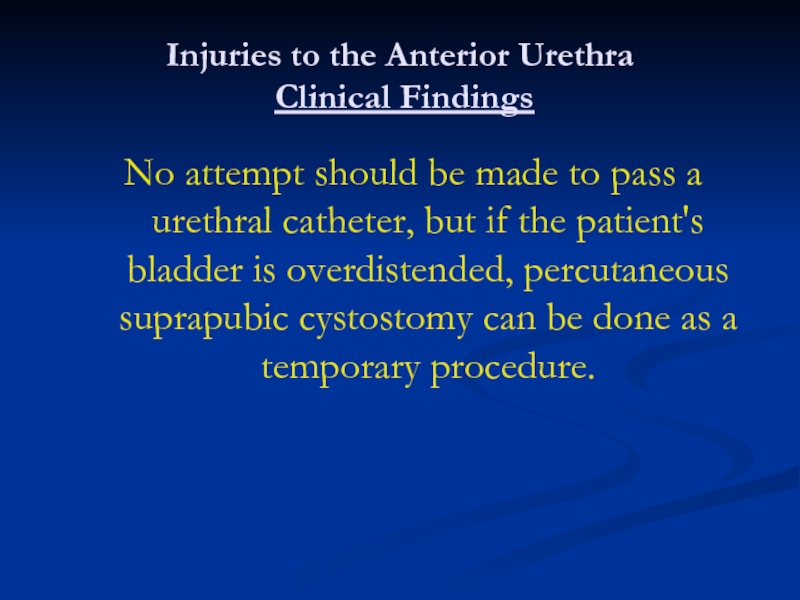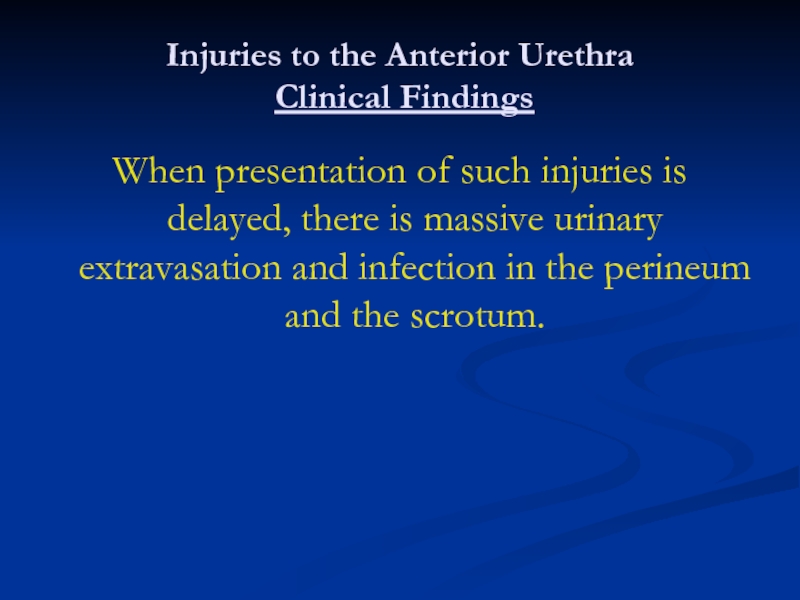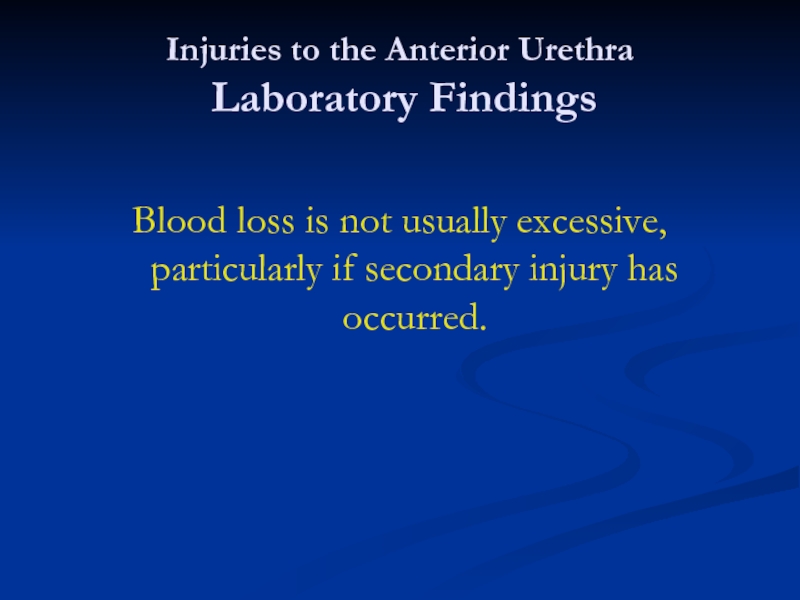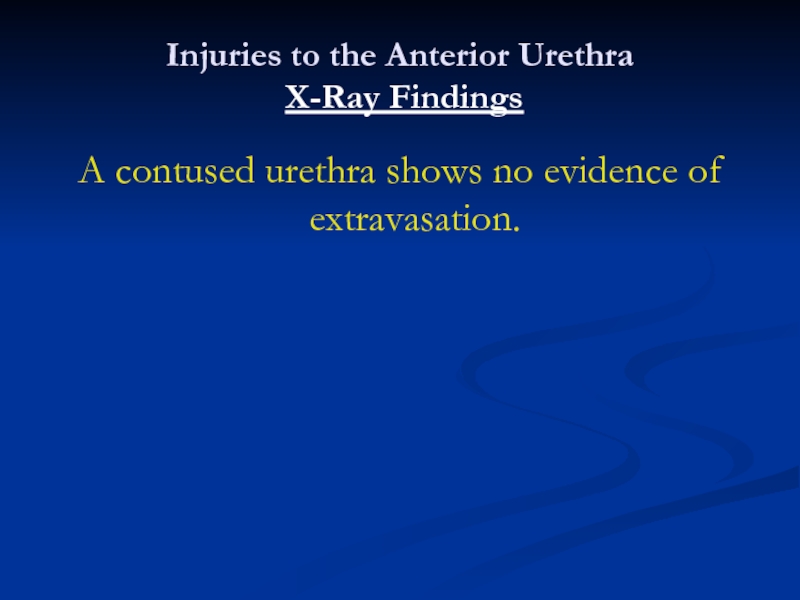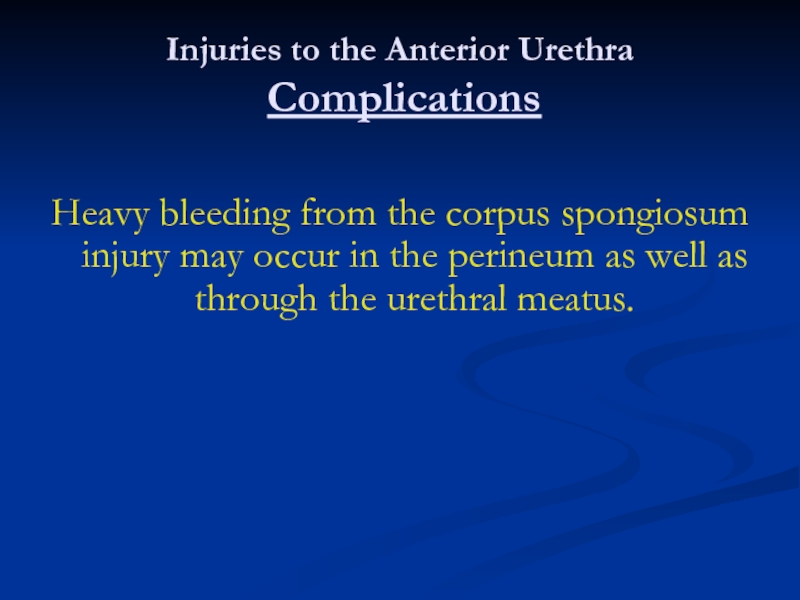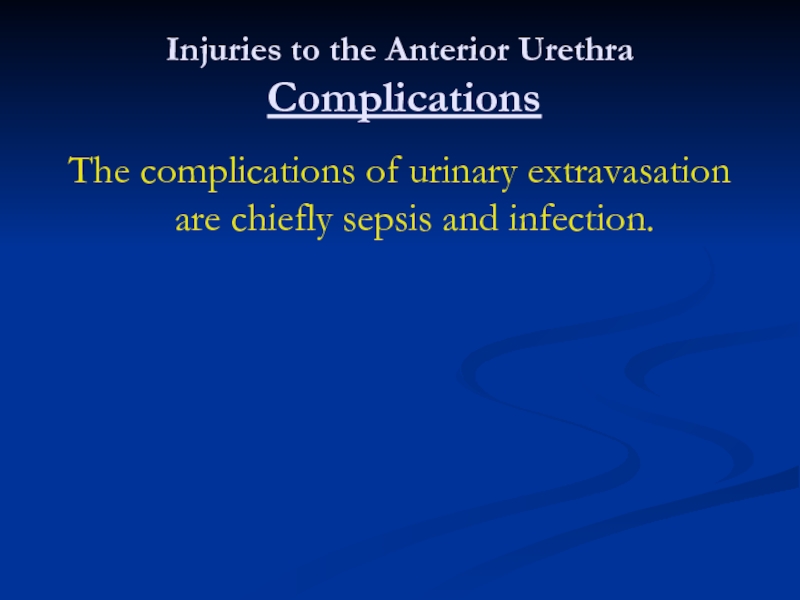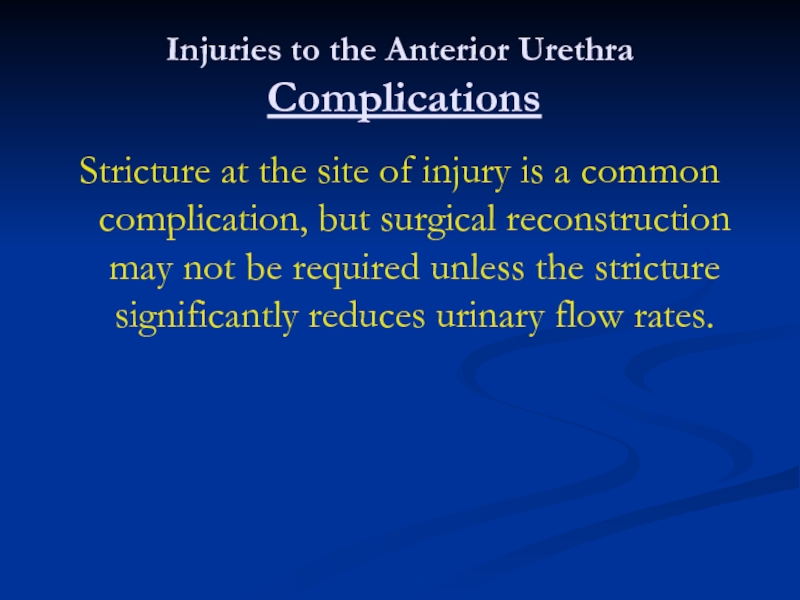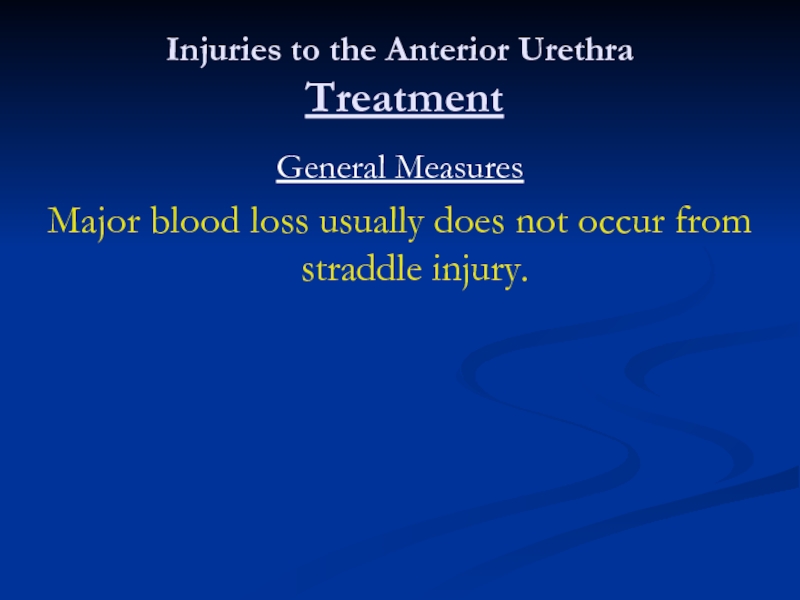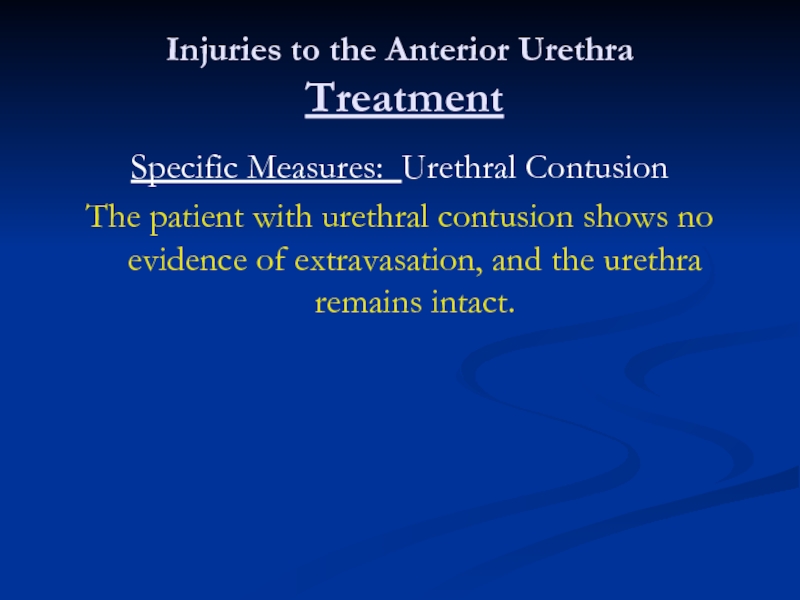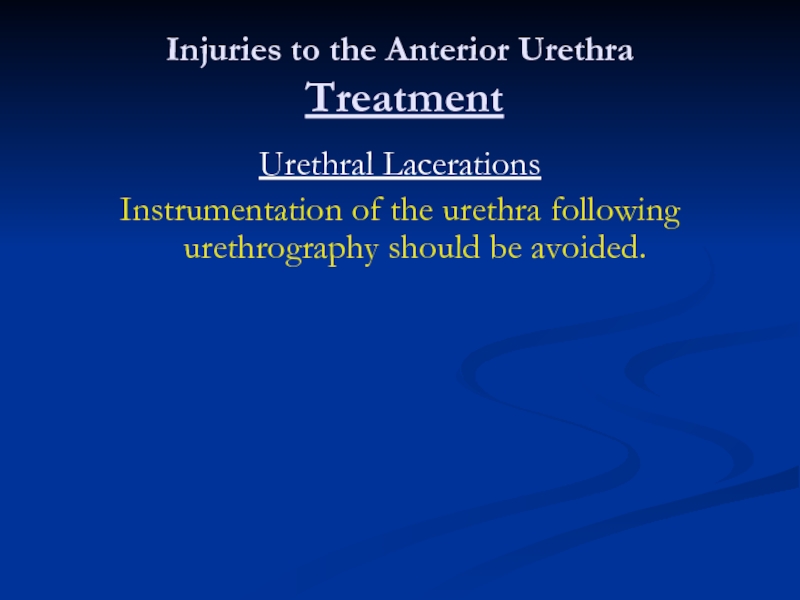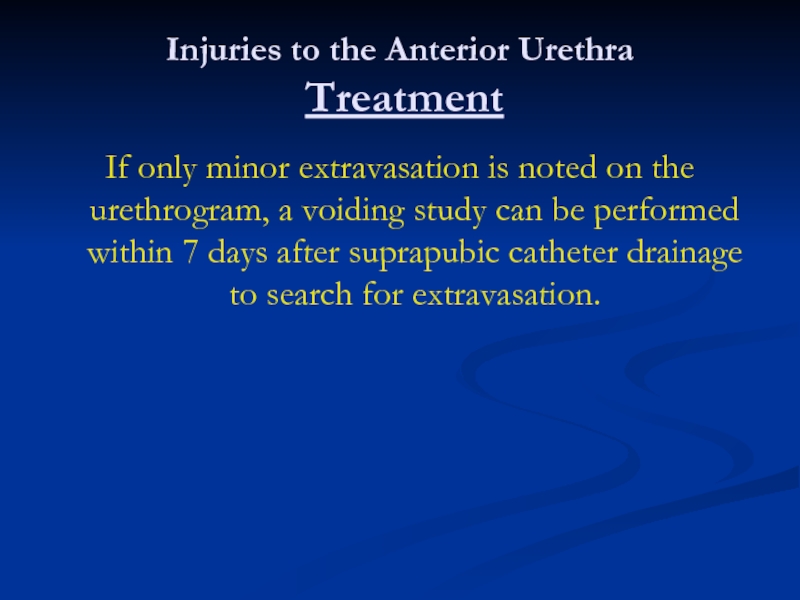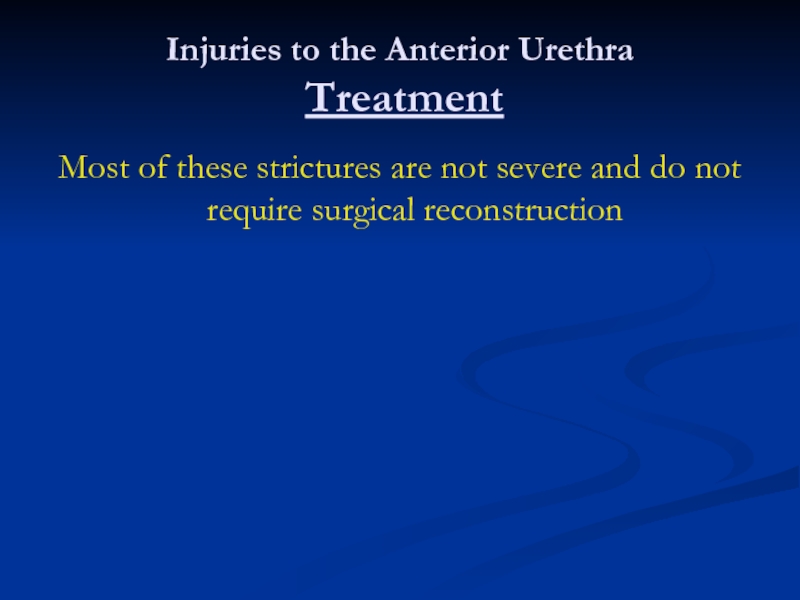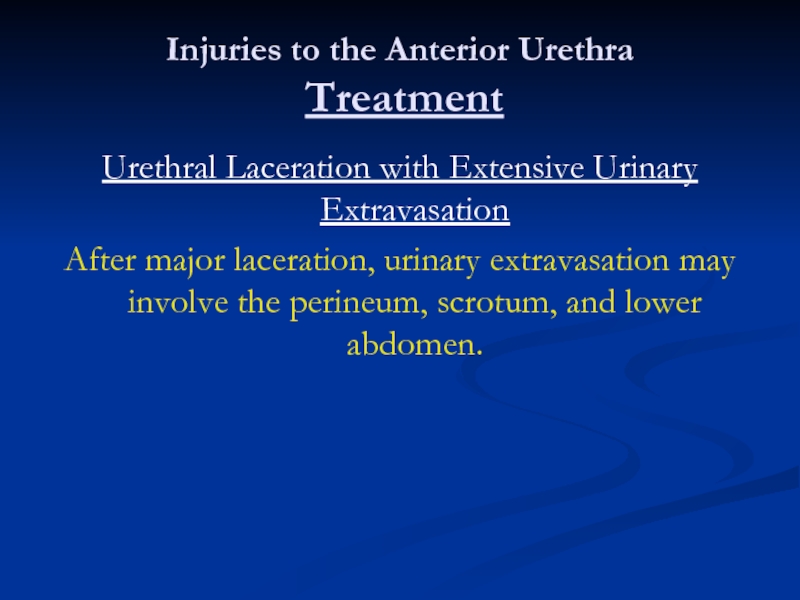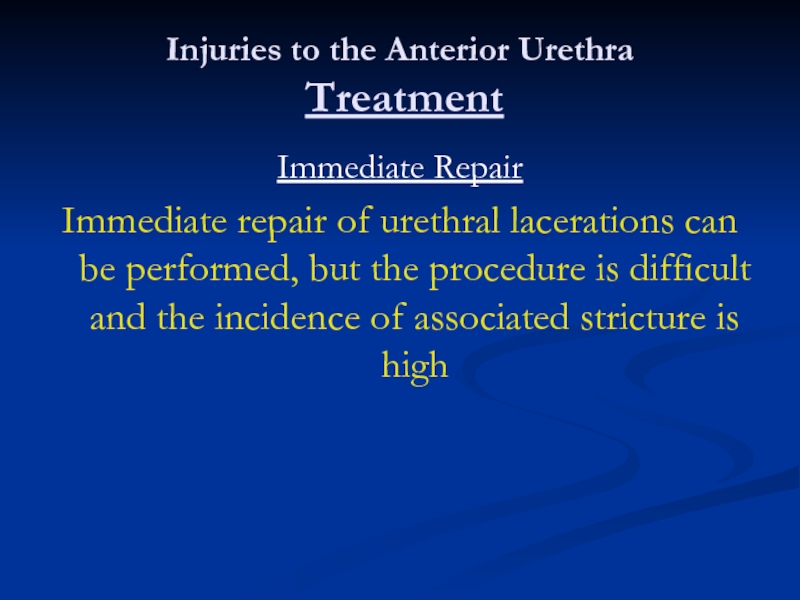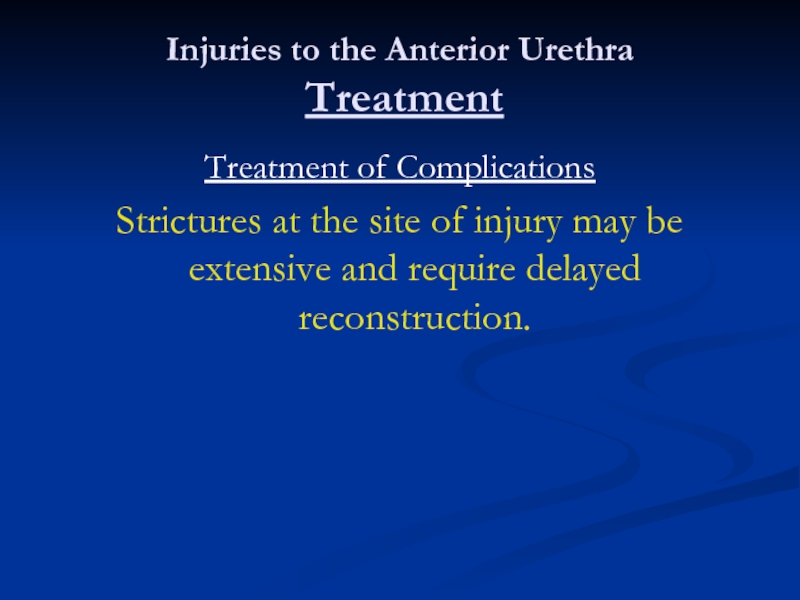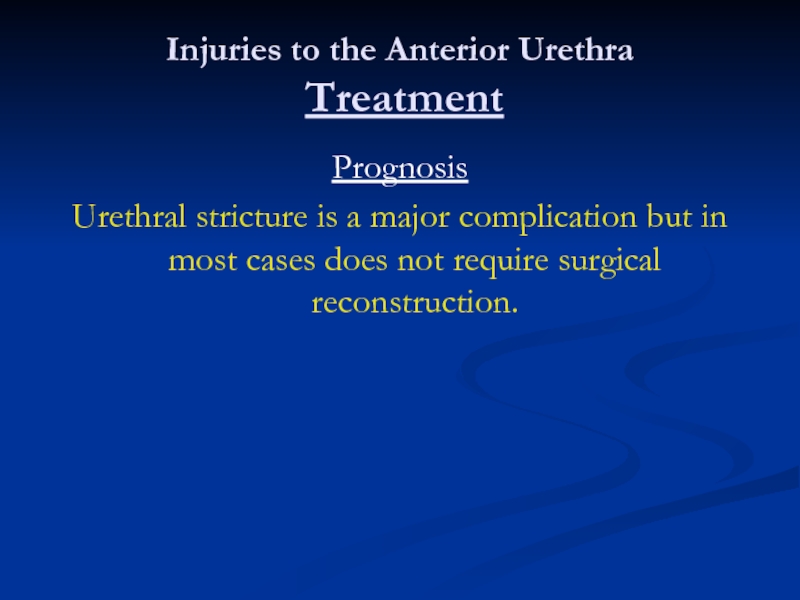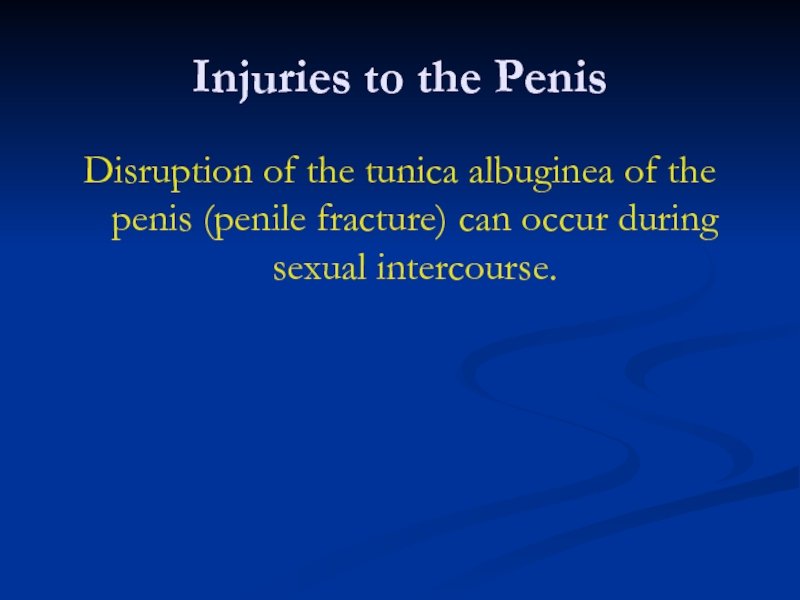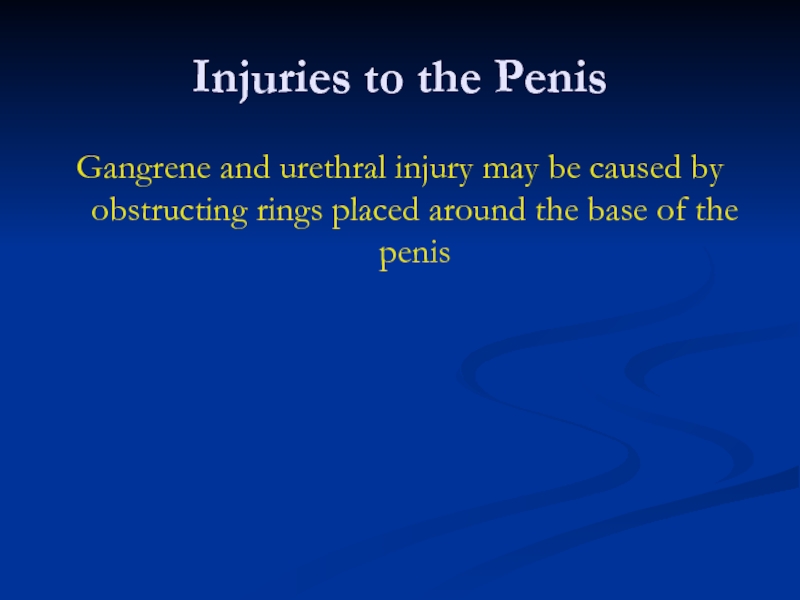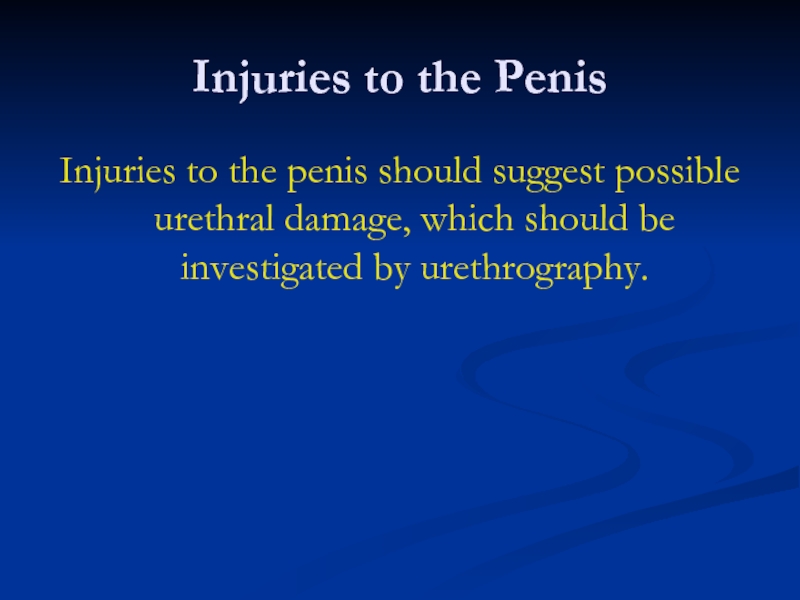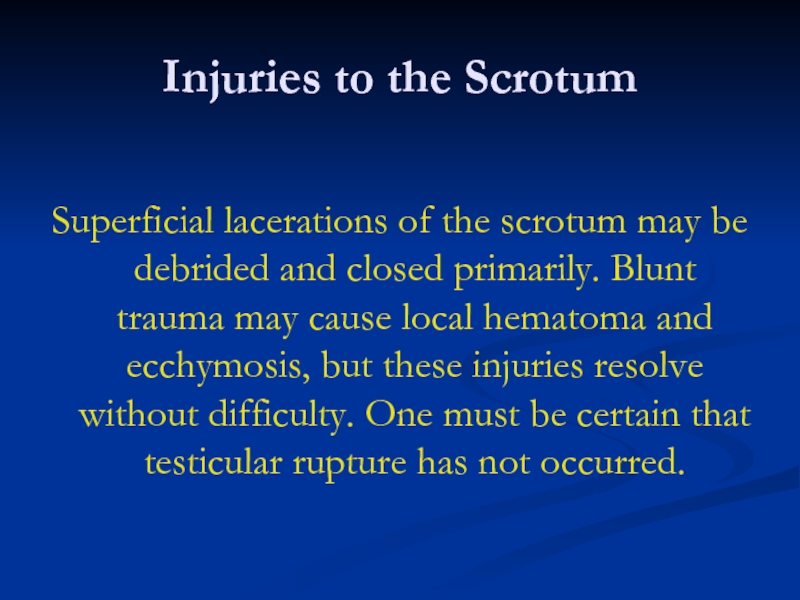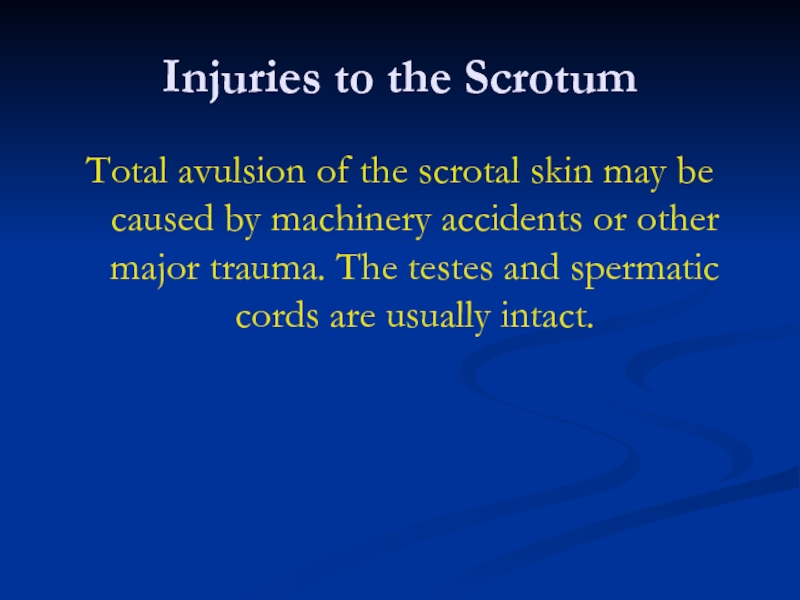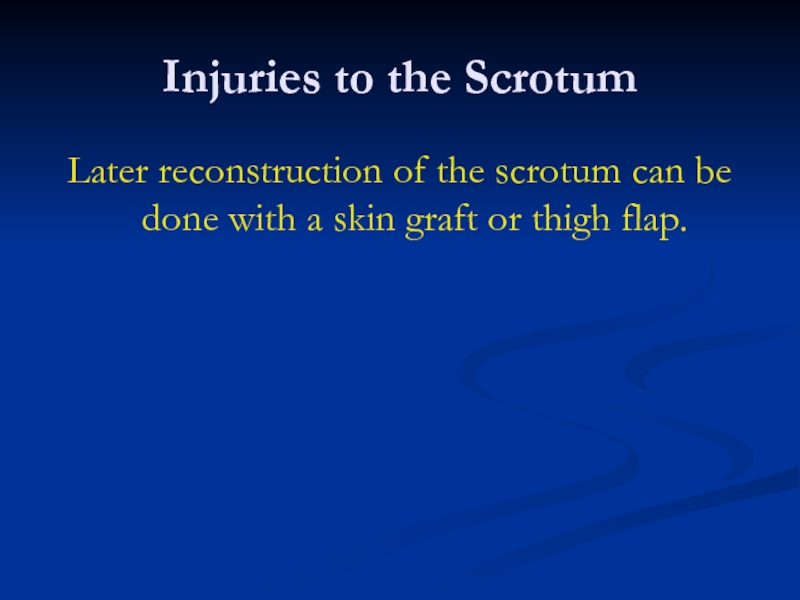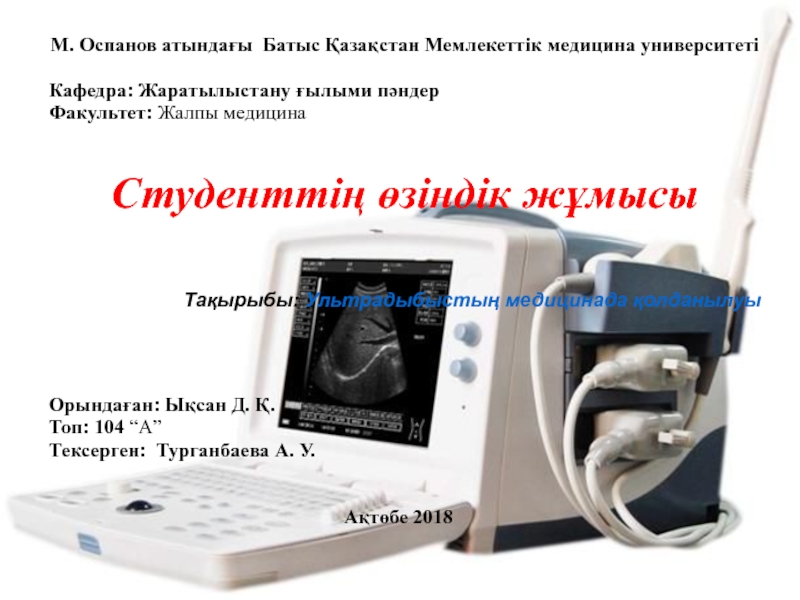- Главная
- Разное
- Дизайн
- Бизнес и предпринимательство
- Аналитика
- Образование
- Развлечения
- Красота и здоровье
- Финансы
- Государство
- Путешествия
- Спорт
- Недвижимость
- Армия
- Графика
- Культурология
- Еда и кулинария
- Лингвистика
- Английский язык
- Астрономия
- Алгебра
- Биология
- География
- Детские презентации
- Информатика
- История
- Литература
- Маркетинг
- Математика
- Медицина
- Менеджмент
- Музыка
- МХК
- Немецкий язык
- ОБЖ
- Обществознание
- Окружающий мир
- Педагогика
- Русский язык
- Технология
- Физика
- Философия
- Химия
- Шаблоны, картинки для презентаций
- Экология
- Экономика
- Юриспруденция
Injury of genitourinary organs презентация
Содержание
- 1. Injury of genitourinary organs
- 2. Emergency Diagnosis & Management About 10% of
- 3. Many of them are subtle and difficult
- 4. Emergency Diagnosis & Management Initial assessment should
- 5. Emergency Diagnosis & Management The history should
- 6. Emergency Diagnosis & Management The abdomen and
- 7. Fractures of the lower ribs are often
- 8. Patients who do not have life-threatening injuries
- 9. Emergency Diagnosis & Management When genitourinary tract
- 10. Assessment of Injury Assessment of the
- 11. Catheterization Blood at the urethral
- 12. Catheterization If no blood is present
- 13. Catheterization If catheterization is traumatic despite
- 14. Computed Tomography (CT) Abdominal CT with
- 15. Computed Tomography (CT) It can define the size extent of the retroperitoneal hematoma
- 16. Computed Tomography (CT) Spiral CT scanning, now
- 17. Retrograde Cystography Filling of the bladder
- 18. Retrograde Cystography A film should be obtained
- 19. Retrograde Cystography Cystography with CT is excellent for establishing bladder injury.
- 20. Urethrography A small (12F) catheter can
- 21. Urethrography After retrograde injection of
- 22. Arteriography Arteriography may help define renal parenchymal and renal vascular injuries.
- 23. Intravenous Urography Intravenous urography can be used to detect renal and ureteral injury.
- 24. Cystoscopy and Retrograde Urography Cystoscopy and
- 25. Abdominal Sonography Abdominal sonography has not
- 26. Injuries to the Kidney Renal injuries are
- 27. Injuries to the Kidney Most injuries occur
- 28. Injuries to the Kidney Etiology Blunt trauma
- 29. Injuries to the Kidney Vehicle collisions at
- 30. Injuries to the Kidney Associated abdominal visceral
- 31. Pathology & Classification Early Pathologic Findings
- 32. Pathology & Classification Early Pathologic Findings
- 33. Pathology & Classification Early Pathologic Findings
- 34. Pathology & Classification Hydronephrosis Follow-up
- 35. Pathology & Classification Arteriovenous Fistula
- 36. Pathology & Classification Renal Vascular
- 37. Clinical Findings & Indications for Studies Microscopic
- 38. Clinical Findings & Indications for Studies Some
- 39. Clinical Findings & Indications for Studies The
- 40. Clinical Findings & Indications for Studies Miller
- 41. Clinical Findings & Indications for Studies However,
- 42. Clinical Findings & Indications for Studies Symptoms
- 43. Clinical Findings & Indications for Studies Catheterization usually reveals hematuria.
- 44. Clinical Findings & Indications for Studies
- 45. Clinical Findings & Indications for Studies
- 46. Clinical Findings & Indications for Studies
- 47. Clinical Findings & Indications for Studies
- 48. Clinical Findings & Indications for Studies
- 49. Clinical Findings & Indications for Studies
- 50. Clinical Findings & Indications for Studies
- 51. Clinical Findings & Indications for Studies
- 52. Clinical Findings & Indications for Studies
- 53. Clinical Findings & Indications for Studies
- 54. Clinical Findings & Indications for Studies
- 55. Clinical Findings & Indications for Studies
- 56. Clinical Findings & Indications for Studies
- 57. Clinical Findings & Indications for Studies
- 58. Clinical Findings & Indications for Studies
- 59. Clinical Findings & Indications for Studies
- 60. Clinical Findings & Indications for Studies
- 61. Clinical Findings & Indications for Studies
- 62. Clinical Findings & Indications for Studies
- 63. Clinical Findings & Indications for Studies
- 64. Clinical Findings & Indications for Studies
- 65. Clinical Findings & Indications for Studies
- 66. Clinical Findings & Indications for Studies
- 67. Clinical Findings & Indications for Studies
- 68. Clinical Findings & Indications for Studies
- 69. Clinical Findings & Indications for Studies
- 70. Clinical Findings & Indications for Studies
- 71. Clinical Findings & Indications for Studies
- 72. Clinical Findings & Indications for Studies
- 73. Clinical Findings & Indications for Studies
- 74. Clinical Findings & Indications for Studies
- 75. Clinical Findings & Indications for Studies
- 76. Clinical Findings & Indications for Studies
- 77. Clinical Findings Symptoms If the ureter has
- 78. Clinical Findings Symptoms Ureteral injuries from external
- 79. Clinical Findings Symptoms Signs The acute hydronephrosis
- 80. Clinical Findings Symptoms Watery discharge from the
- 81. Laboratory Findings Ureteral injury from external
- 82. Imaging Findings Diagnosis is by excretory urography.
- 83. Imaging Findings Partial transection of the ureter
- 84. Imaging Findings In acute injury from external
- 85. Ultrasonography Ultrasonography outlines hydroureter or urinary
- 86. Radionuclide Scanning Radionuclide scanning demonstrates delayed
- 87. Differential Diagnosis Postoperative bowel obstruction and
- 88. Differential Diagnosis Deep wound infection must be
- 89. Differential Diagnosis Acute pyelonephritis in the early
- 90. Complications Ureteral injury may be complicated by
- 91. Treatment Prompt treatment of ureteral injuries
- 92. Treatment Proximal urinary drainage by percutaneous nephrostomy
- 93. Treatment The goals of ureteral repair are
- 94. Lower Ureteral Injuries Injuries to the lower
- 95. Lower Ureteral Injuries An antireflux procedure should be done when possible.
- 96. Lower Ureteral Injuries Transureteroureterostomy may be used
- 97. Midureteral Injuries Midureteral injuries usually result
- 98. Upper Ureteral Injuries Injuries to the
- 99. Stenting Most anastomoses after repair of ureteral injury should be stented.
- 100. Stenting After 3-4 weeks of healing,
- 101. Prognosis The prognosis for ureteral injury
- 102. Injuries to the Bladder Bladder injuries occur
- 103. Injuries to the Bladder Iatrogenic injury
- 104. Injuries to the Bladder Pathogenesis &
- 105. Injuries to the Bladder Pathogenesis & Pathology
- 106. Injuries to the Bladder Pathogenesis & Pathology
- 107. Injuries to the Bladder Clinical Findings
- 108. Injuries to the Bladder Symptoms
- 109. Injuries to the Bladder Signs Heavy
- 110. Injuries to the Bladder Signs An
- 111. Injuries to the Bladder Laboratory Findings
- 112. Injuries to the Bladder Laboratory Findings
- 113. Injuries to the Bladder X-Ray Findings
- 114. Injuries to the Bladder X-Ray Findings Bladder disruption is shown on cystography.
- 115. Injuries to the Bladder X-Ray Findings
- 116. Injuries to the Bladder X-Ray Findings
- 117. Injuries to the Bladder X-Ray Findings
- 118. Injuries to the Bladder Complications
- 119. Injuries to the Bladder Complications Partial
- 120. Injuries to the Bladder Treatment Emergency Measures Shock and hemorrhage should be treated.
- 121. Injuries to the Bladder Treatment Surgical
- 122. Injuries to the Bladder Treatment The
- 123. Injuries to the Bladder Treatment Extraperitoneal
- 124. Injuries to the Bladder Treatment As
- 125. Injuries to the Bladder Treatment Extraperitoneal
- 126. Injuries to the Bladder Treatment Intraperitoneal
- 127. Injuries to the Bladder Treatment The
- 128. Injuries to the Bladder Treatment Pelvic
- 129. Injuries to the Bladder Treatment Pelvic
- 130. Injuries to the Bladder Treatment If
- 131. Injuries to the Bladder Treatment Prognosis With appropriate treatment, the prognosis is excellent.
- 132. Injuries to the Bladder Treatment Patients
- 133. Injuries to the Urethra Urethral injuries
- 134. Injuries to the Urethra Various parts of
- 135. Injuries to the Posterior Urethra Etiology The
- 136. Injuries to the Posterior Urethra The urethra
- 137. Injuries to the Posterior Urethra Clinical
- 138. Injuries to the Posterior Urethra Clinical
- 139. Injuries to the Posterior Urethra Clinical
- 140. Injuries to the Posterior Urethra Clinical
- 141. Injuries to the Posterior Urethra Clinical
- 142. Injuries to the Posterior Urethra Clinical
- 143. Injuries to the Posterior Urethra X-Ray
- 144. Injuries to the Posterior Urethra X-Ray
- 145. Injuries to the Posterior Urethra Instrumental
- 146. Injuries to the Posterior Urethra Differential
- 147. Injuries to the Posterior Urethra Complications
- 148. Injuries to the Posterior Urethra Complications
- 149. Injuries to the Posterior Urethra Complications
- 150. Injuries to the Posterior Urethra Treatment Emergency Measures Shock and hemorrhage should be treated.
- 151. Injuries to the Posterior Urethra Treatment Surgical Measures Urethral catheterization should be avoided.
- 152. Injuries to the Posterior Urethra Treatment
- 153. Injuries to the Posterior Urethra Treatment
- 154. Injuries to the Posterior Urethra Treatment
- 155. Injuries to the Posterior Urethra Treatment
- 156. Injuries to the Posterior Urethra Treatment
- 157. Injuries to the Posterior Urethra Treatment
- 158. Injuries to the Posterior Urethra Treatment
- 159. Injuries to the Posterior Urethra Treatment
- 160. Injuries to the Posterior Urethra Treatment
- 161. Injuries to the Posterior Urethra Treatment
- 162. Injuries to the Posterior Urethra Treatment
- 163. Injuries to the Posterior Urethra Treatment
- 164. Injuries to the Posterior Urethra Treatment
- 165. Injuries to the Posterior Urethra Treatment
- 166. Injuries to the Posterior Urethra Treatment
- 167. Injuries to the Posterior Urethra Treatment
- 168. Injuries to the Anterior Urethra Etiology The
- 169. Injuries to the Anterior Urethra Pathogenesis
- 170. Injuries to the Anterior Urethra Pathogenesis
- 171. Injuries to the Anterior Urethra Clinical
- 172. Injuries to the Anterior Urethra Clinical
- 173. Injuries to the Anterior Urethra Clinical
- 174. Injuries to the Anterior Urethra Clinical
- 175. Injuries to the Anterior Urethra Clinical
- 176. Injuries to the Anterior Urethra Laboratory
- 177. Injuries to the Anterior Urethra X-Ray
- 178. Injuries to the Anterior Urethra Complications
- 179. Injuries to the Anterior Urethra Complications
- 180. Injuries to the Anterior Urethra Complications
- 181. Injuries to the Anterior Urethra Treatment
- 182. Injuries to the Anterior Urethra Treatment
- 183. Injuries to the Anterior Urethra Treatment
- 184. Injuries to the Anterior Urethra Treatment
- 185. Injuries to the Anterior Urethra Treatment
- 186. Injuries to the Anterior Urethra Treatment
- 187. Injuries to the Anterior Urethra Treatment
- 188. Injuries to the Anterior Urethra Treatment
- 189. Injuries to the Anterior Urethra Treatment
- 190. Injuries to the Penis Disruption of the
- 191. Injuries to the Penis Gangrene and urethral
- 192. Injuries to the Penis Injuries to the
- 193. Injuries to the Scrotum Superficial lacerations
- 194. Injuries to the Scrotum Total avulsion of
- 195. Injuries to the Scrotum Later reconstruction of
- 196. Тhank you for your attention!!!
Слайд 2Emergency Diagnosis & Management
About 10% of all injuries seen in the
emergency room involve the genitourinary system to some extent.
Слайд 3Many of them are subtle and difficult to define and require
great diagnostic expertise.
Early diagnosis is essential to prevent serious complications.
Early diagnosis is essential to prevent serious complications.
Emergency Diagnosis & Management
Слайд 4Emergency Diagnosis & Management
Initial assessment should include control of hemorrhage and
shock along with resuscitation as required.
Слайд 5Emergency Diagnosis & Management
The history should include a detailed description of
the accident. In cases involving gunshot wounds, the type and caliber of the weapon should be determined, since high-velocity projectiles cause much more extensive damage.
Слайд 6Emergency Diagnosis & Management
The abdomen and genitalia should be examined for
evidence of contusions or subcutaneous hematomas, which might indicate deeper injuries to the retroperitoneum and pelvic structures.
Слайд 7Fractures of the lower ribs are often associated with renal injuries,
and pelvic fractures often accompany bladder and urethral injuries.
Emergency Diagnosis & Management
Слайд 8Patients who do not have life-threatening injuries and whose blood pressure
is stable can undergo more deliberate radiographic studies.
Emergency Diagnosis & Management
Слайд 9Emergency Diagnosis & Management
When genitourinary tract injury is suspected on the
basis of the history and physical examination, additional studies are required to establish its extent.
Слайд 10Assessment of Injury
Assessment of the injury should be done in
an orderly fashion so that accurate and complete information is obtained.
Слайд 11Catheterization
Blood at the urethral meatus in men indicates urethral injury;
catheterization should not be attempted if blood is present, but retrograde urethrography should be done immediately.
Слайд 12Catheterization
If no blood is present at the meatus, a urethral catheter
can be carefully passed to the bladder to recover urine; microscopic or gross hematuria indicates urinary system injury.
Слайд 13Catheterization
If catheterization is traumatic despite the greatest care, the significance of
hematuria cannot be determined, and other studies must be done to investigate the possibility of urinary system injury.
Слайд 14Computed Tomography (CT)
Abdominal CT with contrast media is the best imaging
study to detect and stage renal and retroperitoneal injuries.
Слайд 16Computed Tomography (CT)
Spiral CT scanning, now common, is very rapid, but
it may not detect renal parenchymal lacerations, urinary extravasation, or ureteral and renal pelvic injuries.
Слайд 17Retrograde Cystography
Filling of the bladder with contrast material is essential to
establish whether bladder perforations exist.
Слайд 18Retrograde Cystography
A film should be obtained with the bladder filled and
a second one after the bladder has emptied itself by gravity drainage.
Слайд 20Urethrography
A small (12F) catheter can be inserted into the urethral meatus
and 3 mL of water placed in the balloon to hold the catheter in position.
Слайд 21Urethrography
After retrograde injection of 20 mL of water-soluble contrast
material, the urethra will be clearly outlined on film, and extravasation in the deep bulbar area in case of straddle injury or free extravasation into the retropubic space in case of prostatomembranous disruption will be visualized.
Слайд 24Cystoscopy and Retrograde Urography
Cystoscopy and retrograde urography may be useful to
detect ureteral injury, but are seldom necessary, since information can be obtained by less invasive techniques.
Слайд 25Abdominal Sonography
Abdominal sonography has not been shown to add substantial information
during initial evaluation of severe abdominal trauma.
Слайд 27Injuries to the Kidney
Most injuries occur from automobile accidents or sporting
mishaps, chiefly in men and boys..
Слайд 28Injuries to the Kidney
Etiology
Blunt trauma directly to the abdomen, flank, or
back is the most common mechanism, accounting for 80-85% of all renal injuries.
Слайд 29Injuries to the Kidney
Vehicle collisions at high speed may result in
major renal trauma from rapid deceleration and cause major vascular injury.
Слайд 30Injuries to the Kidney
Associated abdominal visceral injuries are present in 80%
of renal penetrating wounds.
Слайд 31Pathology & Classification
Early Pathologic Findings
Lacerations from blunt trauma usually occur
in the transverse plane of the kidney.
Слайд 32Pathology & Classification
Early Pathologic Findings
In injuries from rapid deceleration, the
kidney moves upward or downward, causing sudden stretch on the renal pedicle and sometimes complete or partial avulsion.
Слайд 33Pathology & Classification
Early Pathologic Findings
Acute thrombosis of the renal artery
may be caused by an intimal tear from rapid deceleration injuries owing to the sudden stretch.
Слайд 34Pathology & Classification
Hydronephrosis
Follow-up excretory urography is indicated in all
cases of major renal trauma.
Слайд 35Pathology & Classification
Arteriovenous Fistula
Arteriovenous fistulas may occur after penetrating
injuries but are not common
Слайд 36Pathology & Classification
Renal Vascular Hypertension
The blood flow in tissue
rendered nonviable by injury is compromised; this results in renal vascular hypertension in less than 1% of cases.
Слайд 37Clinical Findings & Indications for Studies
Microscopic or gross hematuria following trauma
to the abdomen indicates injury to the urinary tract.
Слайд 38Clinical Findings & Indications for Studies
Some cases of renal vascular injury
are not associated with hematuria.
Слайд 39Clinical Findings & Indications for Studies
The degree of renal injury does
not correspond to the degree of hematuria, since gross hematuria may occur in minor renal trauma and only mild hematuria in major trauma
Слайд 40Clinical Findings & Indications for Studies
Miller and McAninch (1995) made the
following recommendations based on findings in over 1800 blunt renal trauma injuries.
Слайд 41Clinical Findings & Indications for Studies
However, should physical examination or associated
injuries prompt reasonable suspicion of a renal injury, renal imaging should be undertaken.
Слайд 42Clinical Findings & Indications for Studies
Symptoms
There is usually visible evidence of
abdominal trauma. Pain may be localized to one flank area or over the abdomen.
Слайд 44Clinical Findings & Indications for Studies
Signs
Initially, shock or signs of
a large loss of blood from heavy retroperitoneal bleeding may be noted.
Слайд 45Clinical Findings & Indications for Studies
Signs
Diffuse abdominal tenderness may be
found on palpation; an "acute abdomen" usually indicates free blood in the peritoneal cavity. A palpable mass may represent a large retroperitoneal hematoma or perhaps urinary extravasation.
Слайд 46Clinical Findings & Indications for Studies
Signs
The abdomen may be distended
and bowel sounds absent.
Слайд 47Clinical Findings & Indications for Studies
Laboratory Findings
Microscopic or gross hematuria
is usually present.
Слайд 48Clinical Findings & Indications for Studies
Staging and X-Ray Findings
Staging of
renal injuries allows a systematic approach to these problems.
Слайд 49Clinical Findings & Indications for Studies
Staging and X-Ray Findings
For example,
blunt trauma to the abdomen associated with gross hematuria and a normal urogram requires no additional renal studies; however, nonvisualization of the kidney requires immediate arteriography or CT scan to determine whether renal vascular injury exists.
Слайд 50Clinical Findings & Indications for Studies
Staging and X-Ray Findings
Ultrasonography and
retrograde urography are of little use initially in the evaluation of renal injuries.
Слайд 51Clinical Findings & Indications for Studies
Staging and X-Ray Findings
Staging begins
with an abdominal CT scan, the most direct and effective means of staging renal injuries.
Слайд 52Clinical Findings & Indications for Studies
Staging and X-Ray Findings
This noninvasive
technique clearly
defines parenchymal lacerations and urinary extravasation,
defines parenchymal lacerations and urinary extravasation,
Слайд 53Clinical Findings & Indications for Studies
Staging and X-Ray Findings
Arteriography defines
major arterial and parenchymal injuries when previous studies have not fully done so.
Слайд 54Clinical Findings & Indications for Studies
Staging and X-Ray Findings
The major
causes of nonvisualization on an excretory urogram are total pedicle avulsion, arterial thrombosis, severe contusion causing vascular spasm, and absence of the kidney (either congenital or from operation).
Слайд 55Clinical Findings & Indications for Studies
Staging and X-Ray Findings
Radionuclide renal
scans have been used in staging renal trauma.
Слайд 56Clinical Findings & Indications for Studies
Differential Diagnosis
Trauma to the abdomen
and flank areas is not always associated with renal injury.
Слайд 57Clinical Findings & Indications for Studies
Complications
Early Complications
Hemorrhage is perhaps the
most important immediate complication of renal injury.
Слайд 58Clinical Findings & Indications for Studies
Complications
The size and expansion of
palpable masses must be carefully monitored.
Слайд 59Clinical Findings & Indications for Studies
Complications
Urinary extravasation from renal fracture
may show as an expanding mass (urinoma) in the retroperitoneum.
Слайд 60Clinical Findings & Indications for Studies
Complications
A resolving retroperitoneal hematoma may
cause slight fever (38.3 °C), but higher temperatures suggest infection.
Слайд 61Clinical Findings & Indications for Studies
Complications
Late Complications
Hypertension, hydronephrosis, arteriovenous fistula,
calculus formation, and pyelonephritis are important late complications.
Слайд 62Clinical Findings & Indications for Studies
Complications
Heavy late bleeding may occur
4 weeks after injury.
Слайд 63Clinical Findings & Indications for Studies
Treatment: Emergency Measures
The objectives of
early management are prompt treatment of shock and hemorrhage, complete resuscitation, and evaluation of associated injuries.
Слайд 64Clinical Findings & Indications for Studies
Treatment: Surgical Measures
Blunt Injuries
Bleeding stops
spontaneously with bed rest and hydration.
Слайд 65Clinical Findings & Indications for Studies
Treatment: Surgical Measures
Cases in which
operation is indicated include those associated with persistent retroperitoneal bleeding, urinary extravasation, evidence of nonviable renal parenchyma, and renal pedicle injuries (less than 5% of all renal injuries). Aggressive preoperative staging allows complete definition of injury before operation.
Слайд 66Clinical Findings & Indications for Studies
Treatment: Surgical Measures
Penetrating Injuries
Penetrating injuries
should be surgically explored.
Слайд 67Clinical Findings & Indications for Studies
Treatment: Surgical Measures
In 80% of
cases of penetrating injury, associated organ injury requires operation; thus, renal exploration is only an extension of this procedure.
Слайд 68Clinical Findings & Indications for Studies
Treatment: Surgical Measures
Treatment of Complications
Hydronephrosis
may require surgical correction or nephrectomy.
Слайд 69Clinical Findings & Indications for Studies
Treatment: Surgical Measures
Prognosis
With careful follow-up,
most renal injuries have an excellent prognosis, with spontaneous healing and return of renal function.
Слайд 70Clinical Findings & Indications for Studies
Treatment: Surgical Measures
Injuries to the
Ureter
Ureteral injury is rare but may occur, usually during the course of a difficult pelvic surgical procedure or as a result of gunshot wounds.
Ureteral injury is rare but may occur, usually during the course of a difficult pelvic surgical procedure or as a result of gunshot wounds.
Слайд 71Clinical Findings & Indications for Studies
Treatment: Surgical Measures
Etiology
Large pelvic masses
(benign or malignant) may displace the ureter laterally and engulf it in reactive fibrosis.
Слайд 72Clinical Findings & Indications for Studies
Treatment: Surgical Measures
Extensive carcinoma of
the colon may invade areas outside the colon wall and directly involve the ureter; thus, resection of the ureter may be required along with resection of the tumor mass.
Слайд 73Clinical Findings & Indications for Studies
Treatment: Surgical Measures
Devascularization may occur
with extensive pelvic lymph node dissections or after radiation therapy to the pelvis for pelvic cancer.
Слайд 74Clinical Findings & Indications for Studies
Treatment: Surgical Measures
Endoscopic manipulation of
a ureteral calculus with a stone basket or ureteroscope may result in ureteral perforation or avulsion.
Слайд 75Clinical Findings & Indications for Studies
Treatment: Surgical Measures
Pathogenesis & Pathology
The
ureter may be inadvertently ligated and cut during difficult pelvic surgery.
Слайд 76Clinical Findings & Indications for Studies
Treatment: Surgical Measures
Intraperitoneal extravasation of
urine can also occur, causing ileus and peritonitis.
Слайд 77Clinical Findings
Symptoms
If the ureter has been completely or partially ligated during
operation, the postoperative course is usually marked by fever of 38.3-38.8 °C as well as flank and lower quadrant pain.
Слайд 78Clinical Findings
Symptoms
Ureteral injuries from external violence should be suspected in patients
who have sustained stab or gunshot wounds to the retroperitoneum.
Слайд 79Clinical Findings
Symptoms
Signs
The acute hydronephrosis of a totally ligated ureter results in
severe flank pain and abdominal pain with nausea and vomiting early in the postoperative course and with associated ileus. Signs and symptoms of acute peritonitis may be present if there is urinary extravasation into the peritoneal cavity.
Слайд 80Clinical Findings
Symptoms
Watery discharge from the wound or vagina may be identified
as urine by determining the creatinine concentration of a small urine has many times the creatinine concentration found in serum and by intravenous injection of 10 mL of indigo carmine, which will appear in the urine as dark blue.
Слайд 81Laboratory Findings
Ureteral injury from external violence is manifested by microscopic hematuria
in 90% of cases.
Слайд 83Imaging Findings
Partial transection of the ureter results in more rapid excretion,
but persistent hydronephrosis is usually present, and contrast extravasation at the site of injury is noted on delayed films.
Слайд 84Imaging Findings
In acute injury from external violence, the excretory urogram usually
appears normal, with very mild fullness down to the point of extravasation at the ureteral transection.
Retrograde ureterography demonstrates the exact site of obstruction or extravasation.
Retrograde ureterography demonstrates the exact site of obstruction or extravasation.
Слайд 85Ultrasonography
Ultrasonography outlines hydroureter or urinary extravasation as it develops into a
urinoma and is perhaps the best means of ruling out ureteral injury in the early postoperative period.
Слайд 86Radionuclide Scanning
Radionuclide scanning demonstrates delayed excretion on the injured side, with
evidence of increasing counts owing to accumulation of urine in the renal pelvis.
Слайд 87Differential Diagnosis
Postoperative bowel obstruction and peritonitis may cause symptoms similar to
those of acute ureteral obstruction from injury.
Слайд 88Differential Diagnosis
Deep wound infection must be considered postoperatively in patients with
fever, ileus, and localized tenderness.
Слайд 89Differential Diagnosis
Acute pyelonephritis in the early postoperative period may also result
in findings similar to those of ureteral injury.
Слайд 90Complications
Ureteral injury may be complicated by stricture formation with resulting hydronephrosis
in the area of injury.
Слайд 91Treatment
Prompt treatment of ureteral injuries is required. The best opportunity for
successful repair is in the operating room when the injury occurs.
Слайд 92Treatment
Proximal urinary drainage by percutaneous nephrostomy or formal nephrostomy should be
considered if the injury is recognized late or if the patient has significant complications that make immediate reconstruction unsatisfactory.
Слайд 93Treatment
The goals of ureteral repair are to achieve complete debridement, a
tension-free spatulated anastomosis, watertight closure, ureteral stenting (in selected cases), and retroperitoneal drainage.
Слайд 94Lower Ureteral Injuries
Injuries to the lower third of the ureter allow
several options in management.
Слайд 96Lower Ureteral Injuries
Transureteroureterostomy may be used in lower-third injuries if extensive
urinoma and pelvic infection have developed.
Слайд 97Midureteral Injuries
Midureteral injuries usually result from external violence and are best
repaired by primary ureteroureterostomy or transureteroureterostomy.
Слайд 98Upper Ureteral Injuries
Injuries to the upper third of the ureter are
best managed by primary ureteroureterostomy.
Слайд 100Stenting
After 3-4 weeks of healing, stents can be endoscopically removed from
the bladder.
Слайд 101Prognosis
The prognosis for ureteral injury is excellent if the diagnosis is
made early and prompt corrective surgery is done.
Слайд 102Injuries to the Bladder
Bladder injuries occur most often from external force
and are often associated with pelvic fractures.
Слайд 103Injuries to the Bladder
Iatrogenic injury may result from gynecologic and other
extensive pelvic procedures as well as from hernia repairs and transurethral operations.
Слайд 104
Injuries to the Bladder
Pathogenesis & Pathology
The bony pelvis protects the urinary
bladder very well. When the pelvis is fractured by blunt trauma, fragments from the fracture site may perforate the bladder .
Слайд 105Injuries to the Bladder
Pathogenesis & Pathology
When the bladder is filled to
near capacity, a direct blow to the lower abdomen may result in bladder disruption.
Слайд 106Injuries to the Bladder
Pathogenesis & Pathology
If the diagnosis is not established
immediately and if the urine is sterile, no symptoms may be noted for several days.
Слайд 107Injuries to the Bladder
Clinical Findings
Pelvic fracture accompanies bladder rupture in
90% of cases.
Слайд 109Injuries to the Bladder
Signs
Heavy bleeding associated with pelvic fracture may
result in hemorrhagic shock, usually from venous disruption of pelvic vessels.
Слайд 110Injuries to the Bladder
Signs
An acute abdomen may occur with intraperitoneal
bladder rupture.
Слайд 111Injuries to the Bladder
Laboratory Findings
Catheterization usually is required in patients
with pelvic trauma but not if bloody urethral discharge is noted.
Слайд 112Injuries to the Bladder
Laboratory Findings
When catheterization is done, gross or,
less commonly, microscopic hematuria is usually present.
Слайд 113Injuries to the Bladder
X-Ray Findings
A plain abdominal film generally demonstrates
pelvic fractures.
Слайд 115Injuries to the Bladder
X-Ray Findings
The drainage film is extremely important,
because it demonstrates areas of extraperitoneal extravasation of blood and urine that may not appear on the filling film.
Слайд 116Injuries to the Bladder
X-Ray Findings
CT cystography is an excellent method
for detecting bladder rupture; however, retrograde filling of the bladder with 300 mL of contrast medium is necessary to distend the bladder completely.
Слайд 117Injuries to the Bladder
X-Ray Findings
Incomplete distention with consequent missed diagnosis
of bladder rupture often occurs when the urethral catheter is clamped during standard abdominal CT scan with intravenous contrast injection.
Слайд 118Injuries to the Bladder
Complications
A pelvic abscess may develop from extraperitoneal
bladder rupture; if the urine becomes infected, the pelvic hematoma becomes infected too.
Слайд 119Injuries to the Bladder
Complications
Partial incontinence may result from bladder injury
when the laceration extends into the bladder neck.
Слайд 121Injuries to the Bladder
Treatment
Surgical Measures
A lower midline abdominal incision should
be made.
Слайд 122Injuries to the Bladder
Treatment
The bladder should be opened in the
midline and carefully inspected.
Слайд 123Injuries to the Bladder
Treatment
Extraperitoneal Bladder Rupture
Extraperitoneal bladder rupture can be
successfully managed with urethral catheter drainage only.
Слайд 124Injuries to the Bladder
Treatment
As the bladder is opened in the
midline, it should be carefully inspected and lacerations closed from within.
Слайд 125Injuries to the Bladder
Treatment
Extraperitoneal bladder lacerations occasionally extend into the
bladder neck and should be repaired meticulously
Слайд 126Injuries to the Bladder
Treatment
Intraperitoneal Rupture
Intraperitoneal bladder ruptures should be repaired
via a transperitoneal approach after careful transvesical inspection and closure of any other perforations. The peritoneum must be closed carefully over the area of injury.
Слайд 127Injuries to the Bladder
Treatment
The bladder is then closed in separate
layers by absorbable suture.
Слайд 128Injuries to the Bladder
Treatment
Pelvic Fracture
Stable fracture of the pubic rami
is usually present.
Слайд 129Injuries to the Bladder
Treatment
Pelvic Hematoma
There may be heavy uncontrolled bleeding
from rupture of pelvic vessels even if the hematoma has not been entered at operation.
Слайд 130Injuries to the Bladder
Treatment
If bleeding persists, it may be necessary
to leave the tapes in place for 24 h and operate again to remove them.
Слайд 131Injuries to the Bladder
Treatment
Prognosis
With appropriate treatment, the prognosis is excellent.
Слайд 132Injuries to the Bladder
Treatment
Patients with lacerations extending into the bladder
neck area may be temporarily incontinent, but full control is usually regained.
Слайд 133Injuries to the Urethra
Urethral injuries are uncommon and occur most often
in men, usually associated with pelvic fractures or straddle-type falls. They are rare in women.
Слайд 134Injuries to the Urethra
Various parts of the urethra may be lacerated,
transected, or contused.
Слайд 135Injuries to the Posterior Urethra
Etiology
The membranous urethra passes through the pelvic
floor and voluntary urinary sphincter and is the portion of the posterior urethra most likely to be injured.
Слайд 136Injuries to the Posterior Urethra
The urethra can be transected by the
same mechanism at the interior surface of the membranous urethra.
Слайд 137Injuries to the Posterior Urethra
Clinical Findings
Symptoms
Patients usually complain of lower
abdominal pain and inability to urinate.
Слайд 138Injuries to the Posterior Urethra
Clinical Findings
Signs
Blood at the urethral meatus
is the single most important sign of urethral injury.
Слайд 139Injuries to the Posterior Urethra
Clinical Findings
The presence of blood at
the external urethral meatus indicates that immediate urethrography is necessary to establish the diagnosis.
Слайд 140Injuries to the Posterior Urethra
Clinical Findings
Suprapubic tenderness and the presence
of pelvic fracture are noted on physical examination.
Слайд 141Injuries to the Posterior Urethra
Clinical Findings
Rectal examination may reveal a
large pelvic hematoma with the prostate displaced superiorly.
Слайд 142Injuries to the Posterior Urethra
Clinical Findings
Superior displacement of the prostate
does not occur if the puboprostatic ligaments remain intact.
Слайд 143Injuries to the Posterior Urethra
X-Ray Findings
Fractures of the bony pelvis
are usually present. A urethrogram (using 20-30 mL of water-soluble contrast material) shows the site of extravasation at the prostatomembranous junction.
Слайд 144Injuries to the Posterior Urethra
X-Ray Findings
Ordinarily, there is free extravasation
of contrast material into the perivesical space.
Слайд 145Injuries to the Posterior Urethra
Instrumental Examination
The only instrumentation involved should
be for urethrography.
Слайд 146Injuries to the Posterior Urethra
Differential Diagnosis
Bladder rupture may be associated
with posterior urethral injuries in approximately 20% of cases.
Слайд 147Injuries to the Posterior Urethra
Complications
Stricture, impotence, and incontinence as complications
of prostatomembranous disruption are among the most severe and debilitating mishaps that result from trauma to the urinary system.
Слайд 148Injuries to the Posterior Urethra
Complications
Stricture following primary repair and anastomosis
occurs in about 50% of cases.
Слайд 149Injuries to the Posterior Urethra
Complications
The incidence of impotence after primary
repair is 30-80% (mean, about 50%).
Слайд 150Injuries to the Posterior Urethra
Treatment
Emergency Measures
Shock and hemorrhage should be
treated.
Слайд 151Injuries to the Posterior Urethra
Treatment
Surgical Measures
Urethral catheterization should be avoided.
Слайд 152Injuries to the Posterior Urethra
Treatment
Immediate Management
Initial management should consist of
suprapubic cystostomy to provide urinary drainage.
Слайд 153Injuries to the Posterior Urethra
Treatment
The bladder often is distended by
a large volume of urine accumulated during the period of resuscitation and operative preparation.
Слайд 154Injuries to the Posterior Urethra
Treatment
The bladder should be opened in
the midline and carefully inspected for lacerations.
Слайд 155Injuries to the Posterior Urethra
Treatment
This approach involves no urethral instrumentation
or manipulation.
Слайд 156Injuries to the Posterior Urethra
Treatment
Incomplete laceration of the posterior urethra
heals spontaneously, and the suprapubic cystostomy can be removed within 2-3 weeks.
Слайд 157Injuries to the Posterior Urethra
Treatment
Delayed Urethral Reconstruction
Reconstruction of the urethra
after prostatic disruption can be undertaken within 3 months, assuming there is no pelvic abscess or other evidence of persistent pelvic infection
Слайд 158Injuries to the Posterior Urethra
Treatment
This stricture usually is 1 -2
cm long and situated immediately posterior to the pubic bone.
Слайд 159Injuries to the Posterior Urethra
Treatment
A 16F silicone urethral catheter should
be left in place along with a suprapubic cystostomy.
Слайд 160Injuries to the Posterior Urethra
Treatment
Immediate Urethral Realignment
Some surgeons prefer to
realign the urethra immediately.
Слайд 161Injuries to the Posterior Urethra
Treatment
General Measures
After delayed reconstruction by a
perineal approach, patients are allowed ambulation on the first postoperative day and usually can be discharged within 3 days.
Слайд 162Injuries to the Posterior Urethra
Treatment
Treatment of Complications
Approximately 1
month after the delayed reconstruction, the urethral catheter can be removed and a voiding cystogram obtained through the suprapubic cystostomy tube.
Слайд 163Injuries to the Posterior Urethra
Treatment
If the cystogram shows a patent
area of reconstruction free of extravasation, the suprapubic catheter can be removed; if there is extravasation or stricture, suprapubic cystostomy should be maintained.
Слайд 164Injuries to the Posterior Urethra
Treatment
Stricture, if present (< 5%), is
usually very short, and urethrotomy under direct vision offers easy and rapid cure.
Слайд 165Injuries to the Posterior Urethra
Treatment
The patient may be impotent for
several months after delayed repair.
Слайд 166Injuries to the Posterior Urethra
Treatment
Incontinence after posterior urethral rupture and
delayed repair is rare (< 2%) and is usually related to the extent of injury rather than to the repair.
Слайд 167Injuries to the Posterior Urethra
Treatment
Prognosis
If complications can be avoided, the
prognosis is excellent.
Слайд 168Injuries to the Anterior Urethra
Etiology
The anterior urethra is the portion distal
to the urogenital diaphragm.
Слайд 169Injuries to the Anterior Urethra
Pathogenesis & Pathology
Contusion
Contusion of the
urethra is a sign of crush injury without urethral disruption.
Слайд 170Injuries to the Anterior Urethra
Pathogenesis & Pathology
Laceration
A severe straddle
injury may result in laceration of part of the urethral wall, allowing extravasation of urine.
Слайд 171Injuries to the Anterior Urethra
Clinical Findings
Symptoms
There is usually a history
of a fall, and in some cases a history of instrumentation. Bleeding from the urethra is usually present
Слайд 172Injuries to the Anterior Urethra
Clinical Findings
If voiding has occurred and
extravasation is noted, sudden swelling in the area will be present. If diagnosis has been delayed, sepsis and severe infection may be present.
Слайд 173Injuries to the Anterior Urethra
Clinical Findings
Signs
The perineum is very tender,
and a mass may be found. Rectal examination reveals a normal prostate. The patient usually has a desire to void, but voiding should not be allowed until assessment of the urethra is complete.
Слайд 174Injuries to the Anterior Urethra
Clinical Findings
No attempt should be made
to pass a urethral catheter, but if the patient's bladder is overdistended, percutaneous suprapubic cystostomy can be done as a temporary procedure.
Слайд 175Injuries to the Anterior Urethra
Clinical Findings
When presentation of such injuries
is delayed, there is massive urinary extravasation and infection in the perineum and the scrotum.
Слайд 176Injuries to the Anterior Urethra
Laboratory Findings
Blood loss is not usually
excessive, particularly if secondary injury has occurred.
Слайд 177Injuries to the Anterior Urethra
X-Ray Findings
A contused urethra shows no
evidence of extravasation.
Слайд 178Injuries to the Anterior Urethra
Complications
Heavy bleeding from the corpus spongiosum
injury may occur in the perineum as well as through the urethral meatus.
Слайд 179Injuries to the Anterior Urethra
Complications
The complications of urinary extravasation are
chiefly sepsis and infection.
Слайд 180Injuries to the Anterior Urethra
Complications
Stricture at the site of injury
is a common complication, but surgical reconstruction may not be required unless the stricture significantly reduces urinary flow rates.
Слайд 181Injuries to the Anterior Urethra
Treatment
General Measures
Major blood loss usually does
not occur from straddle injury.
Слайд 182Injuries to the Anterior Urethra
Treatment
Specific Measures: Urethral Contusion
The patient with
urethral contusion shows no evidence of extravasation, and the urethra remains intact.
Слайд 183Injuries to the Anterior Urethra
Treatment
Urethral Lacerations
Instrumentation of the urethra following
urethrography should be avoided.
Слайд 184Injuries to the Anterior Urethra
Treatment
If only minor extravasation is noted
on the urethrogram, a voiding study can be performed within 7 days after suprapubic catheter drainage to search for extravasation.
Слайд 185Injuries to the Anterior Urethra
Treatment
Most of these strictures are not
severe and do not require surgical reconstruction
Слайд 186Injuries to the Anterior Urethra
Treatment
Urethral Laceration with Extensive Urinary Extravasation
After
major laceration, urinary extravasation may involve the perineum, scrotum, and lower abdomen.
Слайд 187Injuries to the Anterior Urethra
Treatment
Immediate Repair
Immediate repair of urethral lacerations
can be performed, but the procedure is difficult and the incidence of associated stricture is high
Слайд 188Injuries to the Anterior Urethra
Treatment
Treatment of Complications
Strictures at the site
of injury may be extensive and require delayed reconstruction.
Слайд 189Injuries to the Anterior Urethra
Treatment
Prognosis
Urethral stricture is a major complication
but in most cases does not require surgical reconstruction.
Слайд 190Injuries to the Penis
Disruption of the tunica albuginea of the penis
(penile fracture) can occur during sexual intercourse.
Слайд 191Injuries to the Penis
Gangrene and urethral injury may be caused by
obstructing rings placed around the base of the penis
Слайд 192Injuries to the Penis
Injuries to the penis should suggest possible urethral
damage, which should be investigated by urethrography.
Слайд 193Injuries to the Scrotum
Superficial lacerations of the scrotum may be debrided
and closed primarily. Blunt trauma may cause local hematoma and ecchymosis, but these injuries resolve without difficulty. One must be certain that testicular rupture has not occurred.
Слайд 194Injuries to the Scrotum
Total avulsion of the scrotal skin may be
caused by machinery accidents or other major trauma. The testes and spermatic cords are usually intact.
Слайд 195Injuries to the Scrotum
Later reconstruction of the scrotum can be done
with a skin graft or thigh flap.



